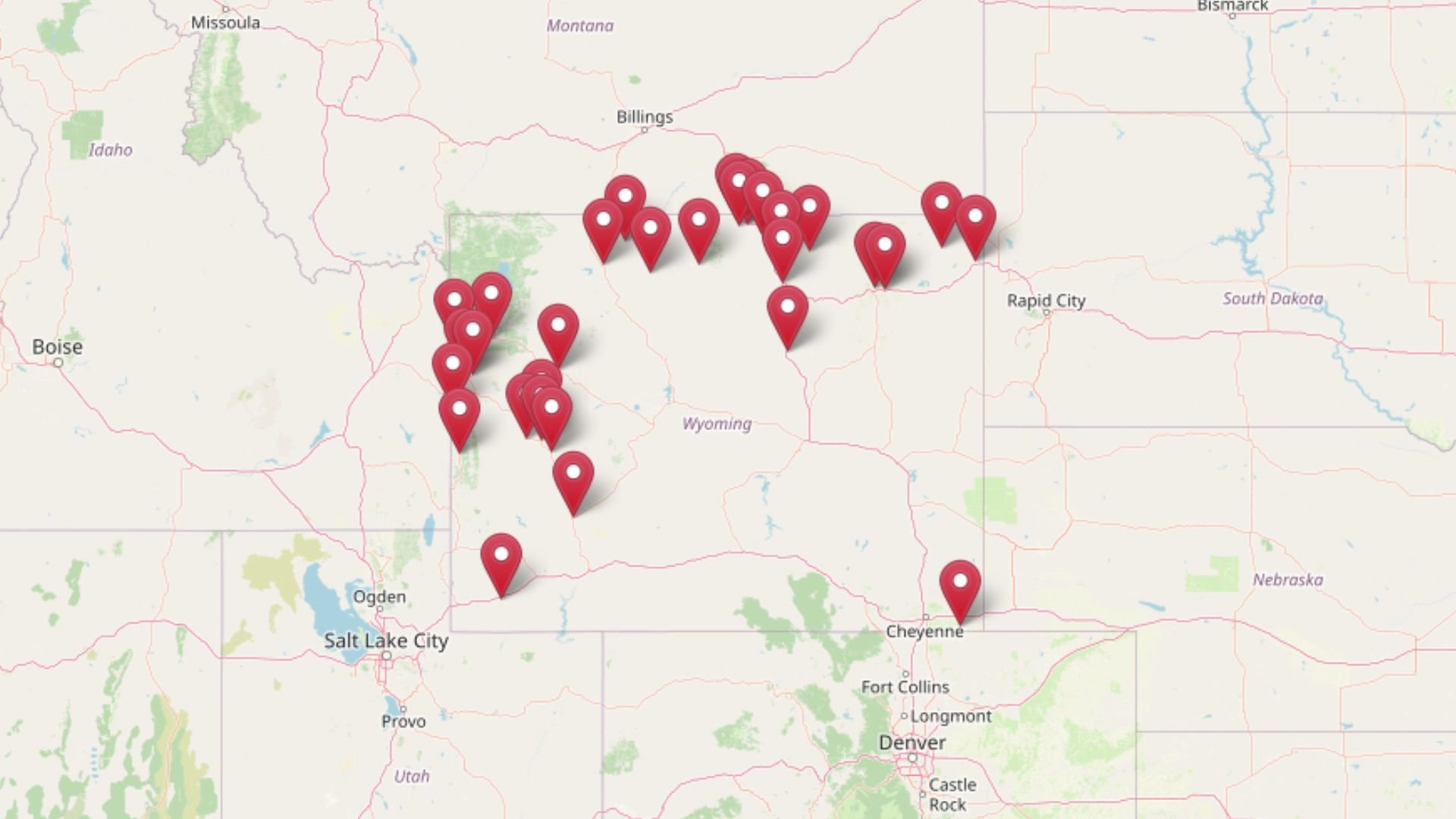
Using the latest Zillow Home Value Index data, we’ve ranked the 30 most expensive towns in Wyoming based on current home prices. These communities represent more than just high price tags—they showcase areas where outdoor recreation, tourism, and quality of life drive sustained demand.
From luxury ski resort enclaves near Jackson Hole to historic western towns outside Yellowstone, each location tells a story of growth fueled by natural beauty and recreational opportunities. Whether you’re considering a move, tracking investment potential, or simply curious about Wyoming’s housing patterns, these rankings reveal where prices have climbed highest and why buyers continue paying premium rates.
30. Hulett – 91% Home Price Increase Since 2016

- 2010: N/A
- 2011: N/A
- 2012: N/A
- 2013: N/A
- 2014: N/A
- 2015: N/A
- 2016: $208,476
- 2017: $208,801
- 2018: $216,703
- 2019: $220,663
- 2020: $233,866
- 2021: $276,522
- 2022: $344,378
- 2023: $339,065
- 2024: $356,978
- 2025: $397,311
Hulett has experienced remarkable growth since data became available in 2016, nearly doubling in value. The sharpest increases occurred between 2021 and 2022, jumping from $276,522 to $344,378. Current median home prices now sit at $397,311, reflecting strong and consistent upward momentum in this northeast Wyoming community.
Why Hulett?
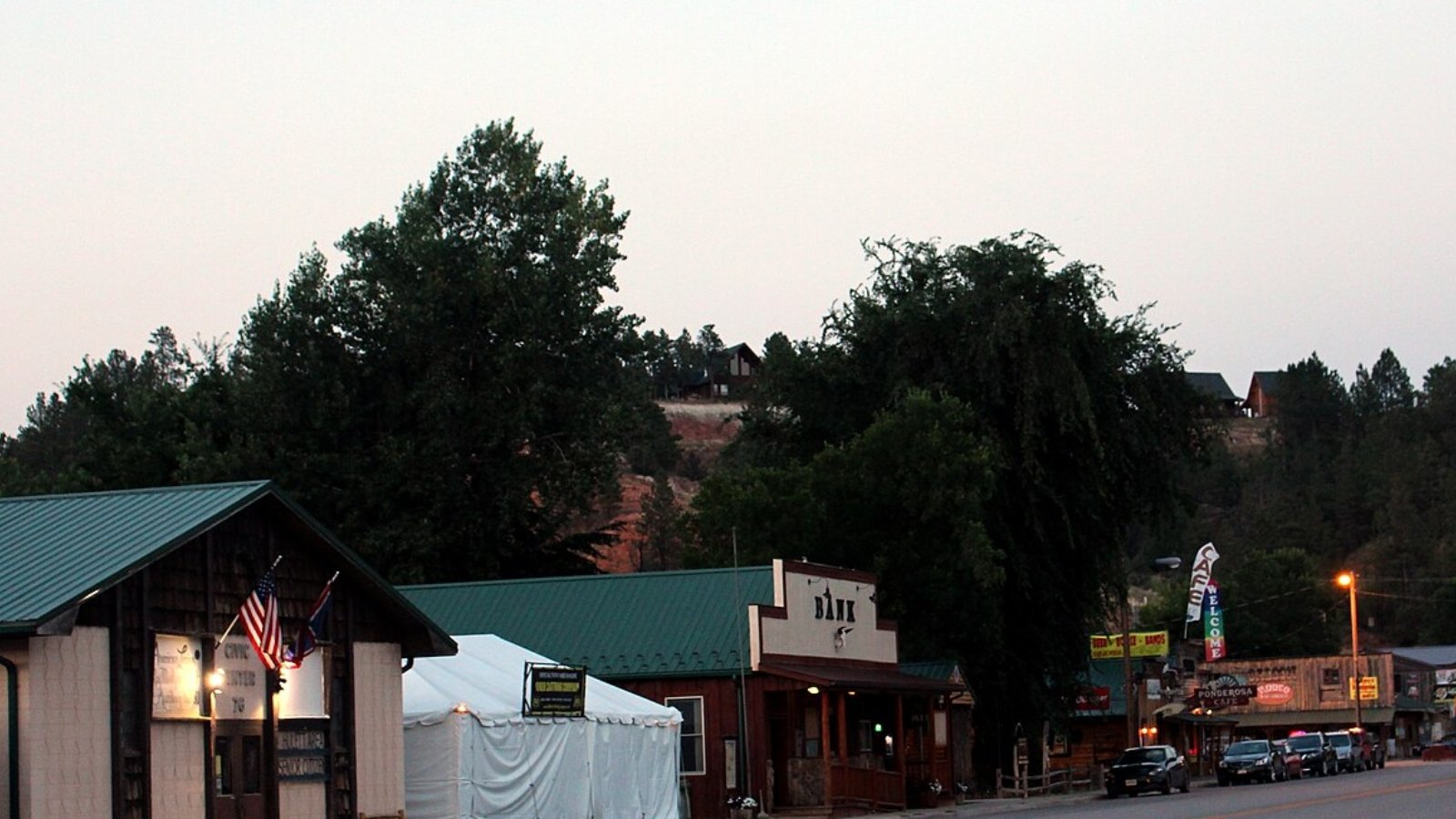
Why are people willing to pay so much to live here? What’s special about it?
Hulett sits at the base of Devils Tower National Monument, making it a prime location for tourists and outdoor enthusiasts year-round. The town offers small-town charm with immediate access to world-class rock climbing, hiking, and wildlife viewing opportunities. Residents enjoy a quiet lifestyle while benefiting from steady tourism revenue and proximity to outdoor recreation that draws visitors from across the country.
The community’s location provides a rare combination of natural beauty and economic stability through tourism. Property owners can capitalize on short-term rentals during peak climbing season while enjoying peaceful rural living. The area’s connection to Devils Tower gives it national recognition and sustained interest from outdoor recreation markets.
How Hulett Rose to Prominence
Hulett was established in 1885 as a supply center for area ranches and became a key shipping point along the Burlington Railroad route. The town’s early economy centered on cattle ranching and agriculture, serving surrounding homesteads in the fertile Belle Fourche River valley. Its strategic location made it a natural stopping point for travelers and goods moving through northeast Wyoming.
The community gained national attention when Devils Tower was designated as America’s first national monument in 1906, just 7 miles from town. This designation brought steady tourism and outdoor recreation visitors, particularly rock climbers who consider Devils Tower a world-class destination. The annual Devils Tower Climbing Festival and proximity to other Black Hills attractions cemented Hulett’s role as a recreation hub.
3 Interesting Tidbits
1. Movie Fame – Hulett and Devils Tower gained Hollywood recognition in Steven Spielberg’s “Close Encounters of the Third Kind,” bringing international attention to the area.
2. Climbing Capital – The town hosts thousands of rock climbers annually, with Devils Tower offering over 200 climbing routes for all skill levels.
3. Sturgis Connection – Hulett sits along a popular motorcycle route to the Sturgis Rally, bringing significant seasonal tourism revenue each August.
29. Shell – 72% Home Price Increase Since 2019

- 2010: N/A
- 2011: N/A
- 2012: N/A
- 2013: N/A
- 2014: N/A
- 2015: N/A
- 2016: N/A
- 2017: N/A
- 2018: N/A
- 2019: $232,354
- 2020: $233,625
- 2021: $288,651
- 2022: $348,008
- 2023: $345,157
- 2024: $358,940
- 2025: $399,211
Shell has seen strong appreciation since 2019, with values climbing from $232,354 to $399,211. The most dramatic increase occurred between 2021 and 2022, when prices jumped nearly $60,000 in a single year. The community has maintained steady growth momentum, reaching current median prices near $400,000.
Why Shell?

Why are people willing to pay so much to live here? What’s special about it?
Shell offers residents access to the spectacular Bighorn National Forest and Shell Canyon, known for dramatic limestone cliffs and waterfalls. The area provides world-class fishing, hunting, and hiking opportunities within minutes of town. Families appreciate the rural lifestyle with excellent outdoor recreation access and proximity to larger communities like Greeley and Sheridan for services and employment.
The town’s location along Shell Creek provides water recreation and scenic beauty that attracts outdoor enthusiasts and retirees seeking mountain living. Property values benefit from limited development options due to National Forest boundaries and topographic constraints. The combination of natural beauty, recreational access, and small-town atmosphere creates strong demand among buyers seeking Wyoming mountain living.
How Shell Rose to Prominence
Shell began as a railroad town in the early 1900s when the Burlington Railroad extended service through the Bighorn Basin. The community served as a shipping point for local ranchers and provided access to mountain timber and mineral resources. Its location at the mouth of Shell Canyon made it a natural gateway to the Bighorn Mountains for early settlers and travelers.
The town’s prominence grew with the development of Shell Canyon scenic route and increased tourism to the Bighorn National Forest. The dramatic geological formations and Shell Falls became popular attractions, drawing visitors who often returned to purchase property. Modern Shell benefits from its position along scenic byways and serves as a base camp for outdoor recreation in the Bighorn Mountains.
3 Interesting Tidbits
1. Fossil Paradise – Shell Canyon contains some of Wyoming’s best fossil hunting opportunities, with marine fossils from ancient seabeds clearly visible in canyon walls.
2. Water Power – Shell Falls drops 120 feet over limestone cliffs, creating a dramatic centerpiece for the canyon and a popular photography destination.
3. Scenic Gateway – The Shell Canyon Scenic Route is considered one of Wyoming’s most beautiful drives, bringing thousands of tourists through town annually.
28. Fort Bridger – 114% Home Price Increase Since 2010
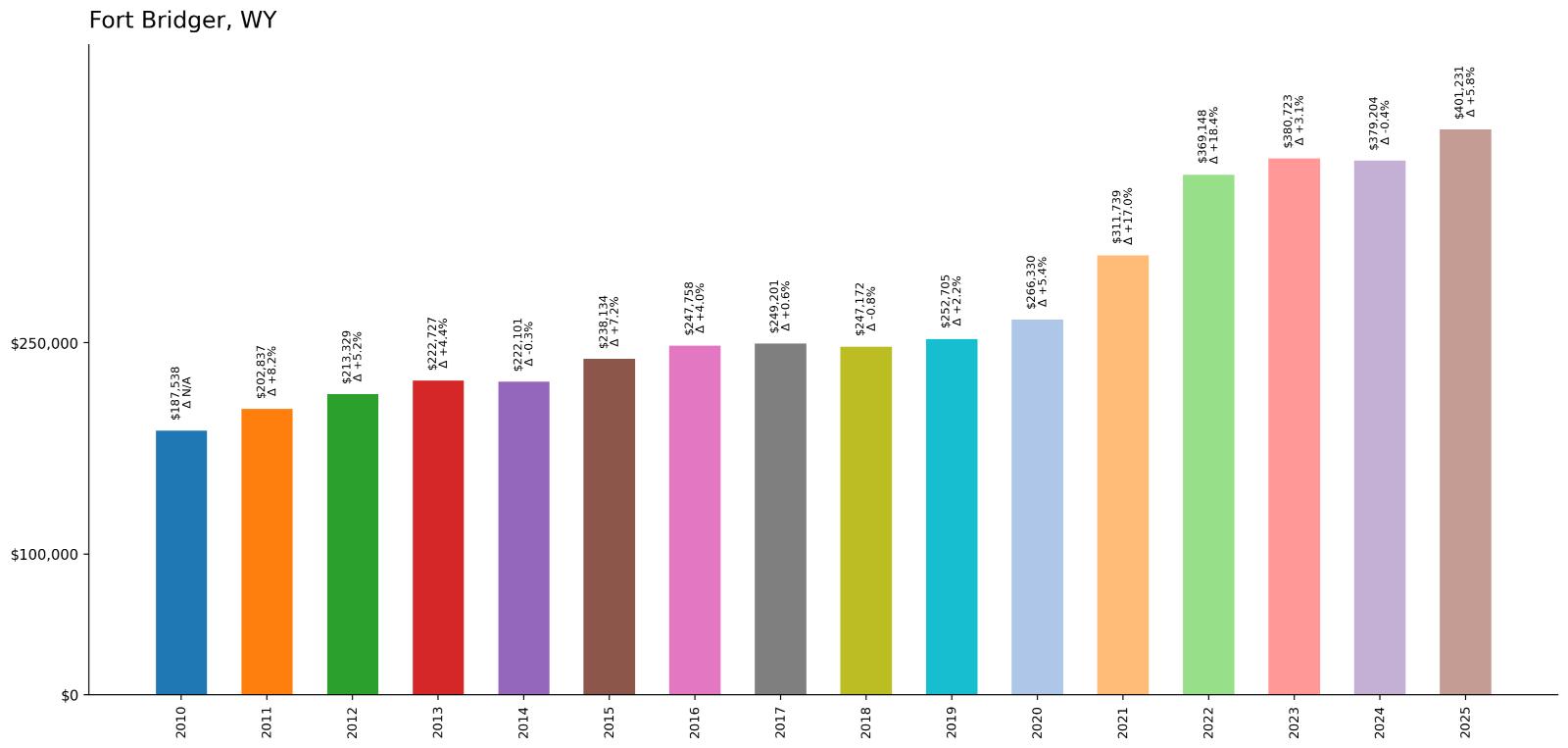
- 2010: $187,538
- 2011: $202,837
- 2012: $213,329
- 2013: $222,727
- 2014: $222,101
- 2015: $238,134
- 2016: $247,758
- 2017: $249,201
- 2018: $247,172
- 2019: $252,705
- 2020: $266,330
- 2021: $311,739
- 2022: $369,148
- 2023: $380,723
- 2024: $379,204
- 2025: $401,231
Fort Bridger has more than doubled in value since 2010, showing remarkably consistent growth over 15 years. The most significant acceleration came during 2021-2022, when values jumped from $311,739 to $369,148. At $401,231 in 2025, the community represents steady long-term appreciation in southwest Wyoming’s historic corridor.
Why Fort Bridger?
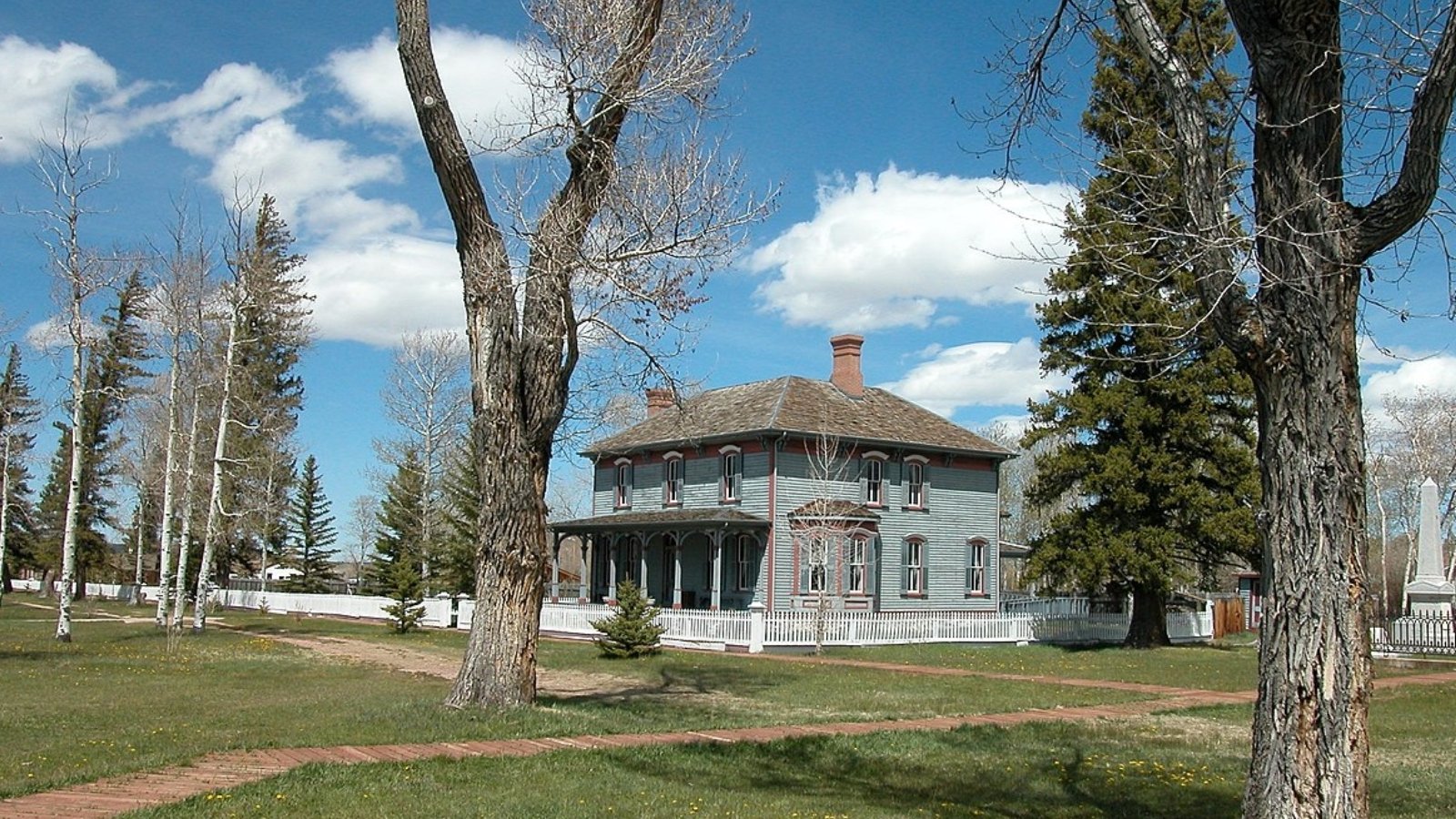
Why are people willing to pay so much to live here? What’s special about it?
Fort Bridger offers residents a unique combination of historic significance and outdoor recreation access in the Uinta Mountains. The town provides small-community living with easy access to Utah’s amenities and job markets, making it attractive to commuters and retirees. Families value the area’s rich history, outdoor opportunities, and proximity to larger cities while maintaining a rural lifestyle.
The community benefits from its location along Interstate 80, providing connectivity while preserving small-town character. Property owners enjoy lower taxes compared to neighboring states and access to world-class fishing, hunting, and hiking. The historic fort and annual rendezvous bring tourism revenue and cultural activities that enhance quality of life for residents.
How Fort Bridger Rose to Prominence
Fort Bridger was established in 1843 by mountain man Jim Bridger and became a crucial trading post along the Oregon, California, and Mormon Trails. The fort served thousands of westward travelers, providing supplies, repairs, and fresh livestock for the arduous journey ahead. Its strategic location at the confluence of major migration routes made it one of the most important commercial centers in the early American West.
The site became a military installation in 1858 during the Utah War and remained an active Army post until 1890. The fort’s role in protecting wagon trains and supporting westward expansion cemented its place in American frontier history. Today, Fort Bridger State Historic Site preserves this heritage while the modern community benefits from tourism and its position along major transportation corridors.
3 Interesting Tidbits
1. Mountain Man Rendezvous – The annual Mountain Man Rendezvous recreates 1800s frontier life, drawing thousands of history enthusiasts and reenactors each Labor Day weekend.
2. Trail Crossroads – Fort Bridger was the last major supply point before travelers faced the challenging mountain passes of Utah and Nevada, making it essential for westward migration.
3. Pony Express Stop – The fort served as a relay station for the famous Pony Express mail service, connecting the East and West coasts by horseback in the 1860s.
27. Kaycee – 37% Home Price Increase Since 2021
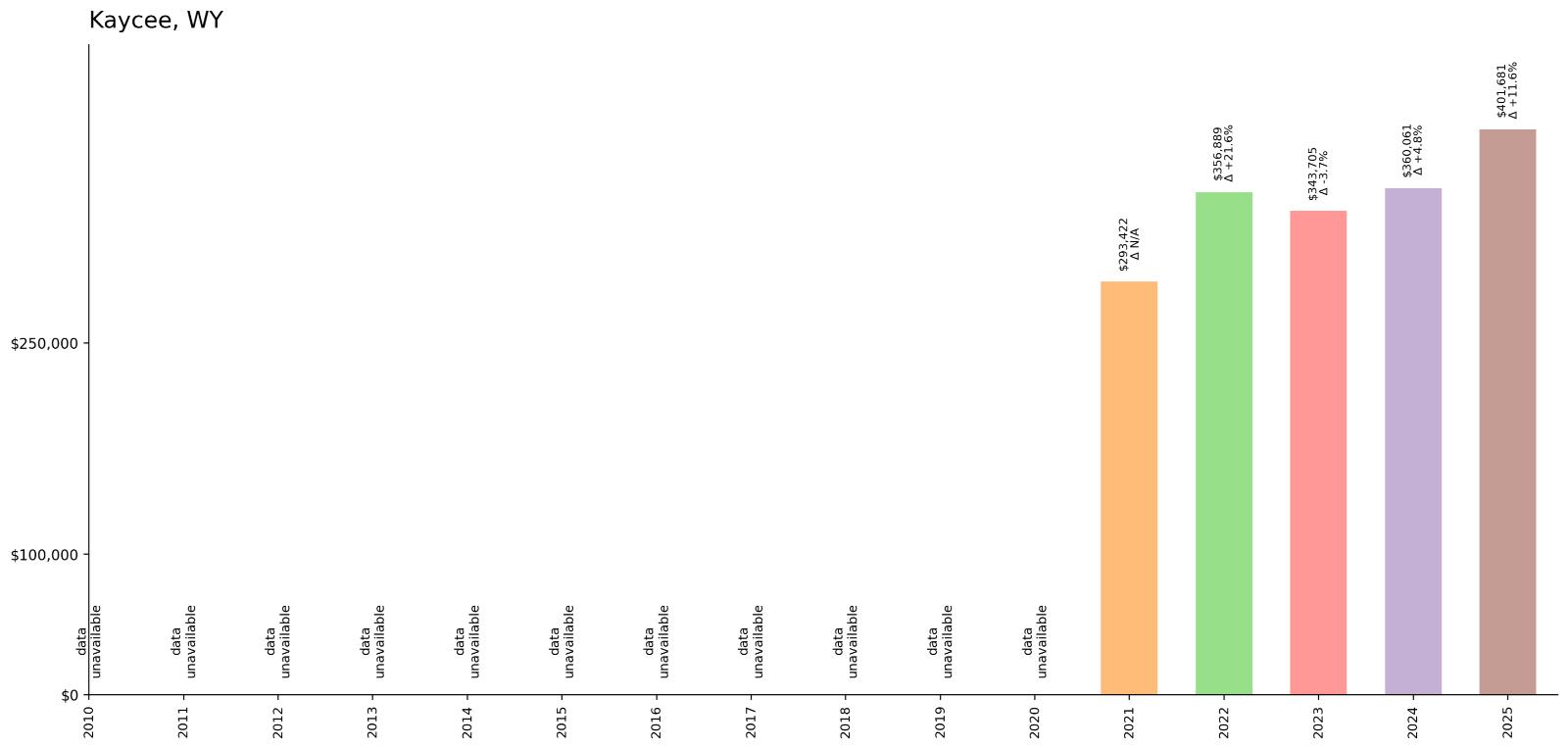
- 2010: N/A
- 2011: N/A
- 2012: N/A
- 2013: N/A
- 2014: N/A
- 2015: N/A
- 2016: N/A
- 2017: N/A
- 2018: N/A
- 2019: N/A
- 2020: N/A
- 2021: $293,422
- 2022: $356,889
- 2023: $343,705
- 2024: $360,061
- 2025: $401,681
Kaycee has experienced rapid appreciation in just four years of available data, climbing from $293,422 in 2021 to $401,681 in 2025. The most dramatic jump occurred between 2021 and 2022, increasing over $63,000 in a single year. Despite some volatility, the overall trend shows strong upward momentum in this central Wyoming community.
Why Kaycee?

Why are people willing to pay so much to live here? What’s special about it?
Kaycee sits in the heart of Wyoming’s ranch country, offering authentic Western living with access to the Bighorn Mountains and extensive public lands. The town provides a genuine small-town atmosphere while serving as a gateway to world-class hunting, fishing, and outdoor recreation. Residents appreciate the area’s ranching heritage, strong community bonds, and proximity to larger towns like Casper and Buffalo.
The community benefits from its central location between major Wyoming cities and its role as a supply center for area ranches and energy operations. Property values reflect the area’s economic stability through diversified agriculture and energy sectors. The town’s authentic Western character and outdoor recreation access attract buyers seeking rural lifestyle opportunities.
How Kaycee Rose to Prominence
Kaycee was established in 1897 when the Chicago, Burlington & Quincy Railroad extended service through central Wyoming, creating a shipping point for area cattle ranches. The town was named after KC Ranch, one of the largest operations in the region, and quickly became a commercial center for the surrounding agricultural area. Its location along the railroad made it essential for moving livestock and goods to eastern markets.
The community gained historical significance during the Johnson County War of 1892, when conflicts between large cattle operations and smaller ranchers came to a head near Kaycee. The famous KC Ranch was at the center of these range wars, and the area’s history is preserved in local museums and historical sites. Modern Kaycee continues to serve the ranching community while attracting visitors interested in Western history and outdoor recreation.
3 Interesting Tidbits
1. Outlaw Country – The area around Kaycee was a favorite hideout for Butch Cassidy and the Wild Bunch, who used the rugged terrain to evade law enforcement.
2. Sheepherder Museum – Kaycee is home to a unique museum dedicated to the history of Basque sheepherders who worked the area’s ranges in the early 1900s.
3. Rodeo Heritage – The town hosts one of Wyoming’s most authentic small-town rodeos, maintaining traditions that date back over a century.
26. Burlington – 64% Home Price Increase Since 2019

- 2010: N/A
- 2011: N/A
- 2012: N/A
- 2013: N/A
- 2014: N/A
- 2015: N/A
- 2016: N/A
- 2017: N/A
- 2018: N/A
- 2019: $246,860
- 2020: $259,137
- 2021: $313,776
- 2022: $364,881
- 2023: $359,128
- 2024: $373,465
- 2025: $404,889
Burlington has seen substantial growth since 2019, with home values climbing from $246,860 to $404,889. The strongest appreciation occurred between 2020 and 2022, when values jumped from $259,137 to $364,881. The community has maintained steady growth momentum, reaching current median prices above $400,000.
Why Burlington?
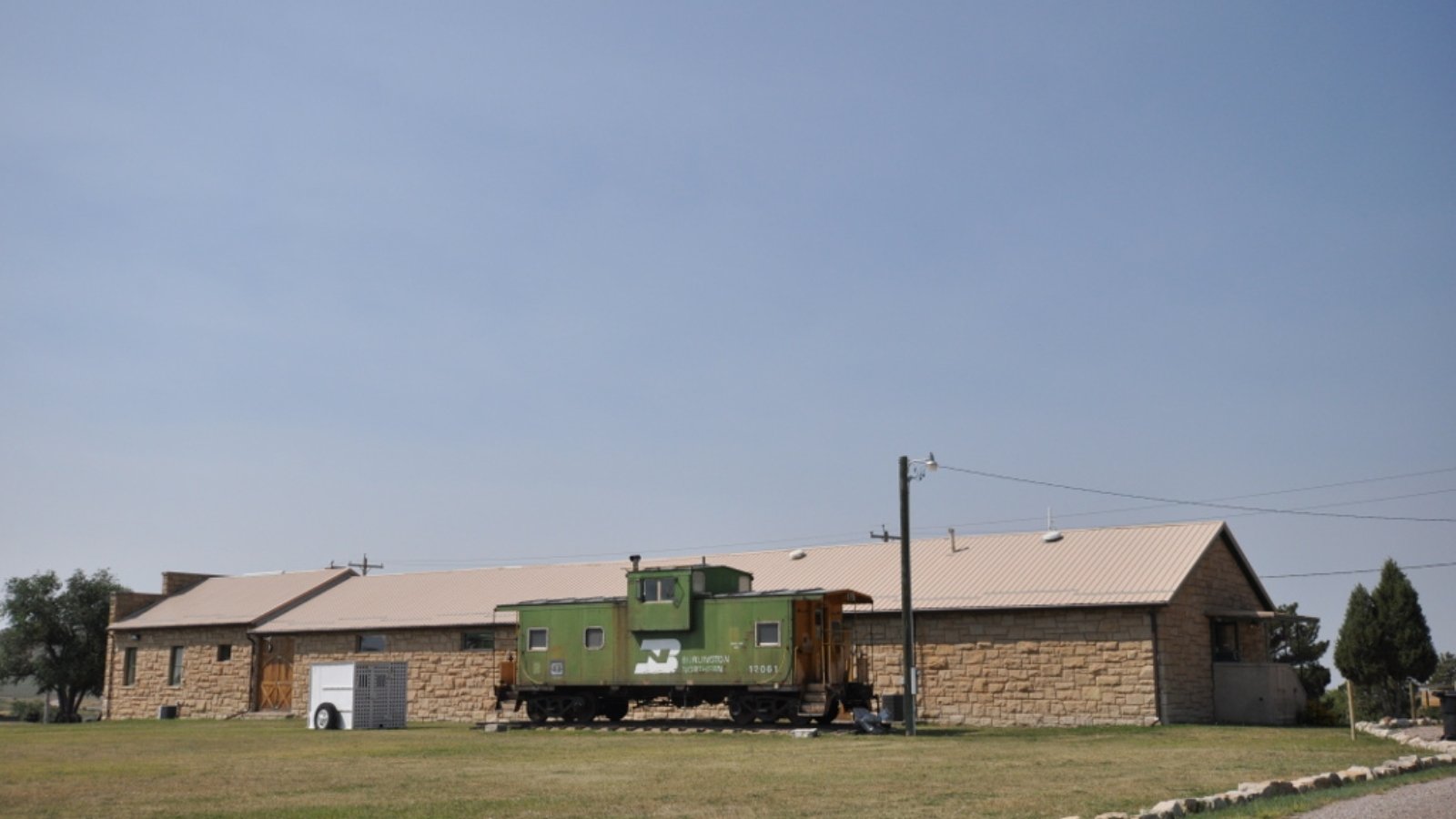
Why are people willing to pay so much to live here? What’s special about it?
Burlington offers residents access to the Bighorn River basin and some of Wyoming’s most productive agricultural land. The community provides rural living with strong agricultural economy and proximity to larger towns for services and employment. Families value the area’s farming heritage, outdoor recreation opportunities, and small-town safety with excellent schools.
The town benefits from its location in fertile river bottom land that supports diverse agriculture and ranching operations. Property values reflect the area’s economic stability through agricultural production and its appeal to those seeking rural lifestyle opportunities. The community’s position along major transportation routes provides connectivity while maintaining agricultural character.
How Burlington Rose to Prominence
Burlington was established in 1901 as a railroad town when the Burlington Railroad extended service through the Bighorn Basin. The community developed as a shipping point for area farms and ranches, taking advantage of the fertile Bighorn River valley for agricultural production. Its location along the railroad made it a natural commercial center for surrounding agricultural operations.
The town’s growth was fueled by homesteading and the development of sugar beet farming in the early 1900s. The construction of irrigation systems and the arrival of German-Russian immigrants who specialized in sugar beet cultivation helped establish Burlington as an agricultural hub. The community continues to serve the regional agricultural economy while attracting residents who value rural living and outdoor recreation access.
3 Interesting Tidbits
1. Sugar Beet Capital – Burlington was once the center of Wyoming’s sugar beet industry, with processing facilities that served the entire Bighorn Basin.
2. River Access – The town provides excellent access to the Bighorn River for fishing, with some of Wyoming’s most productive trout waters just minutes away.
3. Agricultural Heritage – Burlington maintains one of Wyoming’s most successful 4-H programs, reflecting the community’s strong agricultural traditions and youth development focus.
25. Buffalo – 101% Home Price Increase Since 2010
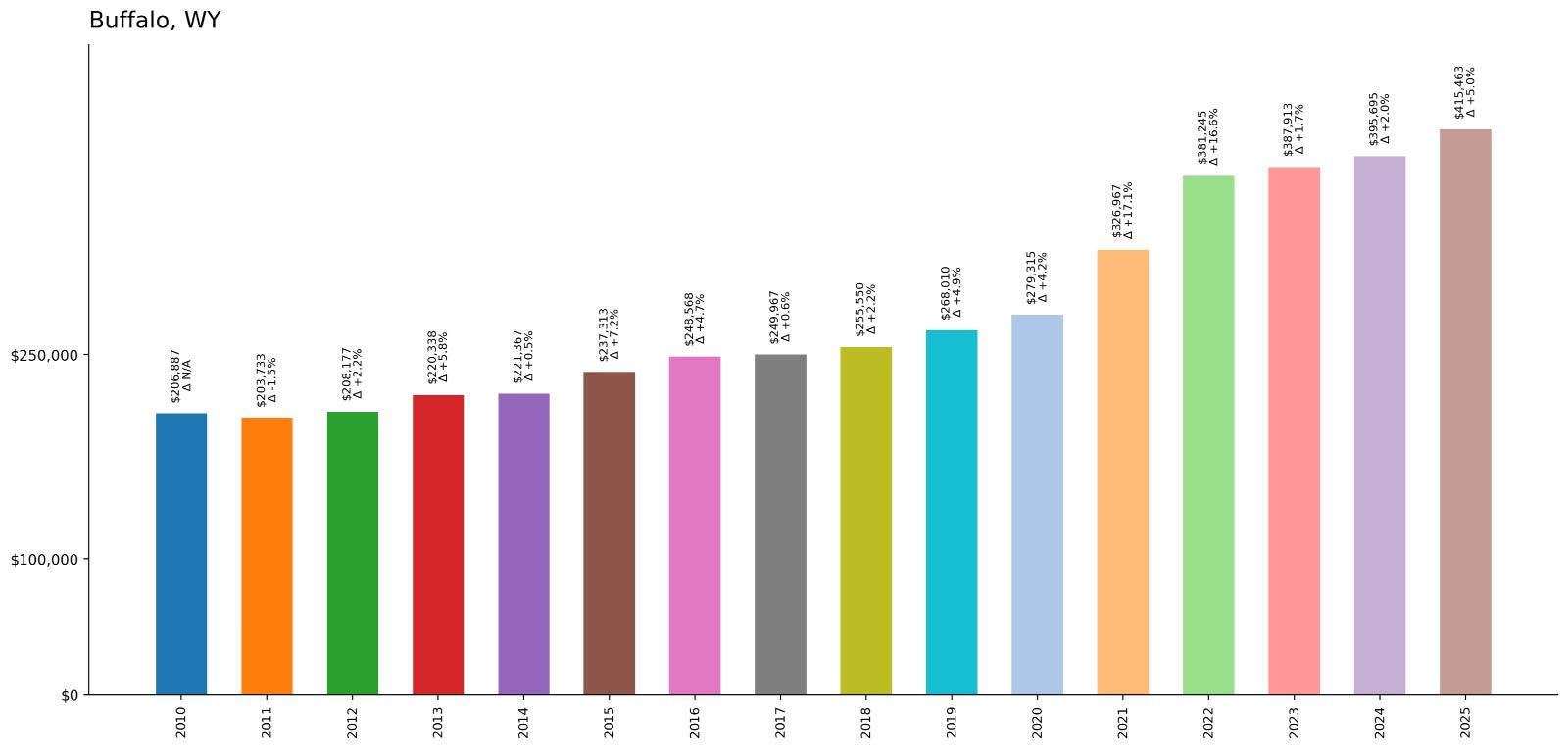
- 2010: $206,887
- 2011: $203,733
- 2012: $208,177
- 2013: $220,338
- 2014: $221,367
- 2015: $237,313
- 2016: $248,568
- 2017: $249,967
- 2018: $255,550
- 2019: $268,010
- 2020: $279,315
- 2021: $326,967
- 2022: $381,245
- 2023: $387,913
- 2024: $395,695
- 2025: $415,463
Buffalo has doubled in value since 2010, showing remarkable consistency in growth over 15 years. The steepest acceleration occurred between 2021 and 2022, with values jumping from $326,967 to $381,245. Current median home prices of $415,463 reflect sustained demand in this northern Wyoming community at the base of the Bighorn Mountains.
Why Buffalo?

Why are people willing to pay so much to live here? What’s special about it?
Buffalo serves as the gateway to the Cloud Peak Wilderness and Bighorn National Forest, offering residents immediate access to world-class outdoor recreation. The town combines small-city amenities with mountain living, featuring good schools, healthcare, and shopping while maintaining easy access to hiking, fishing, and hunting. Retirees and outdoor enthusiasts appreciate the four-season recreation and authentic Western atmosphere.
The community benefits from being the Johnson County seat, providing stable government employment and services that support the local economy. Property values reflect Buffalo’s role as a regional center with superior infrastructure and amenities compared to smaller towns. The area’s natural beauty, recreational access, and economic stability create strong demand among buyers seeking mountain town living.
How Buffalo Rose to Prominence
Buffalo was founded in 1879 and named after nearby Buffalo Creek, serving as the county seat for Johnson County from its early days. The town developed as a supply center for area ranches and became a key stop along the Bozeman Trail, which connected gold fields in Montana with eastern settlements. Its location in the fertile Clear Creek valley made it ideal for agriculture and ranching operations.
The community gained national attention during the Johnson County War of 1892, when conflicts between large cattle barons and smaller ranchers erupted in violence near Buffalo. The historic Occidental Hotel served as headquarters for the cattlemen’s army, and many buildings from this era still stand today. Buffalo’s role as a county seat and its proximity to the Bighorn Mountains cemented its position as a regional center for northeastern Wyoming.
3 Interesting Tidbits
1. Wild West History – Buffalo was the epicenter of the Johnson County War, one of the most famous range wars in American history, with several historic sites still preserved today.
2. Mountain Gateway – The town serves as the primary access point to Cloud Peak Wilderness, Wyoming’s most popular wilderness area for backpacking and mountaineering.
3. Clear Creek Brewing – Buffalo is home to one of Wyoming’s oldest craft breweries, which began operations in the historic downtown district in the 1990s.
24. Antelope Valley-Crestview – 75% Home Price Increase Since 2010
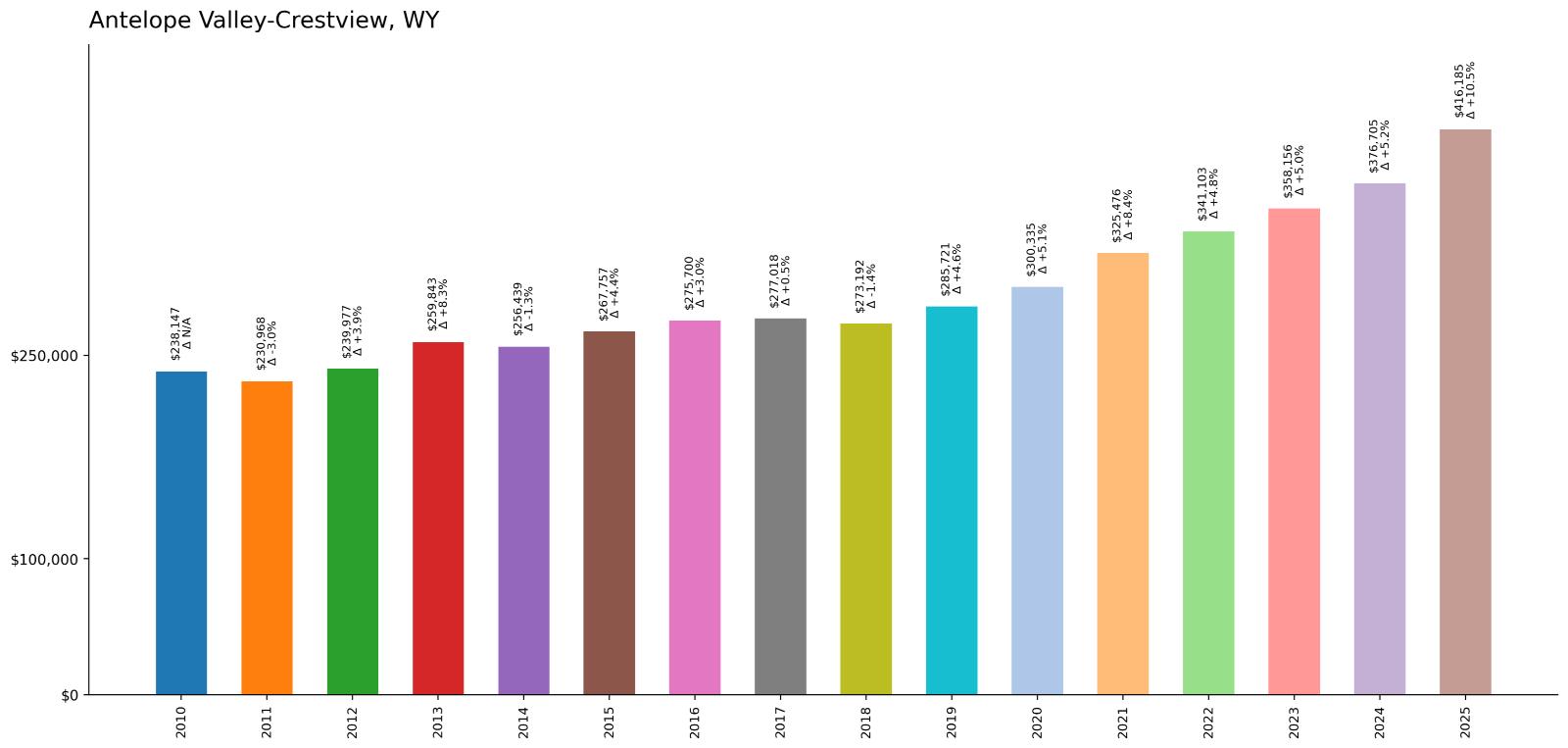
- 2010: $238,147
- 2011: $230,968
- 2012: $239,977
- 2013: $259,843
- 2014: $256,439
- 2015: $267,757
- 2016: $275,700
- 2017: $277,018
- 2018: $273,192
- 2019: $285,721
- 2020: $300,335
- 2021: $325,476
- 2022: $341,103
- 2023: $358,156
- 2024: $376,705
- 2025: $416,185
Antelope Valley-Crestview has experienced steady appreciation since 2010, growing from $238,147 to $416,185. The community showed resilience during economic downturns and maintained consistent growth throughout the 15-year period. The most recent acceleration pushed values to $416,185, reflecting sustained demand in this southeast Wyoming area.
Why Antelope Valley-Crestview?
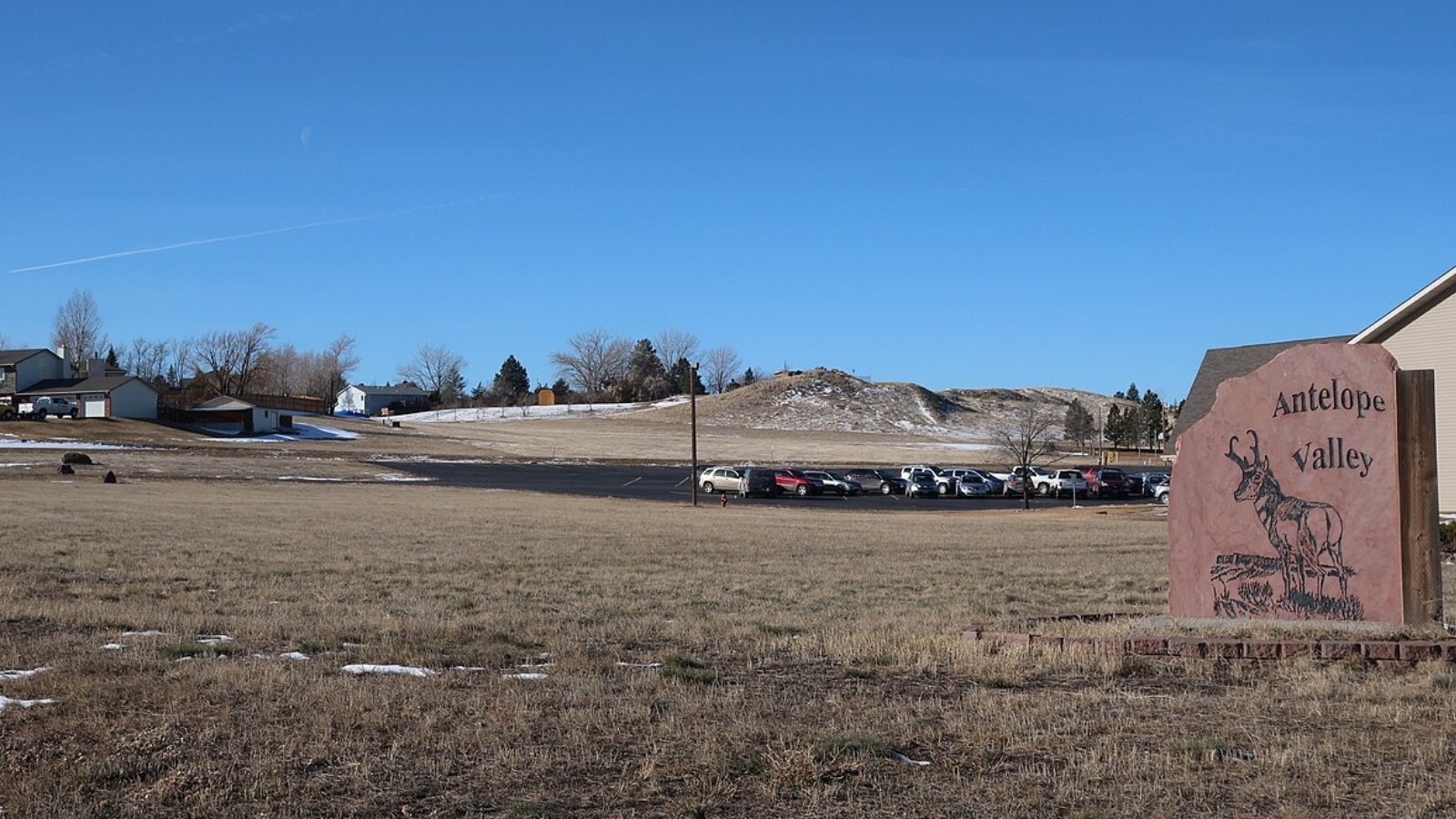
Why are people willing to pay so much to live here? What’s special about it?
Antelope Valley-Crestview offers residents a suburban lifestyle with access to Cheyenne’s employment opportunities while maintaining a more rural setting. The area provides larger lots, newer homes, and proximity to outdoor recreation in the Medicine Bow Mountains. Families appreciate the area’s schools, safety, and balance between city conveniences and country living.
The community benefits from its location near Cheyenne, providing access to state government jobs, military employment at F.E. Warren Air Force Base, and regional business opportunities. Property values reflect the area’s appeal to professionals who want suburban amenities with quick access to outdoor recreation. The combination of employment opportunities and lifestyle amenities creates consistent demand for housing in the area.
How Antelope Valley-Crestview Rose to Prominence
The Antelope Valley-Crestview area developed as suburban expansion from Cheyenne grew throughout the late 20th century. The community emerged as families and professionals sought larger properties and newer construction while maintaining access to Cheyenne’s employment and services. The area’s development accelerated with the growth of F.E. Warren Air Force Base and expansion of state government employment.
The community’s prominence grew as Cheyenne expanded beyond its traditional boundaries, with developers recognizing demand for suburban living options. The area’s rolling terrain and proximity to outdoor recreation made it attractive for residential development that offered more space and natural beauty than urban Cheyenne. Modern Antelope Valley-Crestview serves commuters who work in Cheyenne but prefer suburban or rural living environments.
3 Interesting Tidbits
1. Military Connection – Many residents work at nearby F.E. Warren Air Force Base, one of the oldest military installations in the Air Force and home to nuclear missile operations.
2. Frontier Days Proximity – The area provides easy access to Cheyenne Frontier Days, the world’s largest outdoor rodeo and western celebration held annually in July.
3. Wind Energy Hub – The region sits in one of Wyoming’s prime wind corridors, with numerous wind farms contributing to the local economy and providing renewable energy jobs.
23. Ranchester – 67% Home Price Increase Since 2017
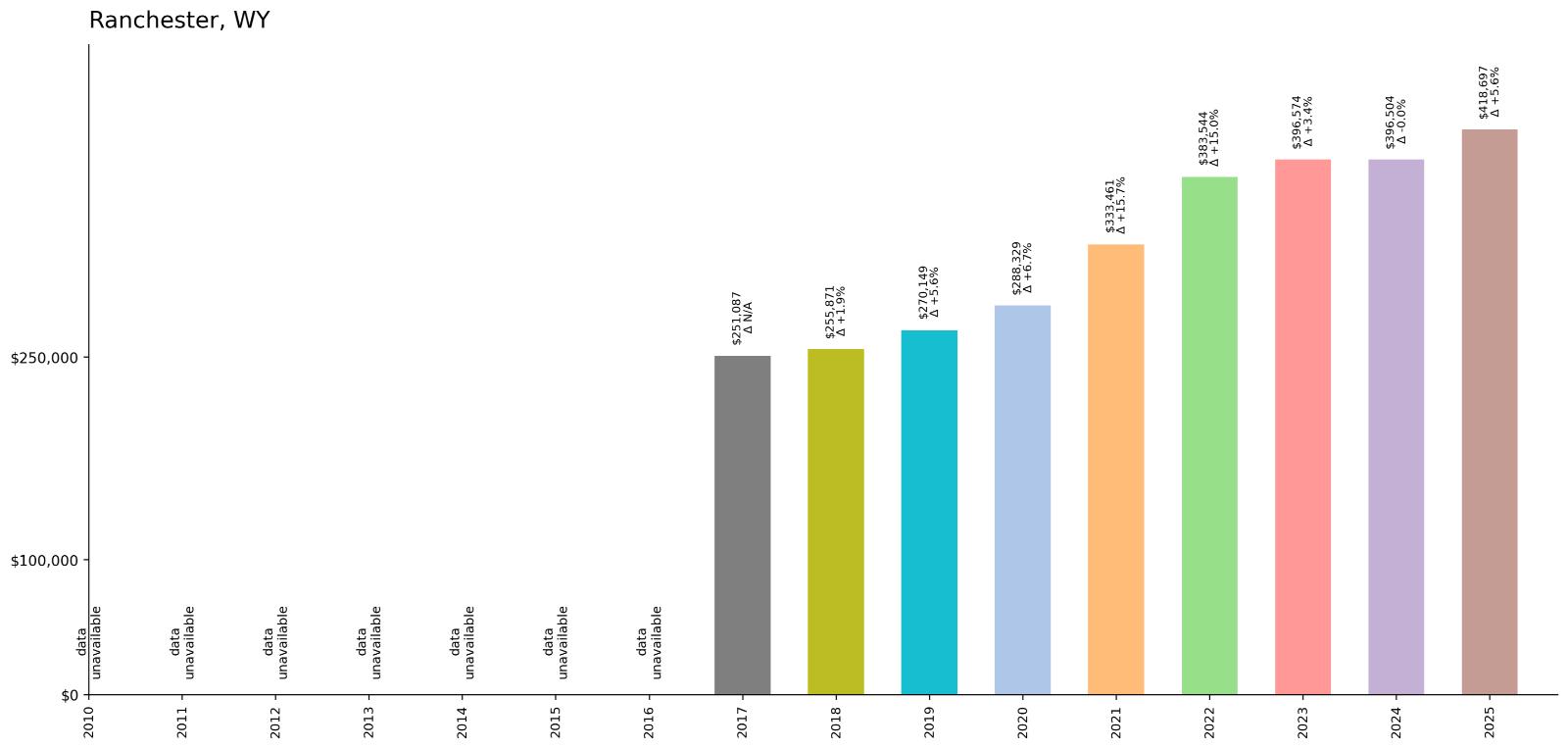
- 2010: N/A
- 2011: N/A
- 2012: N/A
- 2013: N/A
- 2014: N/A
- 2015: N/A
- 2016: N/A
- 2017: $251,087
- 2018: $255,871
- 2019: $270,149
- 2020: $288,329
- 2021: $333,461
- 2022: $383,544
- 2023: $396,574
- 2024: $396,504
- 2025: $418,697
Ranchester has shown strong appreciation since 2017, with values climbing from $251,087 to $418,697. The most significant growth occurred between 2021 and 2022, when values jumped from $333,461 to $383,544. The community has maintained steady momentum, reaching current median prices above $418,000.
Why Ranchester?
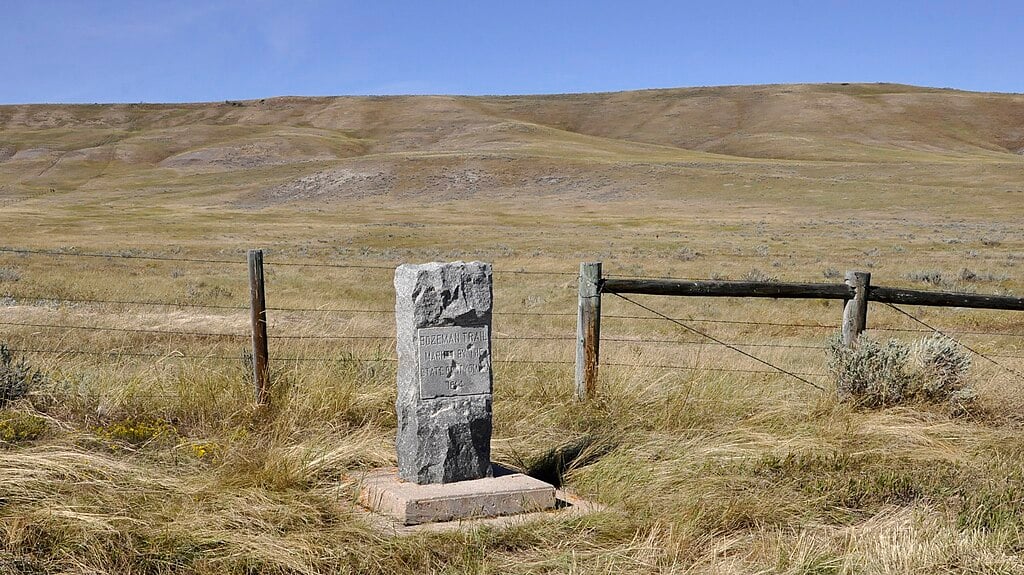
Why are people willing to pay so much to live here? What’s special about it?
Ranchester provides residents with small-town living at the foot of the Bighorn Mountains, offering immediate access to outdoor recreation and scenic beauty. The community serves as a bedroom community for Sheridan while maintaining its own identity and rural character. Families value the area’s safety, outdoor access, and proximity to both Sheridan’s amenities and mountain recreation opportunities.
The town benefits from its location along the Tongue River and its position as a gateway to the Bighorn National Forest. Property values reflect demand from buyers seeking mountain living with reasonable commuting distance to employment centers. The area’s combination of rural atmosphere and outdoor recreation access creates sustained interest among homebuyers.
How Ranchester Rose to Prominence
Ranchester was established in 1907 when the Chicago, Burlington & Quincy Railroad extended service through the Tongue River valley. The town developed as a shipping point for area ranches and farms, taking advantage of the fertile river bottom land for agricultural production. Its location along the railroad and at the base of the Bighorn Mountains made it a natural supply center for both agriculture and early tourism.
The community’s growth was supported by homesteading and the development of sugar beet farming in the early 1900s. The town served as a commercial center for surrounding ranches and provided access to mountain recreation as tourism began developing in the Bighorn Mountains. Modern Ranchester maintains its agricultural heritage while serving as a residential community for those working in nearby Sheridan or seeking mountain lifestyle opportunities.
3 Interesting Tidbits
1. Sugar Factory Legacy – Ranchester was home to one of the region’s major sugar beet processing facilities, which operated for decades and shaped the local economy.
2. Tongue River Access – The town provides excellent access to Tongue River fishing, offering some of northern Wyoming’s best trout fishing opportunities.
3. Mountain Gateway – Ranchester serves as a primary access point to the Bighorn Mountains’ western slopes, with multiple forest service roads leading to hiking and camping areas.
22. Farson – 57% Home Price Increase Since 2012
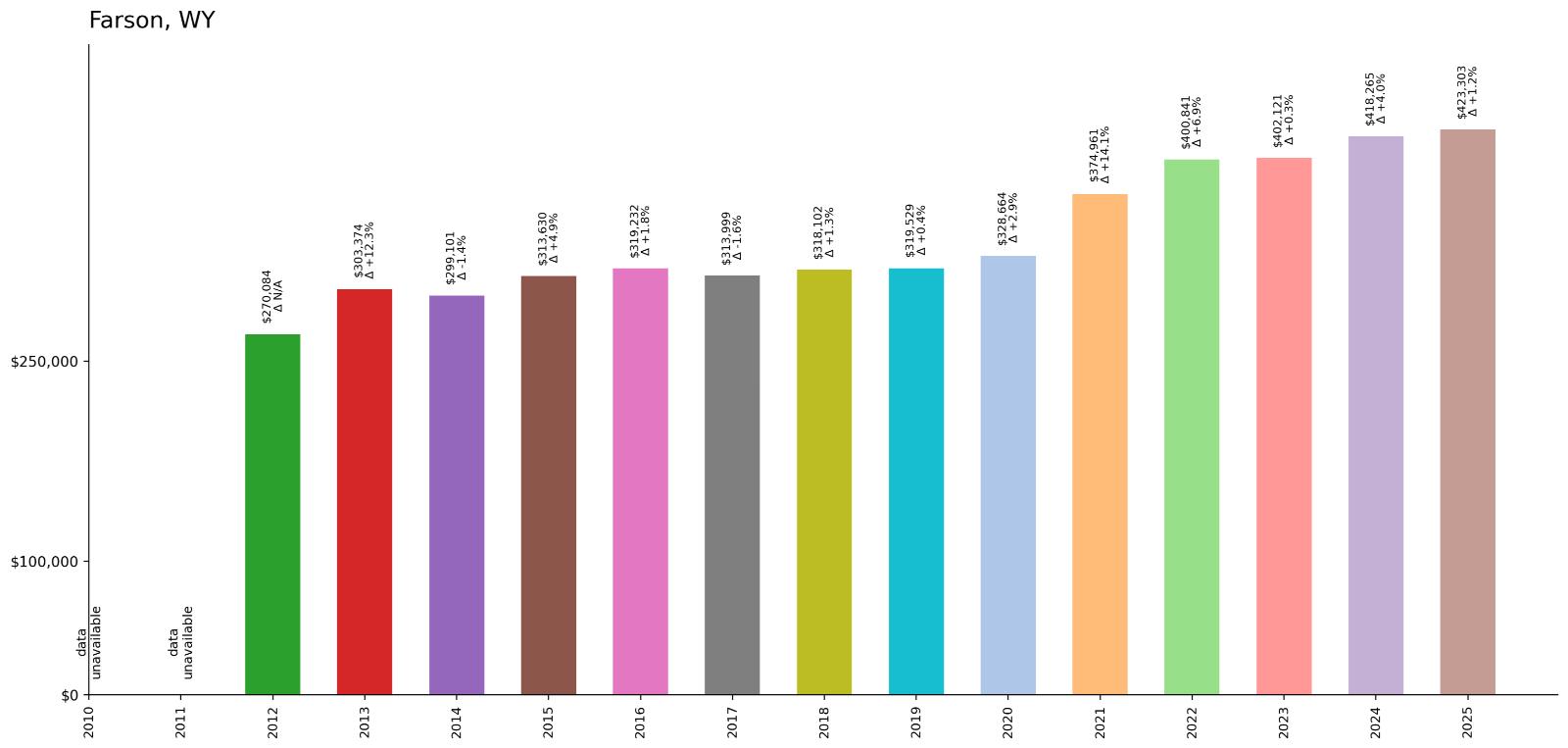
- 2010: N/A
- 2011: N/A
- 2012: $270,084
- 2013: $303,374
- 2014: $299,101
- 2015: $313,630
- 2016: $319,232
- 2017: $313,999
- 2018: $318,102
- 2019: $319,529
- 2020: $328,664
- 2021: $374,961
- 2022: $400,841
- 2023: $402,121
- 2024: $418,265
- 2025: $423,303
Farson has shown steady appreciation since 2012, growing from $270,084 to $423,303. The community experienced its strongest growth between 2020 and 2022, when values jumped from $328,664 to $400,841. Current median prices above $423,000 reflect sustained demand in this southwest Wyoming community.
Why Farson?
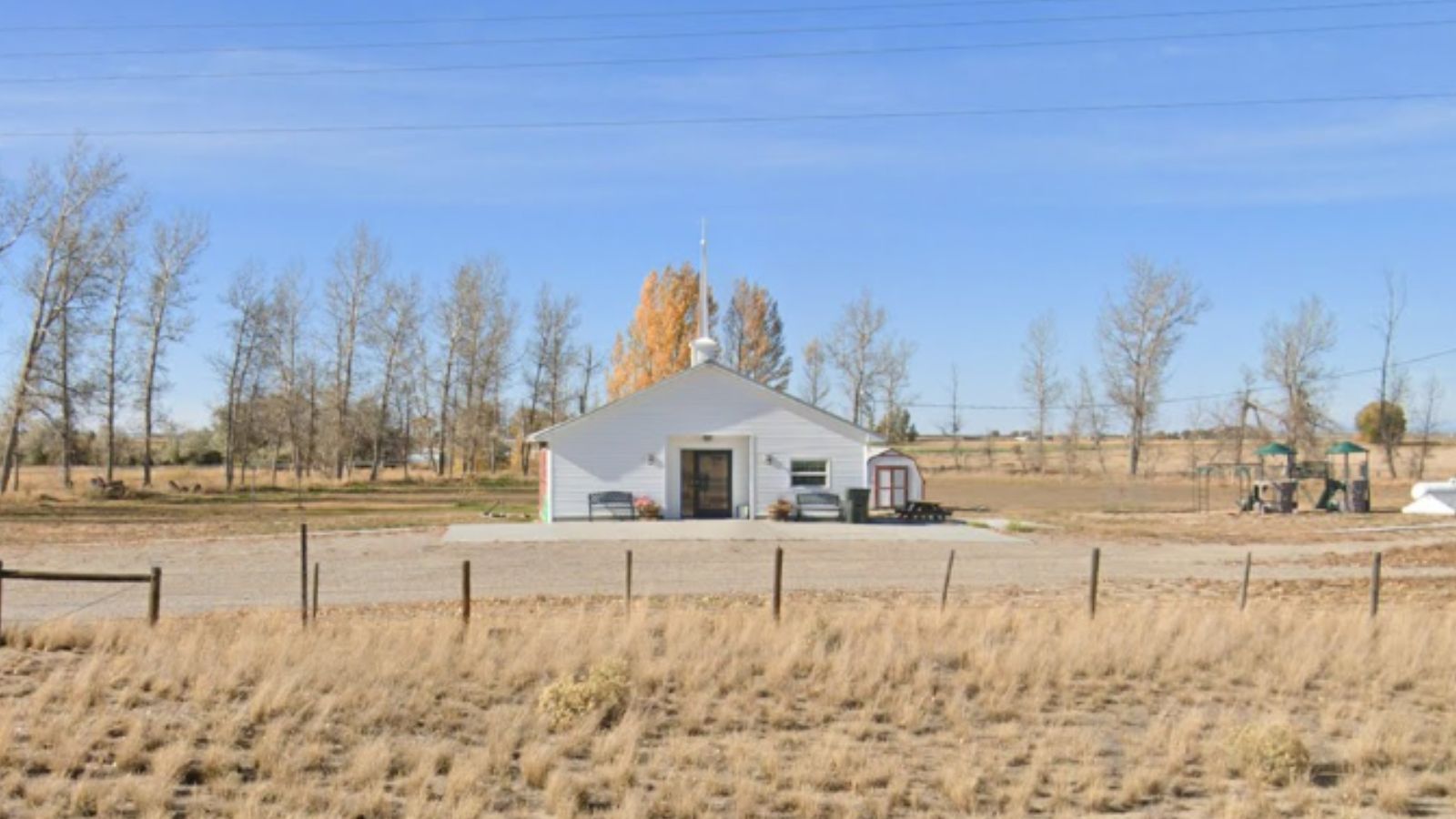
Why are people willing to pay so much to live here? What’s special about it?
Farson sits at the crossroads of major hunting and fishing areas, providing access to some of Wyoming’s best outdoor recreation opportunities. The community serves as a supply center for hunters, anglers, and outdoor enthusiasts heading to the Wind River Mountains and surrounding wilderness areas. Residents enjoy small-town living with excellent access to world-class fishing on the Green River and hunting in nearby mountain ranges.
The town benefits from its strategic location along major transportation routes and its role as a gateway to outdoor recreation. Property values reflect demand from outdoor enthusiasts and those seeking rural lifestyle opportunities with access to premier hunting and fishing. The area’s economic stability through energy development and tourism creates consistent housing demand.
How Farson Rose to Prominence
Farson was established in the 1860s as a stage stop along the Oregon Trail and later became a key point on the Overland Trail route. The community developed around a trading post that served westward travelers and provided supplies for the dangerous journey ahead. Its location at the junction of several trail routes made it an essential stopping point for wagon trains crossing Wyoming.
The town’s importance continued with the arrival of the railroad and the development of sheep ranching in the early 1900s. Farson became a major shipping point for wool and livestock, serving the extensive sheep operations throughout southwest Wyoming. The discovery of natural gas in the area brought modern economic development, while the community’s position near premier fishing and hunting areas established it as an outdoor recreation hub.
3 Interesting Tidbits
1. Oregon Trail Legacy – Farson sits near several well-preserved sections of the Oregon Trail, with wagon ruts still visible after more than 150 years.
2. Mercantile History – The historic Farson Mercantile has been serving the community since 1902 and remains a gathering place for locals and travelers.
3. Green River Access – The town provides premier access to the Green River’s famous trout fishing, attracting anglers from across the country to nearby waters.
21. Dayton – 69% Home Price Increase Since 2017

- 2010: N/A
- 2011: N/A
- 2012: N/A
- 2013: N/A
- 2014: N/A
- 2015: N/A
- 2016: N/A
- 2017: $253,556
- 2018: $262,563
- 2019: $277,145
- 2020: $303,601
- 2021: $350,816
- 2022: $393,065
- 2023: $404,661
- 2024: $417,643
- 2025: $429,086
Dayton has experienced substantial growth since 2017, with values climbing from $253,556 to $429,086. The community showed particularly strong appreciation between 2020 and 2022, when values jumped from $303,601 to $393,065. Current median prices above $429,000 reflect sustained demand in this northern Wyoming mountain community.
Why Dayton?

Why are people willing to pay so much to live here? What’s special about it?
Dayton offers residents access to the Bighorn Mountains and Tongue River while maintaining proximity to Sheridan for employment and services. The community provides mountain living with excellent outdoor recreation opportunities including fishing, hunting, hiking, and winter sports. Families appreciate the small-town atmosphere, scenic beauty, and access to both mountain recreation and urban amenities in nearby Sheridan.
The town benefits from its location along the scenic Bighorn Mountain loop and its position as a gateway to Cloud Peak Wilderness. Property values reflect strong demand from buyers seeking mountain lifestyle opportunities with reasonable access to employment centers. The area’s natural beauty, recreational access, and proximity to larger communities creates consistent interest among homebuyers.
How Dayton Rose to Prominence
Dayton was founded in 1882 when the Burlington Railroad extended service up the Tongue River valley toward the Bighorn Mountains. The town developed as a supply center for area ranches and mining operations in the mountains, serving as the end of the railroad line for goods heading into the high country. Its location made it a natural staging area for mountain commerce and early tourism.
The community’s growth was fueled by ranching, logging, and early recreational tourism as visitors began discovering the beauty of the Bighorn Mountains. Dayton served as a base camp for hunters, fishermen, and eventually outdoor enthusiasts seeking mountain recreation. The town’s role as a gateway to the Bighorn National Forest and its scenic mountain setting established it as both a working community and recreation destination.
3 Interesting Tidbits
1. Tongue River Fishing – Dayton provides access to some of Wyoming’s most productive trout fishing waters, with the Tongue River offering excellent fly fishing opportunities.
2. Mountain Loop Access – The town sits on the famous Bighorn Mountain Scenic Loop, one of Wyoming’s most beautiful driving routes connecting multiple mountain communities.
3. Historic Foothills Museum – Dayton’s museum preserves the area’s ranching and railroad heritage, showcasing artifacts from the town’s role as a mountain gateway community.
20. Powell – 105% Home Price Increase Since 2010
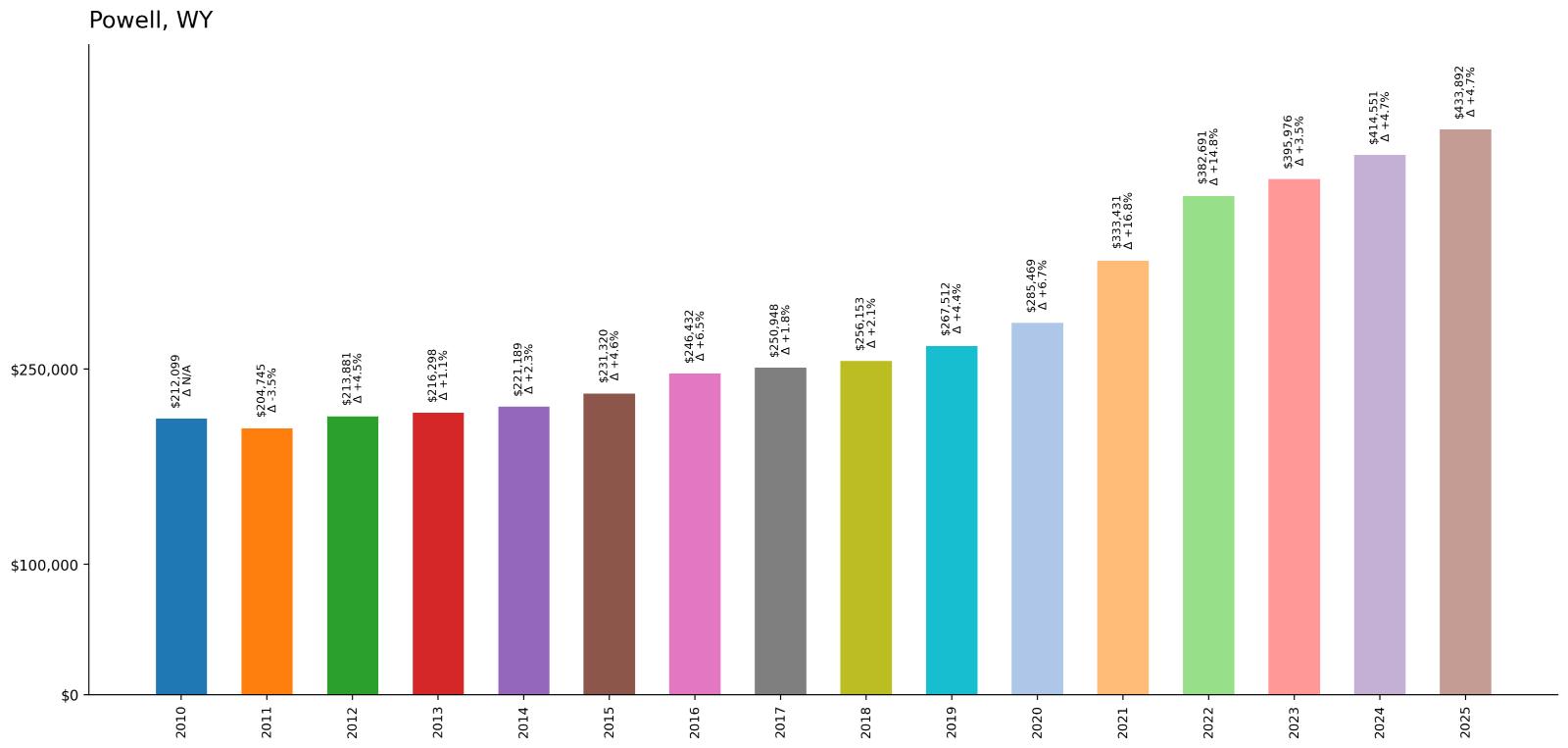
- 2010: $212,099
- 2011: $204,745
- 2012: $213,881
- 2013: $216,298
- 2014: $221,189
- 2015: $231,320
- 2016: $246,432
- 2017: $250,948
- 2018: $256,153
- 2019: $267,512
- 2020: $285,469
- 2021: $333,431
- 2022: $382,691
- 2023: $395,976
- 2024: $414,551
- 2025: $433,892
Powell has more than doubled in value since 2010, showing remarkable consistent growth over 15 years. The steepest acceleration occurred between 2021 and 2022, when values jumped from $333,431 to $382,691. Current median home prices of $433,892 reflect sustained demand in this northwest Wyoming community that serves as a gateway to Yellowstone National Park.
Why Powell?
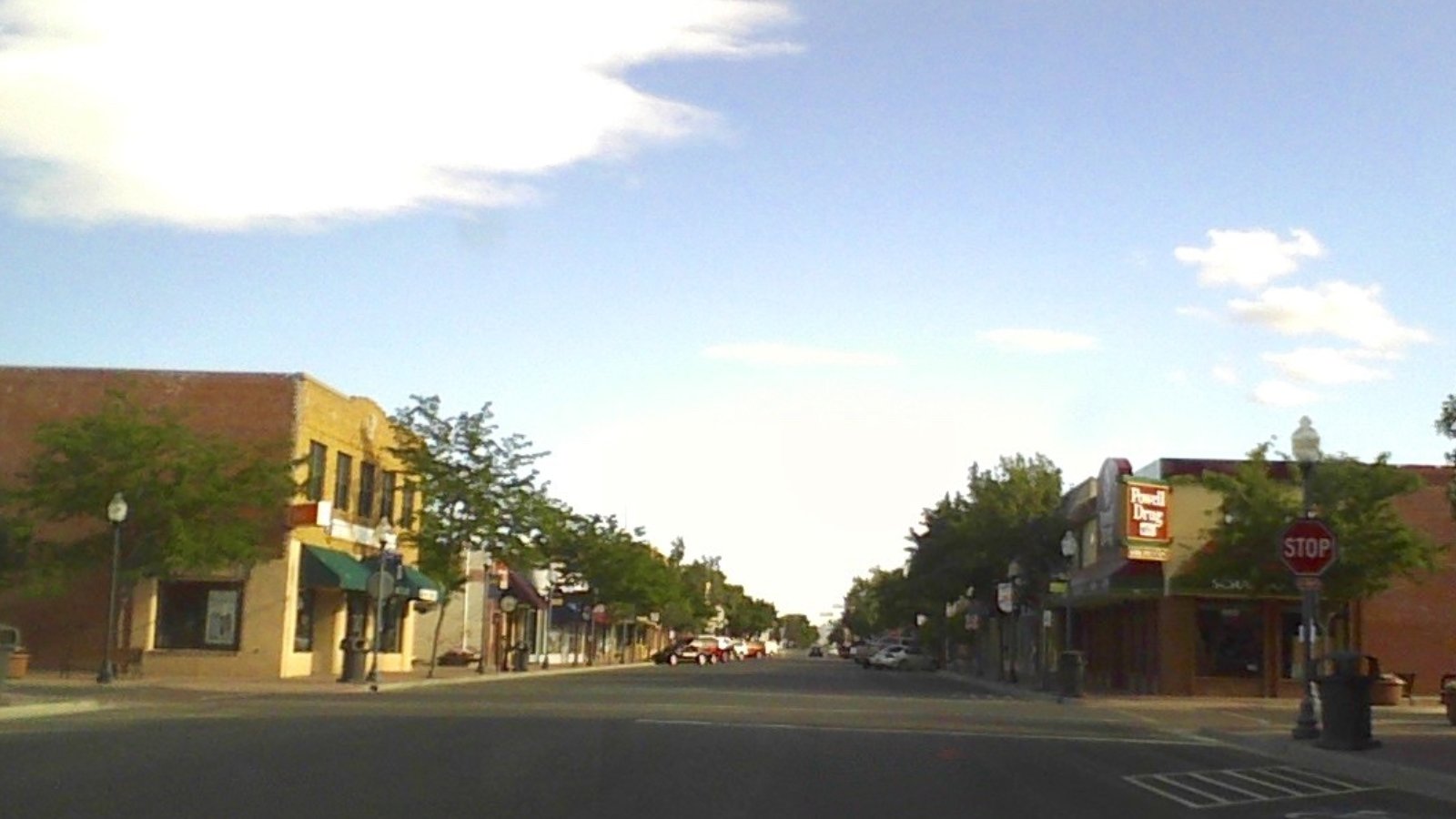
Why are people willing to pay so much to live here? What’s special about it?
Powell serves as a primary gateway to Yellowstone National Park while offering residents access to world-class outdoor recreation year-round. The community provides small-city amenities including Northwest College, excellent healthcare, and diverse employment opportunities while maintaining proximity to some of America’s most spectacular natural areas. Families value the area’s educational opportunities, outdoor access, and balance between urban conveniences and mountain living.
The town benefits from its strategic location between Yellowstone and the Bighorn Mountains, creating year-round tourism and recreation opportunities. Property values reflect demand from outdoor enthusiasts, retirees, and professionals who want access to premier recreation with good infrastructure and services. The combination of natural beauty, educational institutions, and economic diversity creates strong long-term housing demand.
How Powell Rose to Prominence
Powell was established in 1906 as part of the federal Shoshone Irrigation Project, one of the first major reclamation projects in the American West. The town was named after John Wesley Powell, the famous explorer and geologist who first mapped much of the Colorado River system. The federal irrigation project transformed the desert landscape into productive agricultural land, attracting settlers from across the country.
The community’s development was carefully planned around the irrigation system and agricultural potential of the Bighorn Basin. Powell became a major agricultural center specializing in sugar beets, corn, and livestock production. The establishment of Northwest College in 1946 added educational and cultural dimensions to the community, while its proximity to Yellowstone National Park established tourism as an important economic sector.
3 Interesting Tidbits
1. Yellowstone Gateway – Powell provides the most direct route to Yellowstone’s east entrance, making it a popular base for park visitors and seasonal residents.
2. Heart Mountain History – During World War II, the area housed the Heart Mountain Japanese American internment camp, now preserved as an important historical site and museum.
3. Agricultural Innovation – Powell remains a center for agricultural research and education through Northwest College’s agricultural programs and experimental farms.
19. Sheridan – 90% Home Price Increase Since 2012
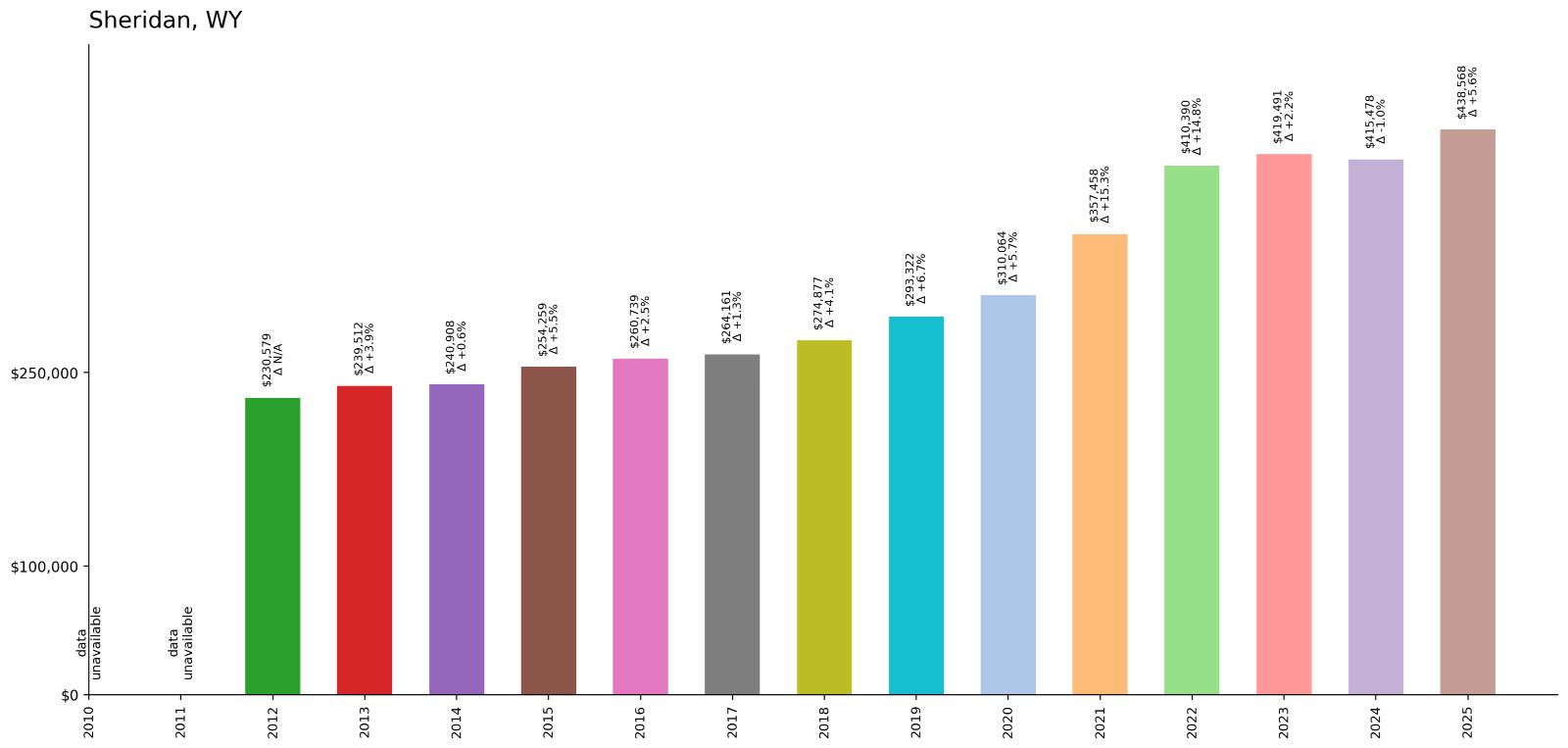
- 2010: N/A
- 2011: N/A
- 2012: $230,579
- 2013: $239,512
- 2014: $240,908
- 2015: $254,259
- 2016: $260,739
- 2017: $264,161
- 2018: $274,877
- 2019: $293,322
- 2020: $310,064
- 2021: $357,458
- 2022: $410,390
- 2023: $419,491
- 2024: $415,478
- 2025: $438,568
Sheridan has experienced steady growth since 2012, nearly doubling from $230,579 to $438,568. The most significant acceleration occurred between 2021 and 2022, when values jumped from $357,458 to $410,390. As northern Wyoming’s largest city, Sheridan’s median home prices above $438,000 reflect its role as a regional center with superior amenities and mountain access.
Why Sheridan?

Why are people willing to pay so much to live here? What’s special about it?
Sheridan combines small-city amenities with immediate access to the Bighorn Mountains, offering residents the best of both worlds. The community features excellent healthcare, education, shopping, and dining while providing world-class outdoor recreation just minutes from downtown. Professionals appreciate the diverse economy, cultural activities, and quality of life that rivals much larger cities.
The city benefits from being a regional economic center with diversified employment in healthcare, education, energy, and tourism sectors. Property values reflect Sheridan’s role as northern Wyoming’s primary commercial hub with superior infrastructure and services. The combination of urban amenities, mountain recreation access, and economic stability creates sustained demand among buyers seeking small-city living with outdoor lifestyle opportunities.
How Sheridan Rose to Prominence
Sheridan was founded in 1882 when the railroad arrived in northern Wyoming, creating a major shipping and commercial center for the region’s cattle ranches and coal mines. The town was named after Civil War General Philip Sheridan and quickly became the economic hub for northeastern Wyoming and southeastern Montana. Its location at the base of the Bighorn Mountains made it ideal for both commerce and early tourism.
The community’s growth was fueled by coal mining, cattle ranching, and the arrival of wealthy eastern investors who established large ranch operations in the area. Sheridan became known for its cultural sophistication, with the historic Sheridan Inn hosting famous guests like Buffalo Bill Cody and President Theodore Roosevelt. The city’s role as a regional center was cemented with the establishment of educational institutions, hospitals, and government facilities that serve the broader region.
3 Interesting Tidbits
1. Historic Sheridan Inn – This grand hotel was once owned by Buffalo Bill Cody and hosted famous guests including Presidents Roosevelt and Taft, European royalty, and western celebrities.
2. King’s Saddlery – Sheridan is home to one of America’s most famous western stores, which has been crafting custom saddles and western gear since 1946.
3. WYO Theater – The restored 1923 WYO Theater serves as a premier performing arts venue, bringing world-class entertainment to the mountain west region.
18. Pinedale – 65% Home Price Increase Since 2012
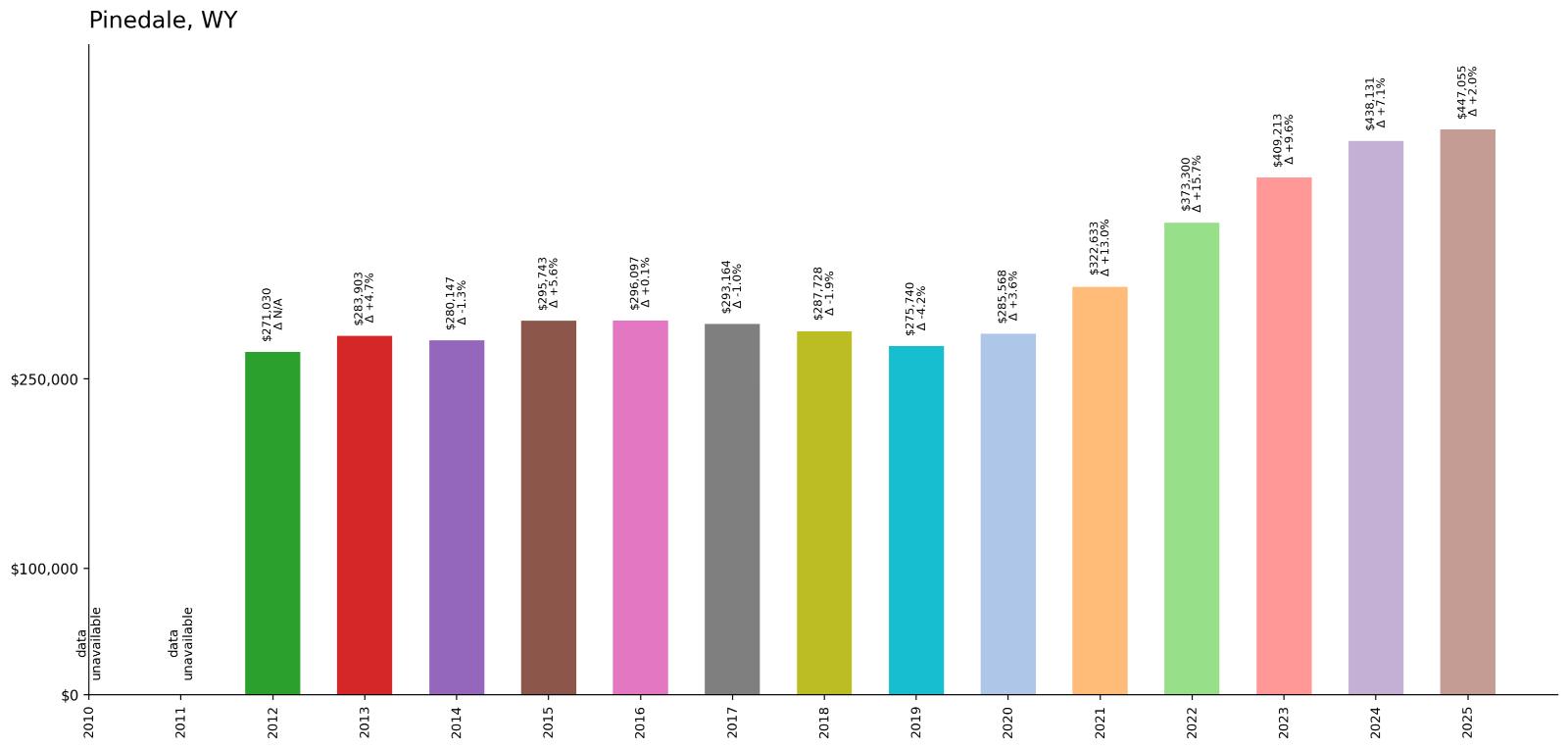
- 2010: N/A
- 2011: N/A
- 2012: $271,030
- 2013: $283,903
- 2014: $280,147
- 2015: $295,743
- 2016: $296,097
- 2017: $293,164
- 2018: $287,728
- 2019: $275,740
- 2020: $285,568
- 2021: $322,633
- 2022: $373,300
- 2023: $409,213
- 2024: $438,131
- 2025: $447,055
Pinedale has shown steady appreciation since 2012, growing from $271,030 to $447,055 despite some volatility in the mid-2010s. The strongest growth occurred after 2020, with values accelerating from $285,568 to current levels above $447,000. The community has recovered from energy sector downturns and established sustained growth momentum.
Why Pinedale?
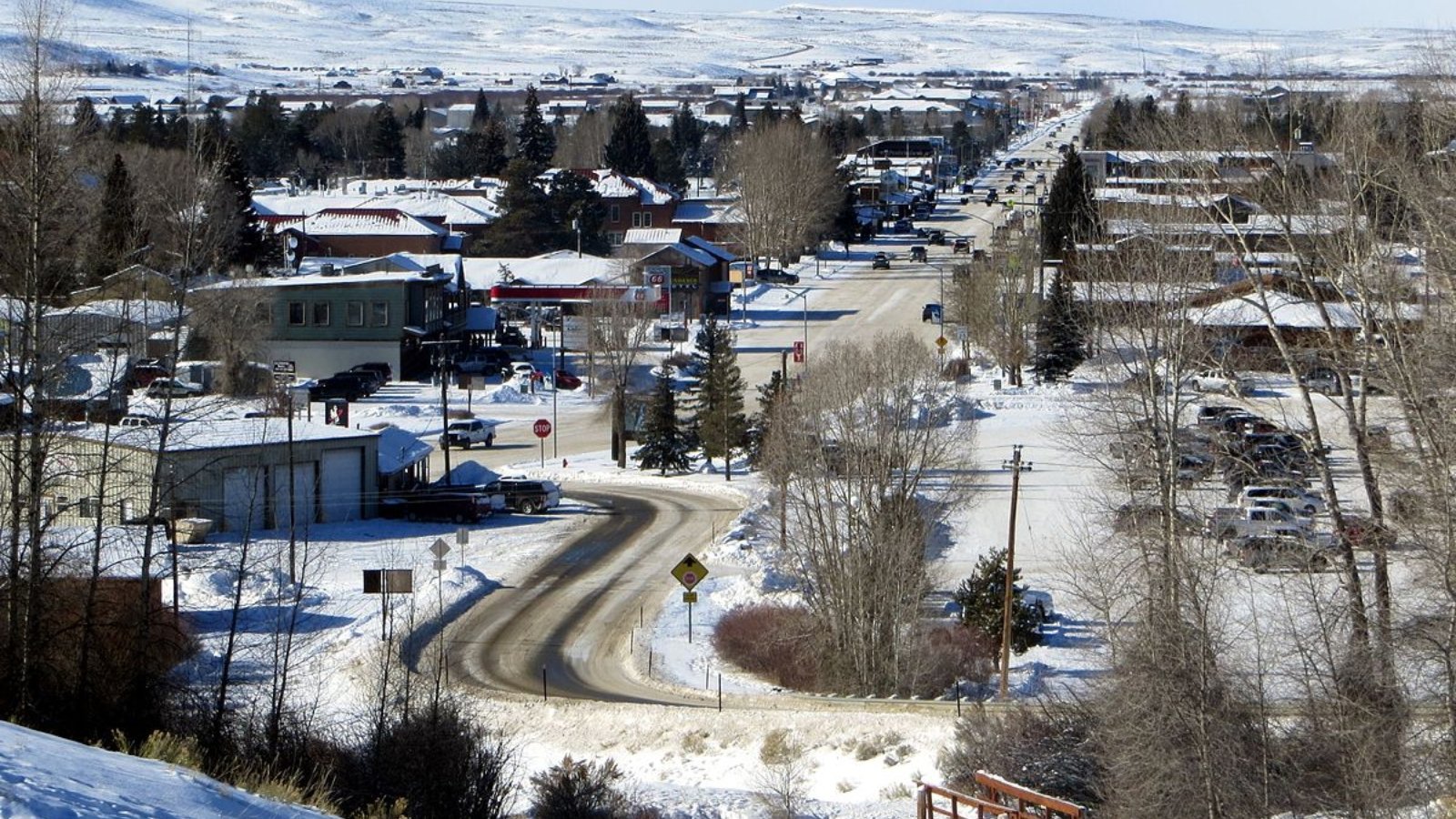
Why are people willing to pay so much to live here? What’s special about it?
Pinedale sits at the gateway to the Wind River Mountains and provides access to some of Wyoming’s most pristine wilderness areas. The community offers residents world-class fishing, hunting, hiking, and mountaineering opportunities while maintaining small-town character and western heritage. Outdoor enthusiasts value the area’s proximity to over 1,000 alpine lakes and extensive wilderness areas that provide unlimited recreation opportunities.
The town benefits from its position as a supply center for both energy development and outdoor recreation, creating economic diversity and stability. Property values reflect demand from outdoor professionals, retirees, and second-home owners who want access to premier mountain recreation. The area’s natural beauty, recreational opportunities, and authentic western atmosphere create strong appeal among buyers seeking mountain lifestyle opportunities.
How Pinedale Rose to Prominence
Pinedale was established in 1904 as a supply center for area ranches and homesteads in the upper Green River valley. The town developed around the cattle industry and served as a shipping point when the railroad reached the area. Its location at the base of the Wind River Mountains made it a natural staging area for mountain commerce and early recreational activities.
The community gained national recognition as a center for energy development with the discovery of major natural gas reserves in the early 2000s. The Jonah Field and Pinedale Anticline became some of America’s most productive natural gas areas, bringing rapid economic growth and development. Despite energy sector volatility, Pinedale has established itself as a premier outdoor recreation destination, with the nearby Wind River Mountains attracting visitors from around the world.
3 Interesting Tidbits
1. Green River Lakes – Pinedale provides access to the spectacular Green River Lakes, where the Continental Divide creates some of Wyoming’s most photographed mountain scenery.
2. Museum of the Mountain Man – The town hosts an excellent museum dedicated to the fur trade era, when mountain men gathered annually at nearby Horse Creek for rendezvous.
3. Wind River Wilderness – Pinedale serves as the primary access point to over 600 miles of trails in the Wind River Mountains, including Wyoming’s highest peak, Gannett Peak.
17. Dubois – 106% Home Price Increase Since 2010
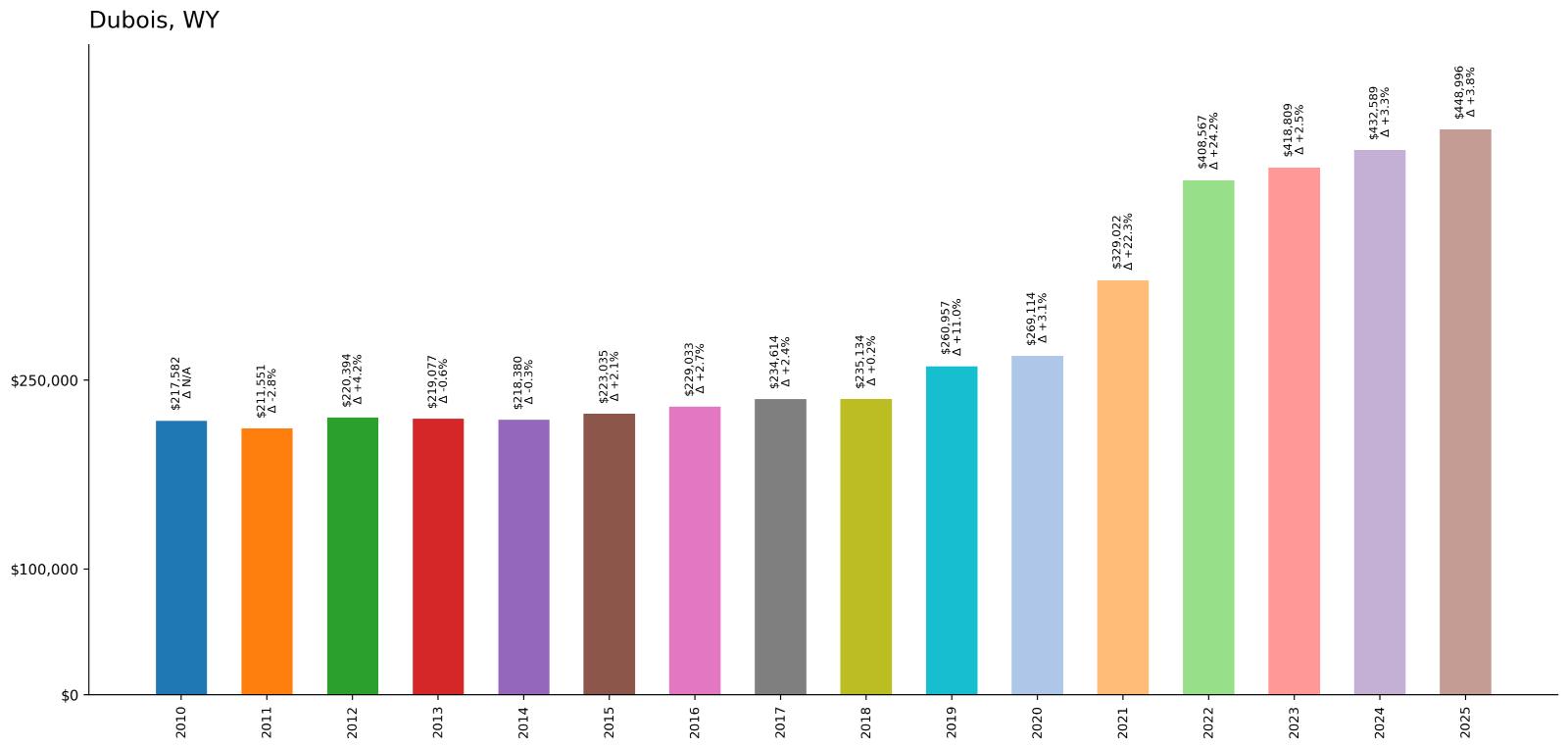
- 2010: $217,582
- 2011: $211,551
- 2012: $220,394
- 2013: $219,077
- 2014: $218,380
- 2015: $223,035
- 2016: $229,033
- 2017: $234,614
- 2018: $235,134
- 2019: $260,957
- 2020: $269,114
- 2021: $329,022
- 2022: $408,567
- 2023: $418,809
- 2024: $432,589
- 2025: $448,996
Dubois has more than doubled in value since 2010, showing dramatic acceleration after 2020. Values climbed steadily from $217,582 in 2010 before accelerating rapidly from $269,114 in 2020 to current levels above $448,000. The community represents one of Wyoming’s strongest long-term growth stories in the outdoor recreation sector.
Why Dubois?
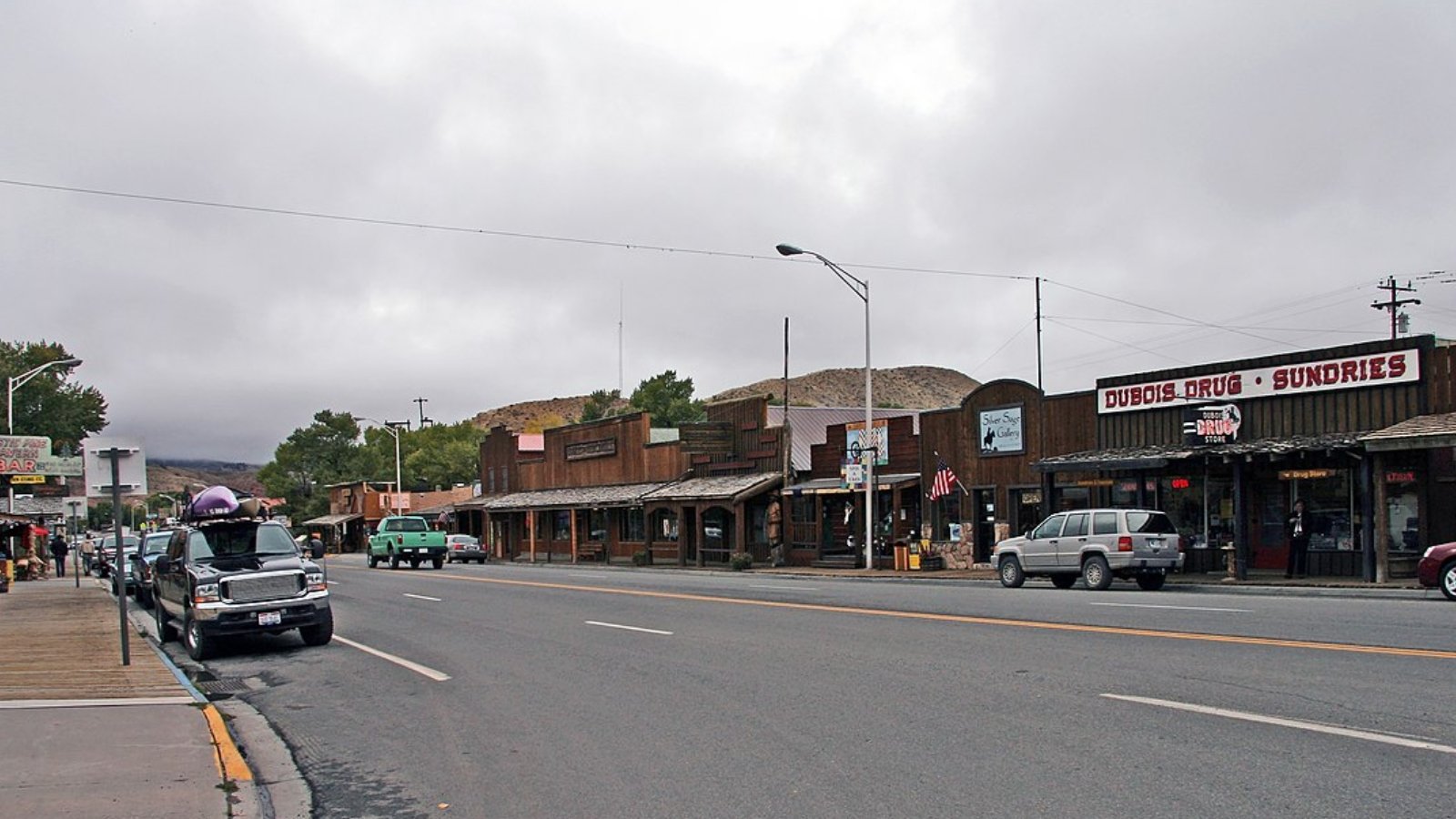
Why are people willing to pay so much to live here? What’s special about it?
Dubois offers residents authentic Old West character with immediate access to both Yellowstone National Park and the Wind River Mountains. The community provides world-class outdoor recreation including fishing, hunting, horseback riding, and wildlife viewing while maintaining genuine western heritage and small-town atmosphere. Outdoor enthusiasts appreciate the area’s diverse recreation opportunities and proximity to some of America’s most pristine wilderness areas.
The town benefits from its strategic location between major recreation destinations and its role as a supply center for dude ranches and outdoor outfitters. Property values reflect strong demand from buyers seeking mountain living with authentic western character and premier outdoor access. The combination of natural beauty, recreation opportunities, and cultural heritage creates sustained appeal among those seeking genuine western lifestyle opportunities.
How Dubois Rose to Prominence
Dubois was established in the 1880s as a tie-hack town, where workers cut railroad ties from the surrounding forests for the expanding western railroad system. The community developed around logging operations and cattle ranching, taking advantage of the fertile Wind River valley for agriculture and livestock production. Its location made it a natural supply center for area ranches and mountain operations.
The town’s character was shaped by its role in the western livestock industry and its position as a gateway to Yellowstone’s east entrance. Dubois became known for its authentic western atmosphere and the development of dude ranches that attracted eastern visitors seeking genuine cowboy experiences. The community’s proximity to both Yellowstone and the Wind River Mountains established it as a premier destination for outdoor recreation and western tourism.
3 Interesting Tidbits
1. Tie-Hack Heritage – Dubois preserves its history as a tie-hack town where workers cut millions of railroad ties from surrounding forests, with artifacts and exhibits celebrating this unique heritage.
2. National Bighorn Sheep Center – The town is home to a world-class interpretive center dedicated to Rocky Mountain bighorn sheep, with guided tours to view these magnificent animals in their natural habitat.
3. Wind River Valley – Dubois sits in the spectacular Wind River valley, providing access to over 2.2 million acres of wilderness and some of the most pristine backcountry in the lower 48 states.
16. Boulder – 57% Home Price Increase Since 2017
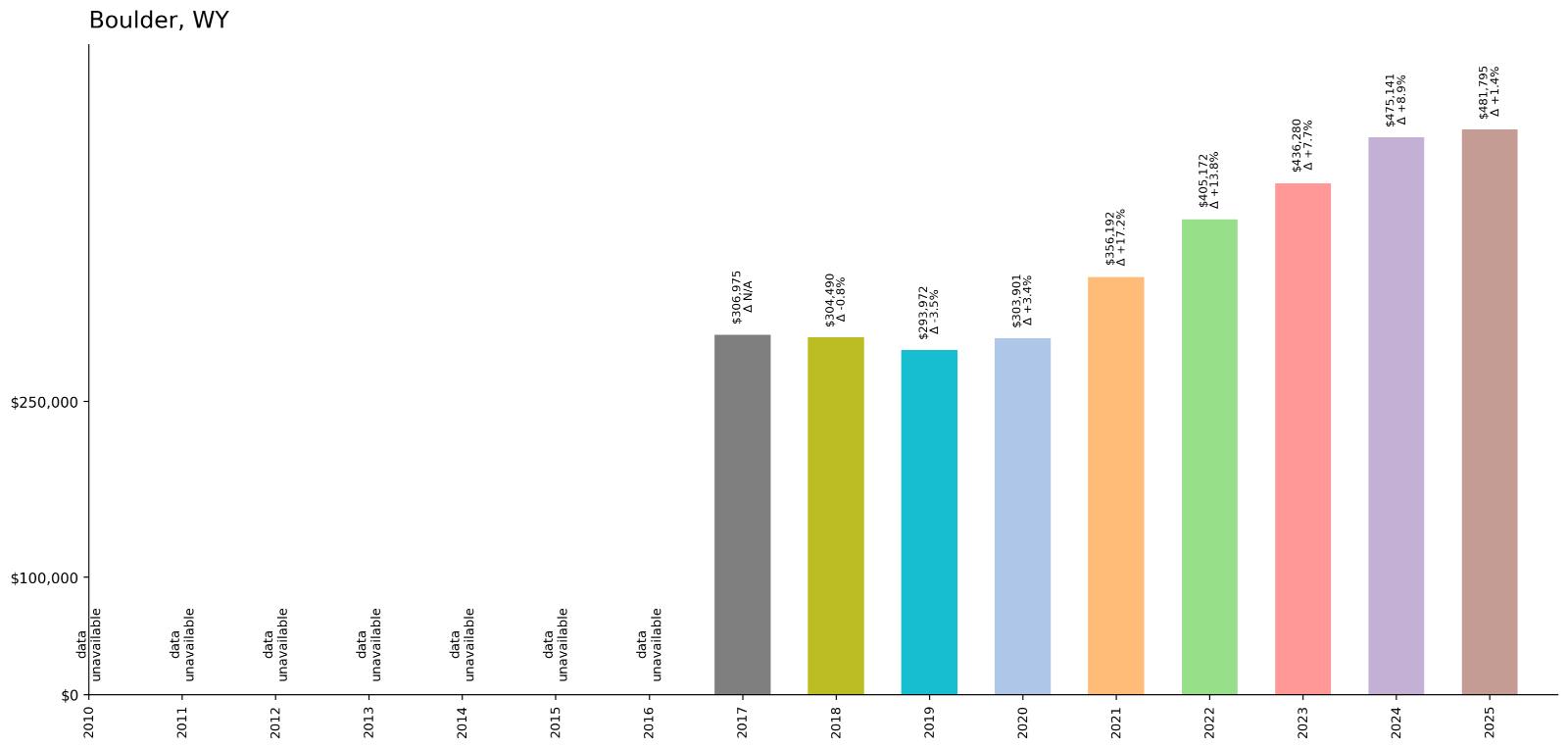
- 2010: N/A
- 2011: N/A
- 2012: N/A
- 2013: N/A
- 2014: N/A
- 2015: N/A
- 2016: N/A
- 2017: $306,975
- 2018: $304,490
- 2019: $293,972
- 2020: $303,901
- 2021: $356,192
- 2022: $405,172
- 2023: $436,280
- 2024: $475,141
- 2025: $481,795
Boulder has experienced strong appreciation since 2017, growing from $306,975 to $481,795 despite some early volatility. The community showed particularly strong growth after 2020, with values accelerating from $303,901 to current levels approaching $482,000. This southwest Wyoming community has established consistent upward momentum in recent years.
Why Boulder?
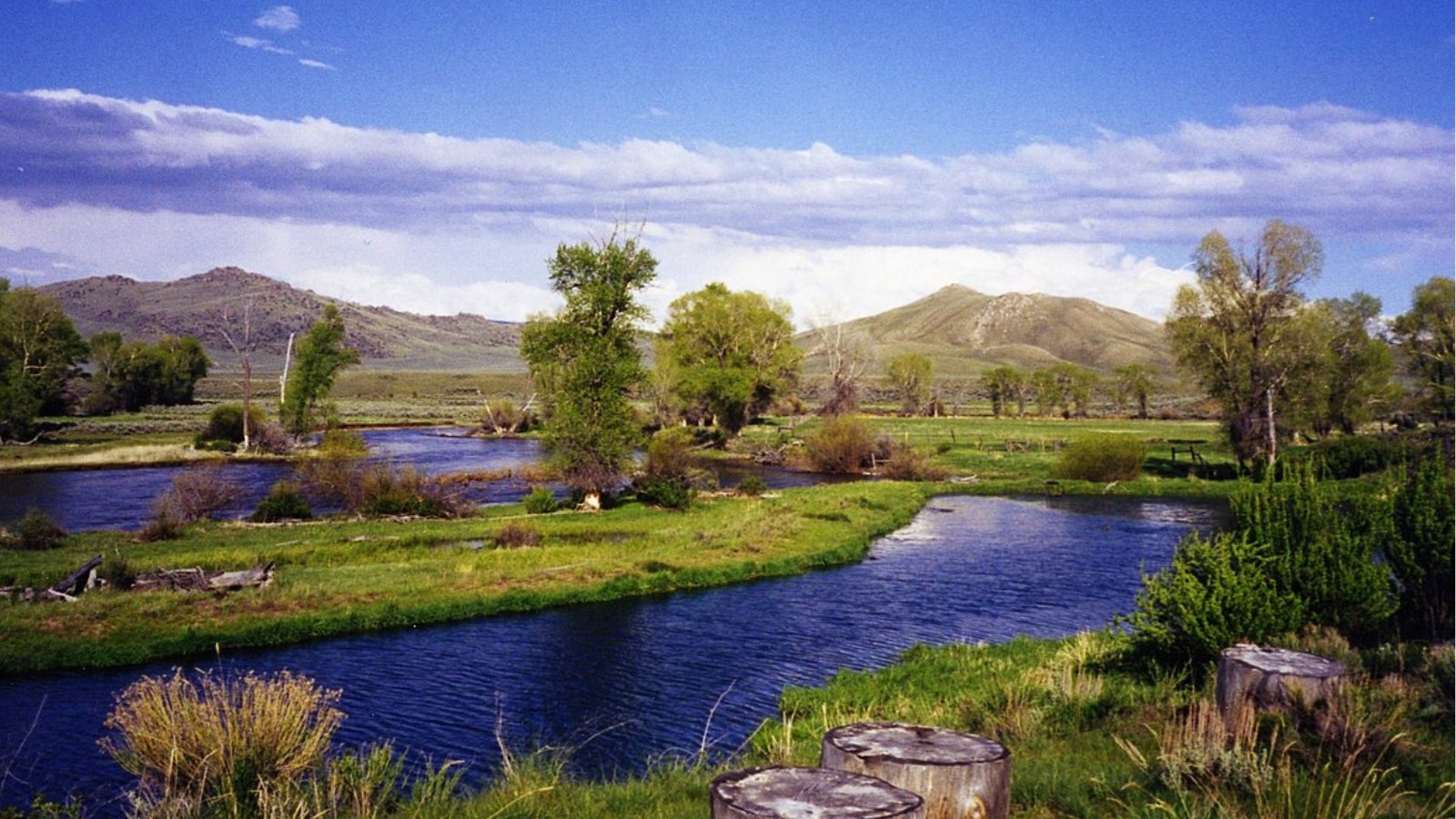
Why are people willing to pay so much to live here? What’s special about it?
Boulder provides residents with access to premier fishing and hunting areas while maintaining a small-town western atmosphere. The community serves as a gateway to the Wind River Mountains and offers excellent access to wilderness areas and outdoor recreation opportunities. Residents appreciate the area’s authentic western character, outdoor access, and proximity to some of Wyoming’s most productive fishing and hunting areas.
The town benefits from its location in prime recreation country and its role as a supply center for outfitters and outdoor enthusiasts. Property values reflect demand from buyers seeking rural living with world-class outdoor recreation access and authentic western lifestyle opportunities. The area’s natural beauty and recreation opportunities create consistent interest among outdoor professionals and retirees.
How Boulder Rose to Prominence
Boulder was established in the early 1900s as a supply center for area ranches and mining operations in the Wind River Mountains. The community developed around agriculture and livestock production, serving the needs of homesteaders and ranchers in the upper Green River valley. Its location made it a natural staging area for mountain commerce and seasonal grazing operations.
The town’s prominence grew with the development of outfitting and guide services that took advantage of the area’s exceptional hunting and fishing opportunities. Boulder became known among sportsmen for its access to pristine wilderness areas and productive fishing waters. The community’s role as a recreation hub was enhanced by its authentic western character and the quality of outdoor opportunities in the surrounding mountains and valleys.
3 Interesting Tidbits
1. Fishing Paradise – Boulder provides access to some of Wyoming’s most productive fishing waters, including world-class trout fishing in nearby mountain streams and lakes.
2. Outfitting Center – The town serves as a base for numerous hunting and fishing outfitters who guide clients into the Wind River Mountains and surrounding wilderness areas.
3. Western Heritage – Boulder maintains authentic western character with working ranches and traditional livestock operations that preserve the area’s agricultural heritage.
15. Daniel – 51% Home Price Increase Since 2017
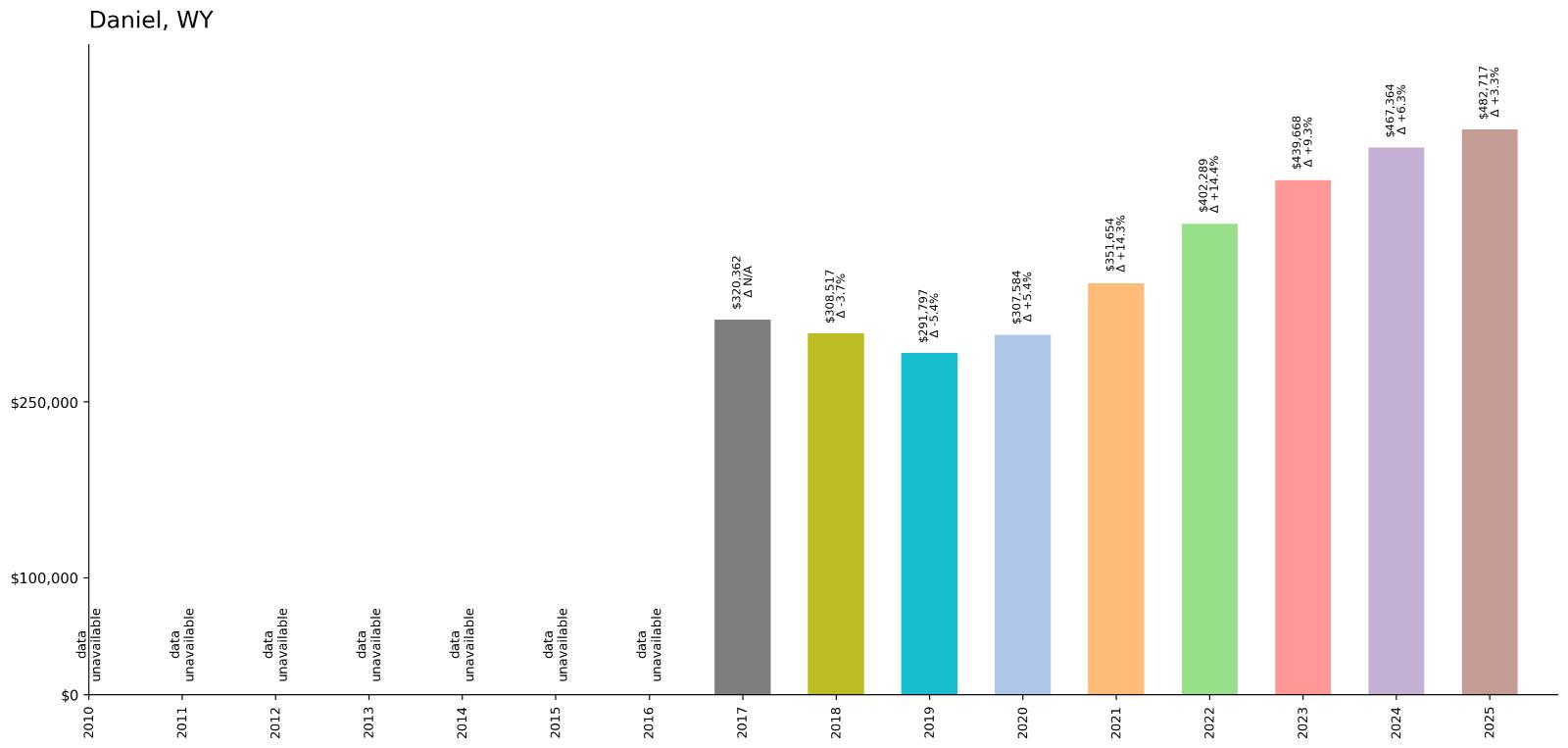
- 2010: N/A
- 2011: N/A
- 2012: N/A
- 2013: N/A
- 2014: N/A
- 2015: N/A
- 2016: N/A
- 2017: $320,362
- 2018: $308,517
- 2019: $291,797
- 2020: $307,584
- 2021: $351,654
- 2022: $402,289
- 2023: $439,668
- 2024: $467,364
- 2025: $482,717
Daniel has shown solid appreciation since 2017, growing from $320,362 to $482,717 despite some mid-period volatility. The community experienced strong acceleration after 2020, with values climbing from $307,584 to current levels above $482,000. This represents consistent recent growth in this southwest Wyoming mountain community.
Why Daniel?
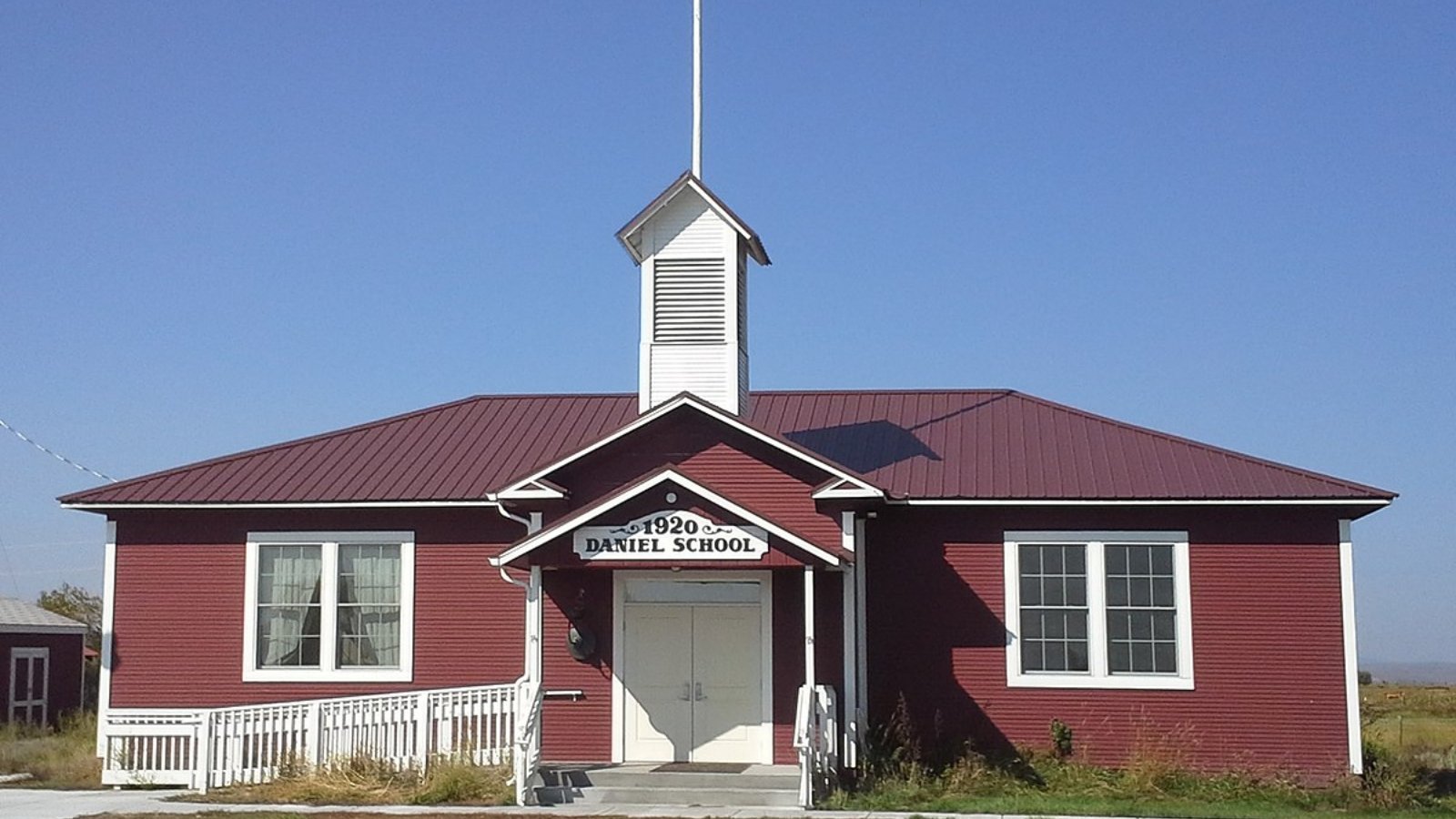
Why are people willing to pay so much to live here? What’s special about it?
Daniel offers residents access to the Green River and surrounding mountain country while maintaining authentic western character and small-town atmosphere. The community provides excellent fishing, hunting, and outdoor recreation opportunities with proximity to wilderness areas and productive agricultural lands. Families appreciate the area’s rural lifestyle, outdoor access, and traditional western values that define the community.
The town benefits from its location in prime recreation and agricultural country, serving both ranching operations and outdoor enthusiasts. Property values reflect demand from buyers seeking rural living with excellent outdoor recreation access and authentic western lifestyle opportunities. The area’s natural beauty, recreation potential, and agricultural heritage create sustained interest among those seeking mountain living.
How Daniel Rose to Prominence
Daniel was established in the early 1900s as a ranching community in the upper Green River valley, serving homesteaders and livestock operations that took advantage of the fertile valley lands. The community developed around agriculture and seasonal grazing operations that utilized both valley pastures and mountain meadows. Its location provided access to both agricultural lands and mountain resources.
The town’s character was shaped by its role in the livestock industry and its position as a supply center for area ranches and mountain operations. Daniel became known for its authentic western atmosphere and its connection to traditional ranching practices. The community’s prominence grew with the development of recreation and tourism that took advantage of the area’s natural beauty and outdoor opportunities.
3 Interesting Tidbits
1. Green River Access – Daniel provides excellent access to the Green River for fishing and floating, with some of Wyoming’s most scenic and productive waters nearby.
2. Ranching Heritage – The community maintains strong connections to traditional livestock operations, with working ranches that preserve authentic western agricultural practices.
3. Mountain Gateway – Daniel serves as a gateway to high-country recreation areas, providing access to mountain meadows, alpine lakes, and wilderness areas in the Wind River Range.
14. Afton – 8% Home Price Increase Since 2023
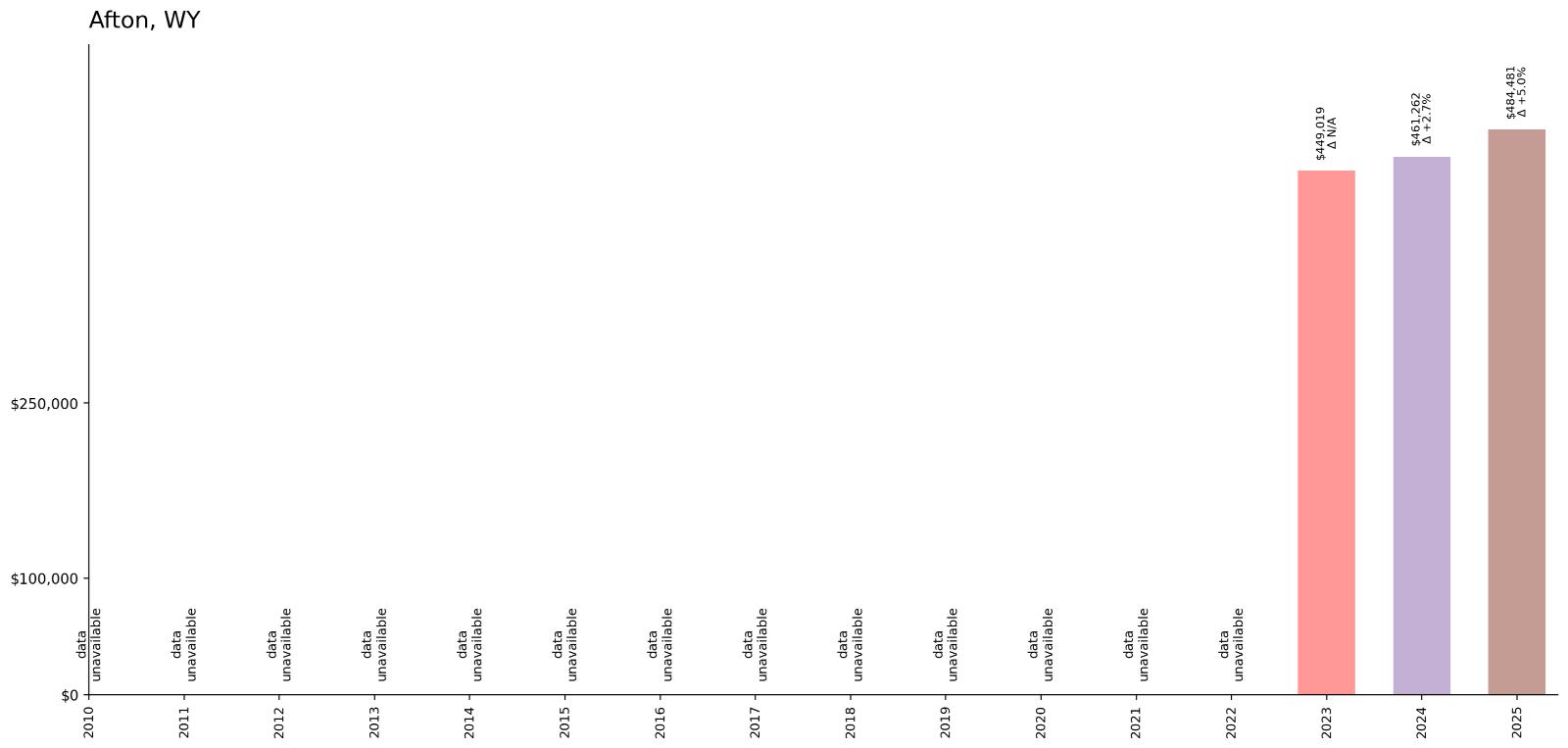
- 2010: N/A
- 2011: N/A
- 2012: N/A
- 2013: N/A
- 2014: N/A
- 2015: N/A
- 2016: N/A
- 2017: N/A
- 2018: N/A
- 2019: N/A
- 2020: N/A
- 2021: N/A
- 2022: N/A
- 2023: $449,019
- 2024: $461,262
- 2025: $484,481
Afton shows limited data availability but demonstrates steady recent growth from $449,019 in 2023 to $484,481 in 2025. Though the percentage increase appears modest at 8% since 2023, the current median home price above $484,000 places Afton among Wyoming’s more expensive communities in Star Valley.
Why Afton?
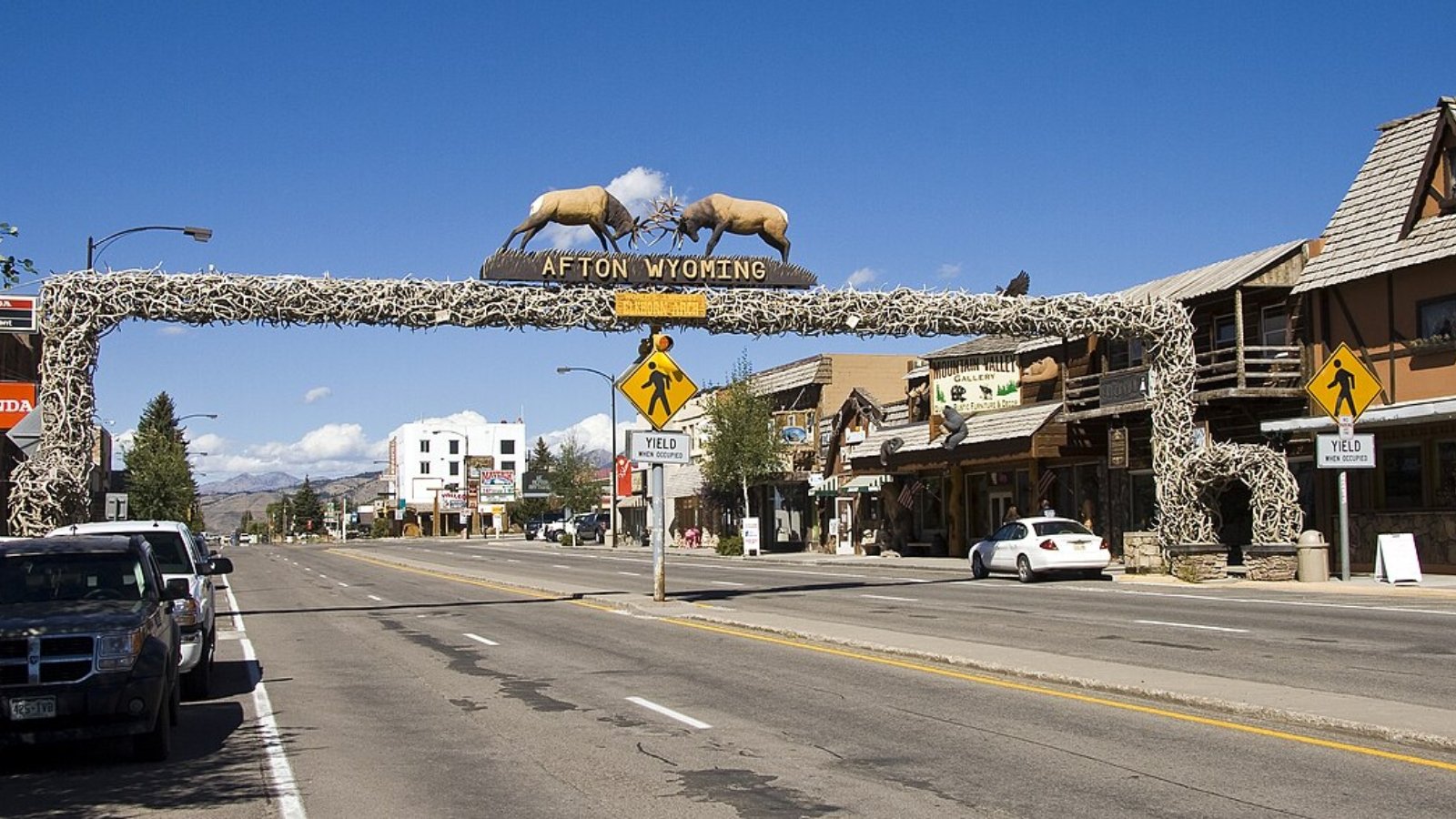
Why are people willing to pay so much to live here? What’s special about it?
Afton serves as the commercial center of scenic Star Valley, offering residents mountain living with small-city amenities and four-season recreation opportunities. The community provides access to world-class skiing, fishing, hunting, and hiking while maintaining proximity to Jackson Hole and Salt Lake City employment markets. Families value the area’s natural beauty, recreational access, and strong community bonds in this alpine valley setting.
The town benefits from its location in Star Valley, one of Wyoming’s most scenic agricultural valleys, surrounded by mountain ranges on all sides. Property values reflect demand from buyers seeking mountain living with good infrastructure and services while maintaining access to outdoor recreation and larger employment markets. The area’s natural beauty, recreation opportunities, and valley atmosphere create sustained interest among mountain lifestyle seekers.
How Afton Rose to Prominence
Afton was settled in 1885 by Mormon pioneers who recognized the agricultural potential of Star Valley’s fertile lands and natural irrigation from surrounding mountains. The community developed as the commercial center for the valley’s farming and livestock operations, taking advantage of the natural hay meadows and water resources. Its location made it the logical hub for trade and services in this isolated mountain valley.
The town’s prominence grew with the development of dairy farming and cheese production, with the famous Afton cheese factory becoming a regional landmark. The community became known for its agricultural productivity and its role as the primary service center for Star Valley’s scattered ranches and farms. Modern Afton benefits from tourism and recreation while maintaining its agricultural heritage and serving as Star Valley’s economic center.
3 Interesting Tidbits
1. Star Valley Cheese – Afton was home to a famous cheese factory that produced award-winning cheese for decades, becoming a regional landmark and tourist attraction.
2. Elk Arch – The town is famous for its elk antler arch spanning Main Street, made from hundreds of naturally shed elk antlers collected from the surrounding mountains.
3. Periodic Spring – Near Afton is one of only three periodic springs in the world, a natural phenomenon where the spring turns on and off at regular intervals due to underground siphoning action.
13. Rozet – 81% Home Price Increase Since 2011
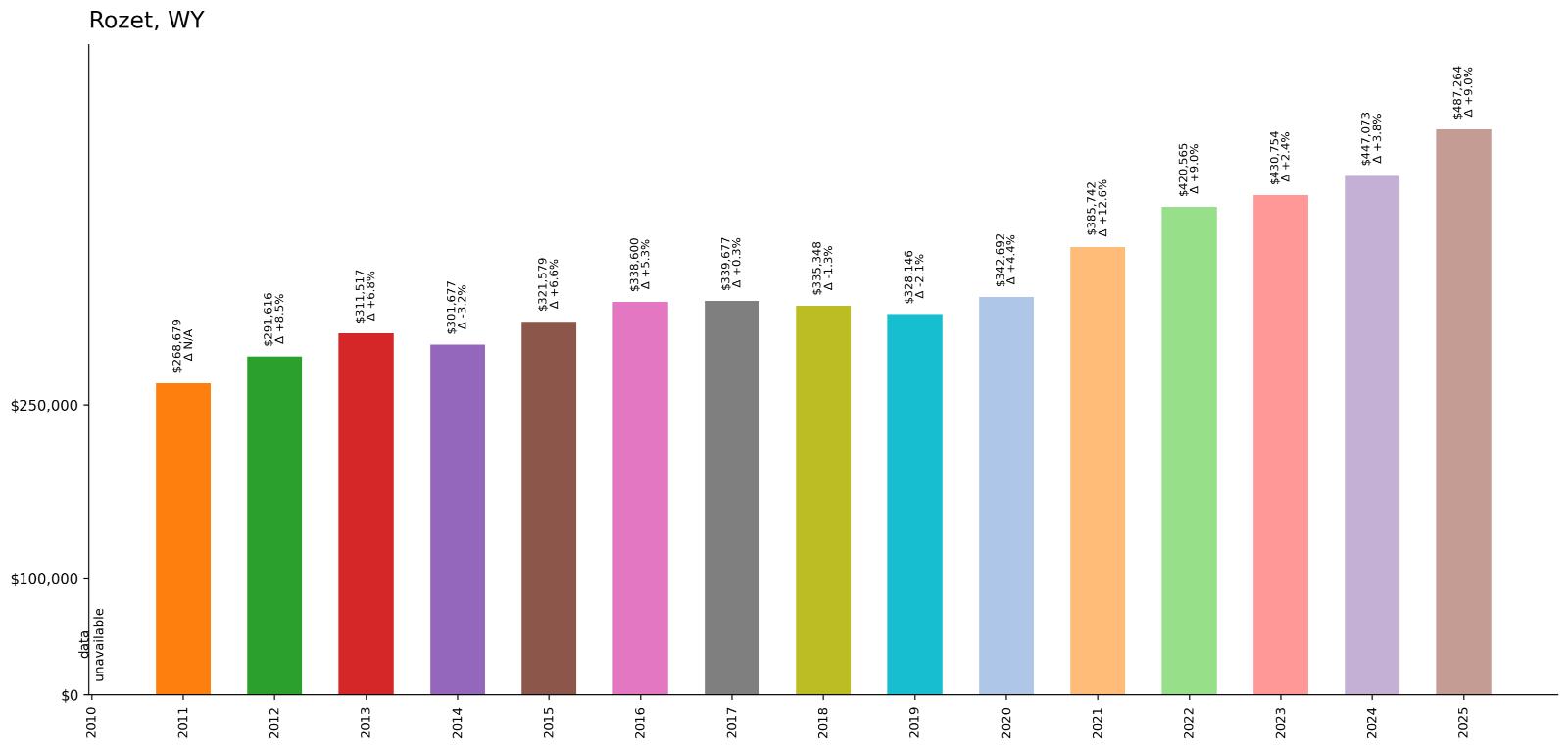
- 2010: N/A
- 2011: $268,679
- 2012: $291,616
- 2013: $311,517
- 2014: $301,677
- 2015: $321,579
- 2016: $338,600
- 2017: $339,677
- 2018: $335,348
- 2019: $328,146
- 2020: $342,692
- 2021: $385,742
- 2022: $420,565
- 2023: $430,754
- 2024: $447,073
- 2025: $487,264
Rozet has shown strong appreciation since 2011, growing from $268,679 to $487,264. The community experienced consistent growth through the 2010s before accelerating after 2020, with particularly strong gains in 2025. Current median prices approaching $487,000 reflect sustained demand in this northeast Wyoming community near major energy operations.
Why Rozet?

Why are people willing to pay so much to live here? What’s special about it?
Rozet offers residents rural living with proximity to Gillette’s employment opportunities and energy sector jobs while maintaining small-town character and open spaces. The community provides larger lots, newer homes, and access to outdoor recreation in the nearby Black Hills and Thunder Basin areas. Families appreciate the area’s safety, space, and proximity to both employment centers and recreational opportunities.
The town benefits from its location near major energy operations while offering residential appeal for workers seeking rural living options. Property values reflect demand from energy sector workers and others who want space and privacy while maintaining reasonable commuting distance to jobs. The area’s economic stability through energy development and its rural character create consistent housing demand.
How Rozet Rose to Prominence
Rozet developed as a small ranching community in the early 1900s, serving the scattered homesteads and livestock operations in northeastern Wyoming. The community remained primarily agricultural until the development of nearby coal mines and oil fields brought industrial employment to the region. Its location along transportation corridors made it accessible to workers in the expanding energy sector.
The town’s prominence grew with the boom in Wyoming’s energy industry, particularly coal mining in the Powder River Basin and oil development in surrounding areas. Rozet became attractive to energy workers seeking rural living options with reasonable access to job sites. The community’s growth reflects the broader development of northeastern Wyoming’s energy resources and the housing needs of workers in these industries.
3 Interesting Tidbits
1. Energy Hub – Rozet sits in the heart of the Powder River Basin, one of America’s most productive coal mining regions and a major center for oil and gas development.
2. Rural Schools – The community is served by Rozet Elementary School, which maintains small class sizes and strong community involvement typical of rural Wyoming education.
3. Open Range – The area around Rozet remains largely open range country, where cattle and wildlife roam freely across vast grasslands and energy development coexists with traditional agriculture.
12. Carpenter – 114% Home Price Increase Since 2010
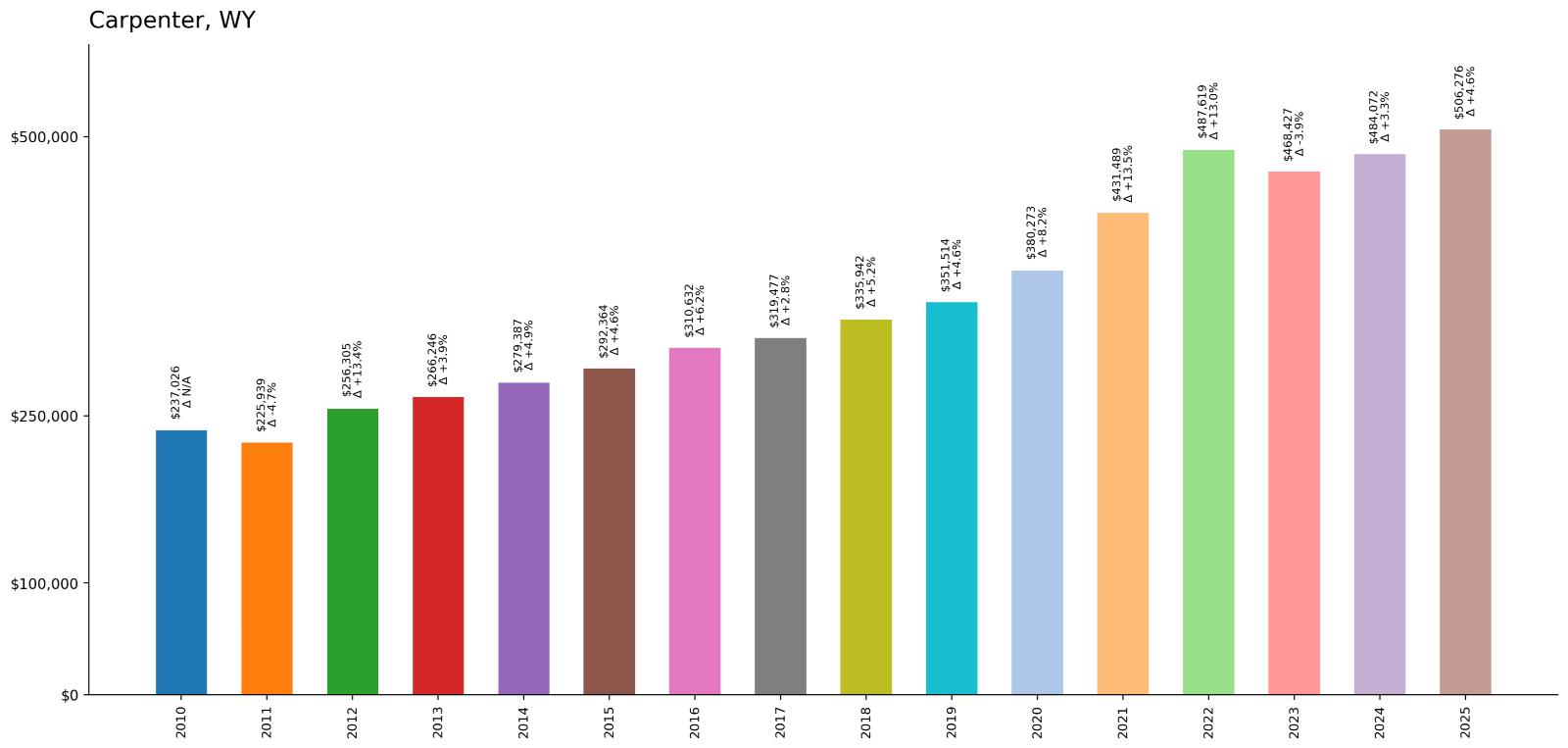
- 2010: $237,026
- 2011: $225,939
- 2012: $256,305
- 2013: $266,246
- 2014: $279,387
- 2015: $292,364
- 2016: $310,632
- 2017: $319,477
- 2018: $335,942
- 2019: $351,514
- 2020: $380,273
- 2021: $431,489
- 2022: $487,619
- 2023: $468,427
- 2024: $484,072
- 2025: $506,276
Carpenter has more than doubled in value since 2010, showing remarkably consistent growth over 15 years. The steepest acceleration occurred between 2021 and 2022, when values jumped from $431,489 to $487,619. Current median home prices above $506,000 reflect sustained demand in this southeast Wyoming community near Cheyenne.
Why Carpenter?
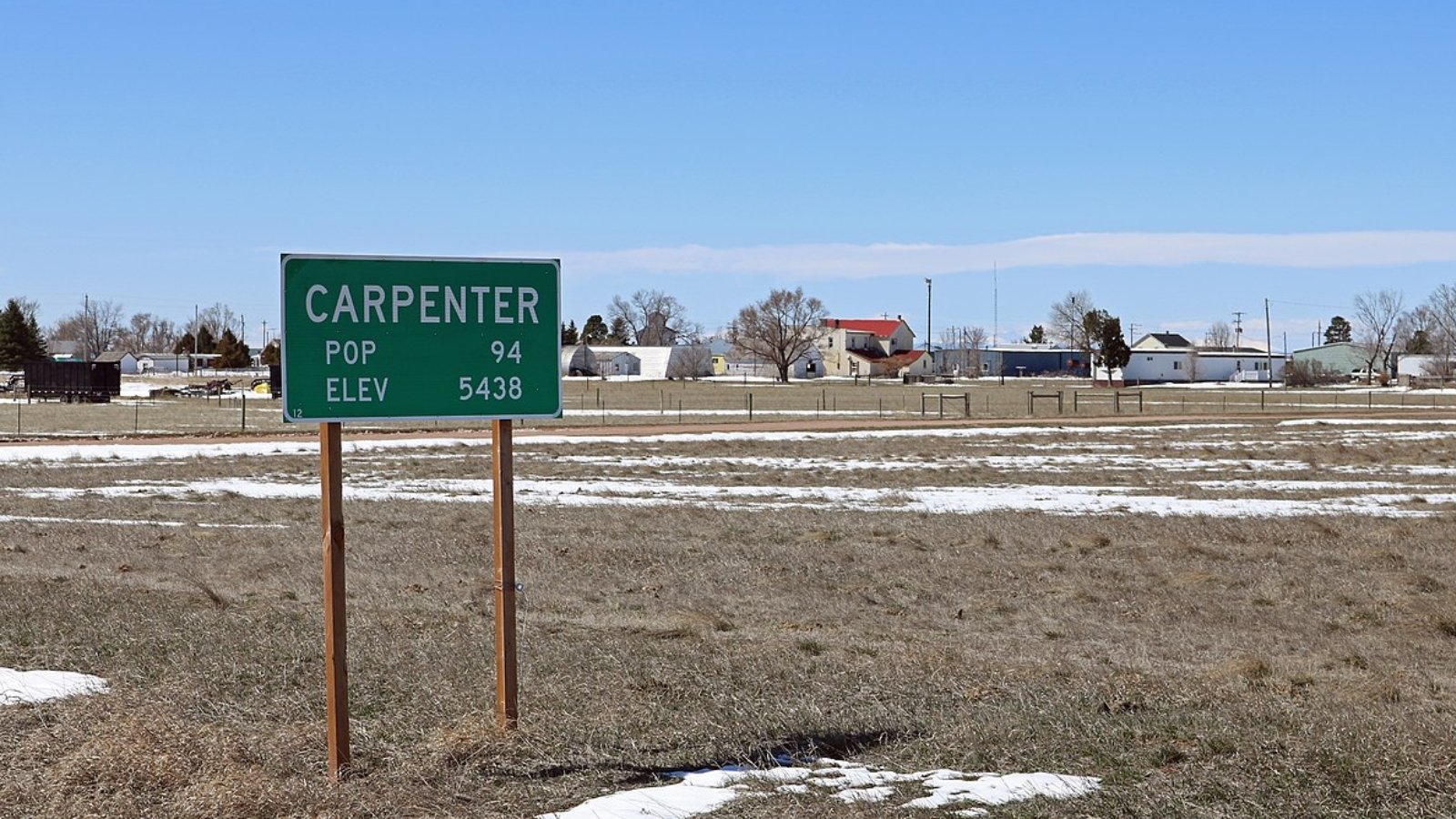
Why are people willing to pay so much to live here? What’s special about it?
Carpenter provides residents with rural living and larger properties while maintaining reasonable access to Cheyenne’s employment opportunities and urban amenities. The community offers wide-open spaces, agricultural character, and proximity to outdoor recreation in the Medicine Bow Mountains. Families value the area’s rural lifestyle, safety, and access to both employment centers and recreational opportunities.
The town benefits from its location near Cheyenne while maintaining rural character and agricultural heritage that appeals to those seeking country living. Property values reflect demand from professionals who work in Cheyenne but prefer rural residential settings with space and privacy. The area’s proximity to the state capital and outdoor recreation creates consistent interest among homebuyers seeking rural lifestyle opportunities.
How Carpenter Rose to Prominence
Carpenter was established in the early 1900s as a railroad town along the Union Pacific line, serving as a shipping point for area ranches and agricultural operations. The community developed around livestock and farming activities that took advantage of the fertile Laramie River valley lands. Its location along the railroad made it a natural commercial center for surrounding agricultural areas.
The town’s character was shaped by its agricultural heritage and its role as a supply center for area ranches and farms. Carpenter remained primarily agricultural until suburban expansion from Cheyenne began attracting residents seeking rural living with urban access. The community’s prominence grew as families and professionals discovered the benefits of country living while maintaining access to Cheyenne’s employment opportunities and services.
3 Interesting Tidbits
1. Railroad Heritage – Carpenter maintains its connection to railroad history, with the Union Pacific line still playing an important role in the community’s character and transportation access.
2. Agricultural Roots – The area continues to support working ranches and farms that preserve traditional agricultural practices and contribute to the community’s rural character.
3. Cheyenne Access – Carpenter provides rural living with easy access to Cheyenne’s employment, shopping, and cultural opportunities, making it popular with commuters seeking country lifestyle.
11. Cody – 127% Home Price Increase Since 2010
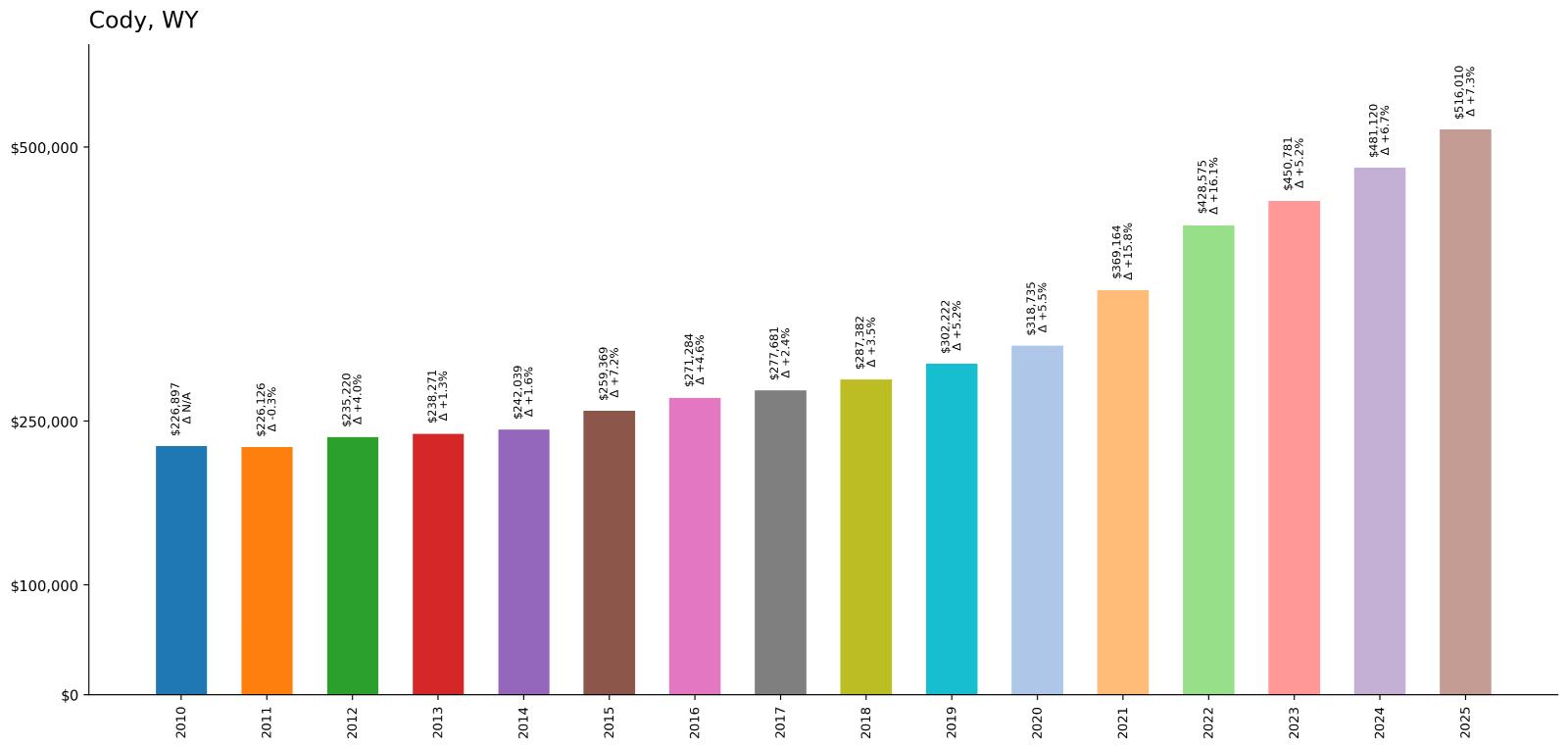
- 2010: $226,897
- 2011: $226,126
- 2012: $235,220
- 2013: $238,271
- 2014: $242,039
- 2015: $259,369
- 2016: $271,284
- 2017: $277,681
- 2018: $287,382
- 2019: $302,222
- 2020: $318,735
- 2021: $369,164
- 2022: $428,575
- 2023: $450,781
- 2024: $481,120
- 2025: $516,010
Cody has more than doubled in value since 2010, showing remarkable consistency before accelerating dramatically after 2020. Values climbed steadily from $226,897 in 2010 to $318,735 in 2020, then surged to current levels above $516,000. As the eastern gateway to Yellowstone National Park, Cody represents one of Wyoming’s strongest tourism-driven housing markets.
Why Cody?

Why are people willing to pay so much to live here? What’s special about it?
Cody offers residents immediate access to Yellowstone National Park while providing authentic western heritage and world-class cultural attractions including the Buffalo Bill Center of the West. The community combines small-city amenities with premier outdoor recreation, featuring the world’s longest-running nightly rodeo and proximity to some of America’s most spectacular natural areas. Families value the area’s cultural richness, outdoor opportunities, and genuine western atmosphere.
The town benefits from its unique position as both a tourism destination and gateway to Yellowstone, creating year-round economic activity and recreational opportunities. Property values reflect strong demand from retirees, tourism professionals, and outdoor enthusiasts who want access to world-class attractions and recreation. The combination of cultural amenities, natural beauty, and tourism economy creates sustained interest among buyers seeking authentic western living with modern conveniences.
How Cody Rose to Prominence
Cody was founded in 1896 by Buffalo Bill Cody, the famous showman and western legend who recognized the area’s potential for tourism and development. The town was strategically located to serve as the eastern entrance to Yellowstone National Park, which had been established in 1872. Buffalo Bill’s vision included developing the area as a base for visitors to Yellowstone while showcasing authentic western culture and heritage.
The community’s growth was fueled by tourism to Yellowstone and the development of guest ranches and western entertainment that capitalized on Buffalo Bill’s fame and the area’s natural beauty. The establishment of the Buffalo Bill Historical Center (now the Buffalo Bill Center of the West) cemented Cody’s role as a premier western cultural destination. The town’s proximity to Yellowstone and its authentic western character established it as one of America’s premier western tourism destinations.
3 Interesting Tidbits
1. Buffalo Bill’s Town – Cody was founded by and named after Buffalo Bill Cody, and his original Irma Hotel still operates today, maintaining its historic western character and atmosphere.
2. Nightly Rodeo – Cody hosts the world’s longest-running nightly rodeo, featuring authentic cowboys and cowgirls competing every summer evening from June through August.
3. World-Class Museums – The Buffalo Bill Center of the West houses five museums and is considered one of the finest western heritage and art complexes in the world.
10. Aladdin – 102% Home Price Increase Since 2016
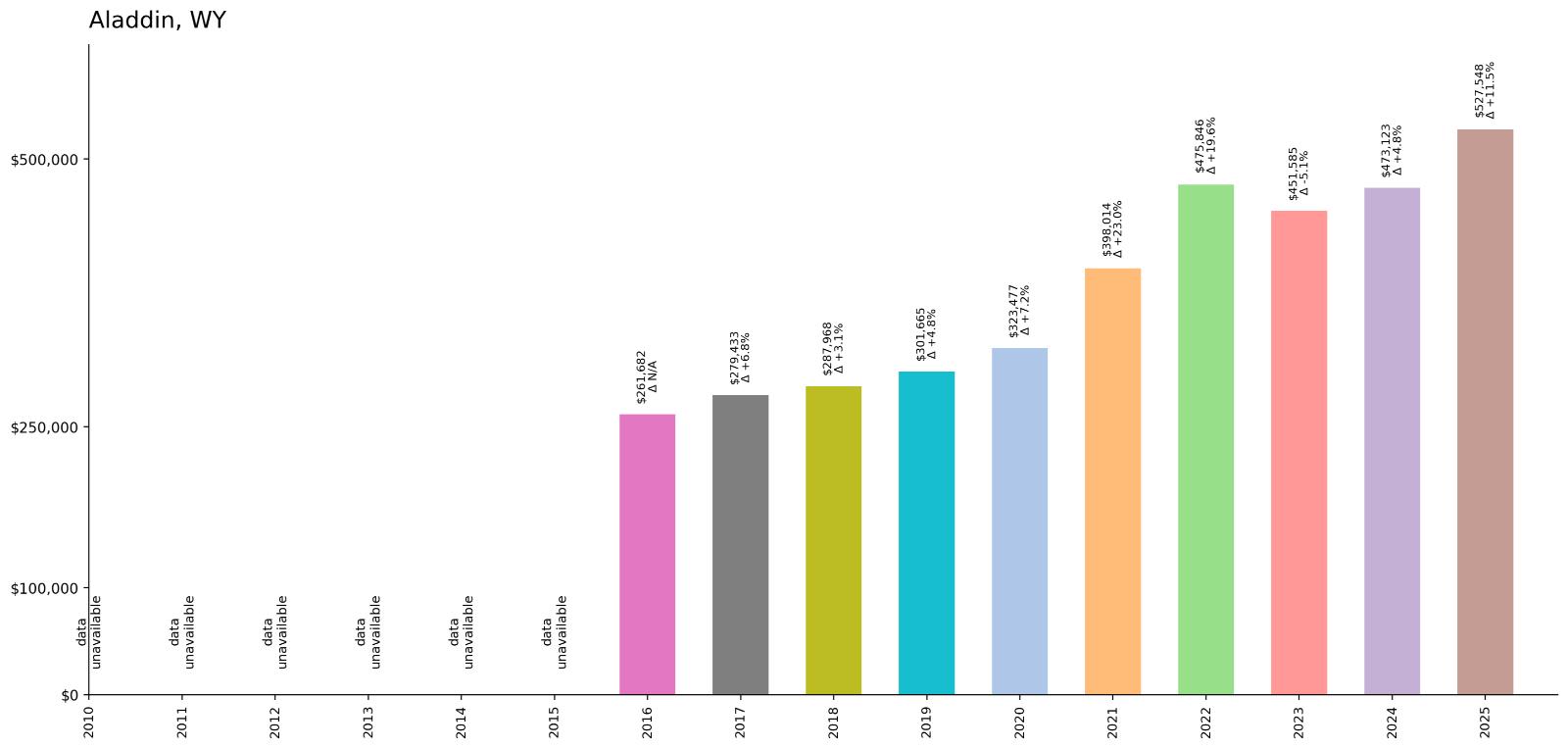
- 2010: N/A
- 2011: N/A
- 2012: N/A
- 2013: N/A
- 2014: N/A
- 2015: N/A
- 2016: $261,682
- 2017: $279,433
- 2018: $287,968
- 2019: $301,665
- 2020: $323,477
- 2021: $398,014
- 2022: $475,846
- 2023: $451,585
- 2024: $473,123
- 2025: $527,548
Aladdin has more than doubled in value since 2016, showing consistent growth before accelerating dramatically after 2020. The community experienced its strongest appreciation between 2021 and 2022, when values jumped from $398,014 to $475,846. Current median prices above $527,000 reflect sustained demand in this northeast Wyoming community near the Black Hills.
Why Aladdin?
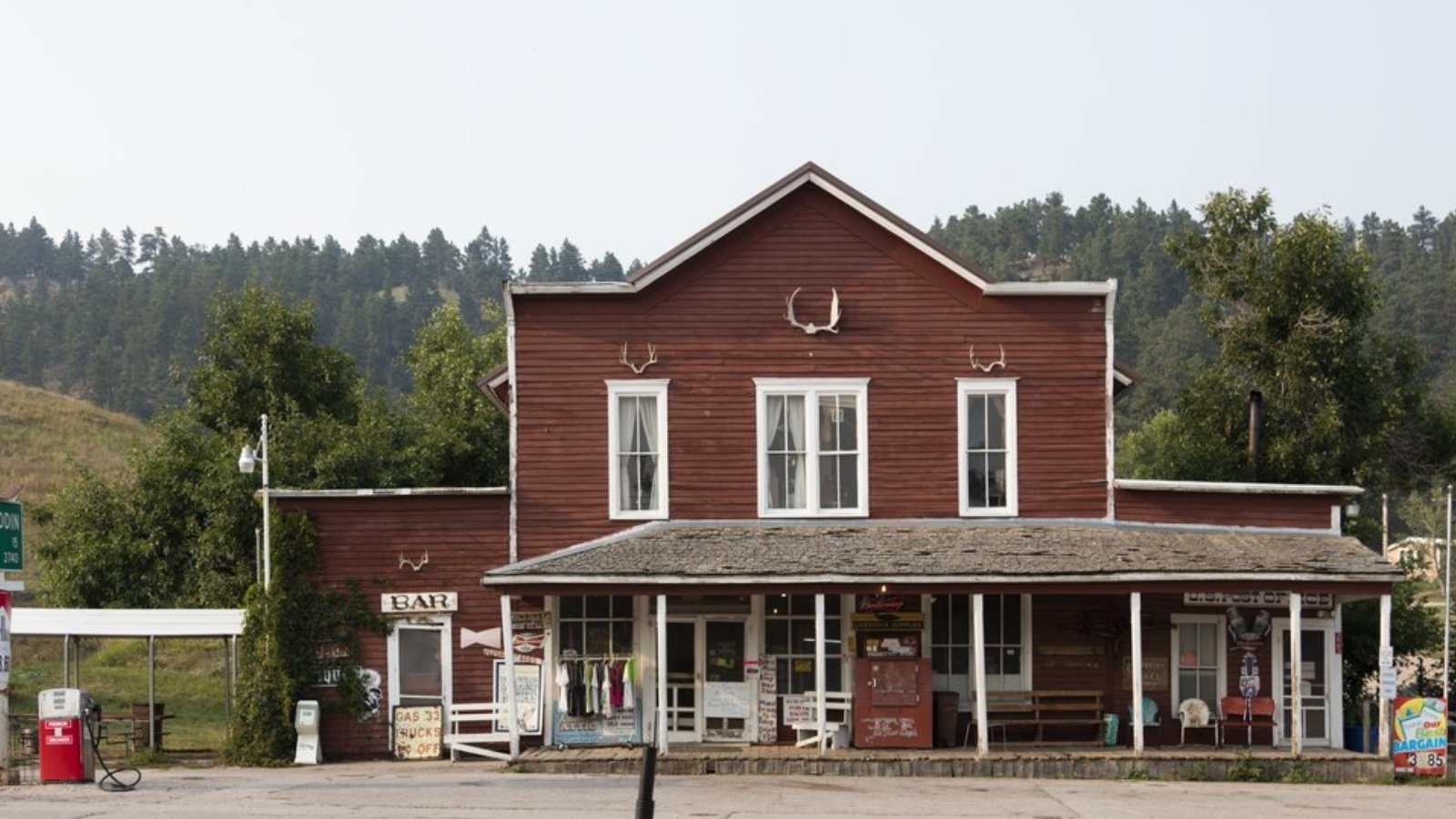
Why are people willing to pay so much to live here? What’s special about it?
Aladdin provides residents with access to the Black Hills recreation area while maintaining small-town character and proximity to regional attractions including Devils Tower and Spearfish Canyon. The community offers rural living with excellent outdoor recreation opportunities including hiking, fishing, hunting, and seasonal tourism revenue potential. Families appreciate the area’s natural beauty, outdoor access, and proximity to both Wyoming and South Dakota recreational opportunities.
The town benefits from its location near the Black Hills and its position along tourist routes connecting major regional attractions. Property values reflect demand from outdoor enthusiasts and those seeking rural living with access to diverse recreation opportunities. The area’s scenic beauty, tourism potential, and proximity to multiple states create sustained interest among buyers seeking mountain living opportunities.
How Aladdin Rose to Prominence
Aladdin was established in the early 1900s as a supply center for area ranches and logging operations in the Black Hills region. The community developed around the timber industry and cattle ranching, serving the needs of operations that took advantage of both forest resources and grazing lands. Its location made it a natural stopping point for commerce between Wyoming and the Black Hills of South Dakota.
The town’s character was shaped by its role in the regional timber and livestock industries and its position along transportation routes connecting Wyoming with the Black Hills. Aladdin became known for its authentic western atmosphere and its access to outdoor recreation in the Black Hills region. The community’s prominence grew with the development of tourism and recreation that took advantage of the area’s natural beauty and proximity to regional attractions.
3 Interesting Tidbits
1. Black Hills Gateway – Aladdin serves as a gateway to the Black Hills region, providing access to recreational opportunities in both Wyoming and South Dakota.
2. Devils Tower Access – The community provides convenient access to Devils Tower National Monument, America’s first national monument and a world-famous rock climbing destination.
3. Historic Store – The Aladdin General Store has been serving the community since 1896 and remains a gathering place for locals and a stop for tourists exploring the region.
9. Banner – 86% Home Price Increase Since 2015

- 2010: N/A
- 2011: N/A
- 2012: N/A
- 2013: N/A
- 2014: N/A
- 2015: $289,018
- 2016: $291,392
- 2017: $294,297
- 2018: $308,469
- 2019: $327,204
- 2020: $348,127
- 2021: $410,291
- 2022: $476,682
- 2023: $477,614
- 2024: $493,520
- 2025: $537,011
Banner has shown strong appreciation since 2015, growing from $289,018 to $537,011. The community experienced steady growth through the late 2010s before accelerating dramatically after 2020, with the strongest gains occurring between 2021 and 2022. Current median prices above $537,000 reflect sustained demand in this northeast Wyoming community.
Why Banner?
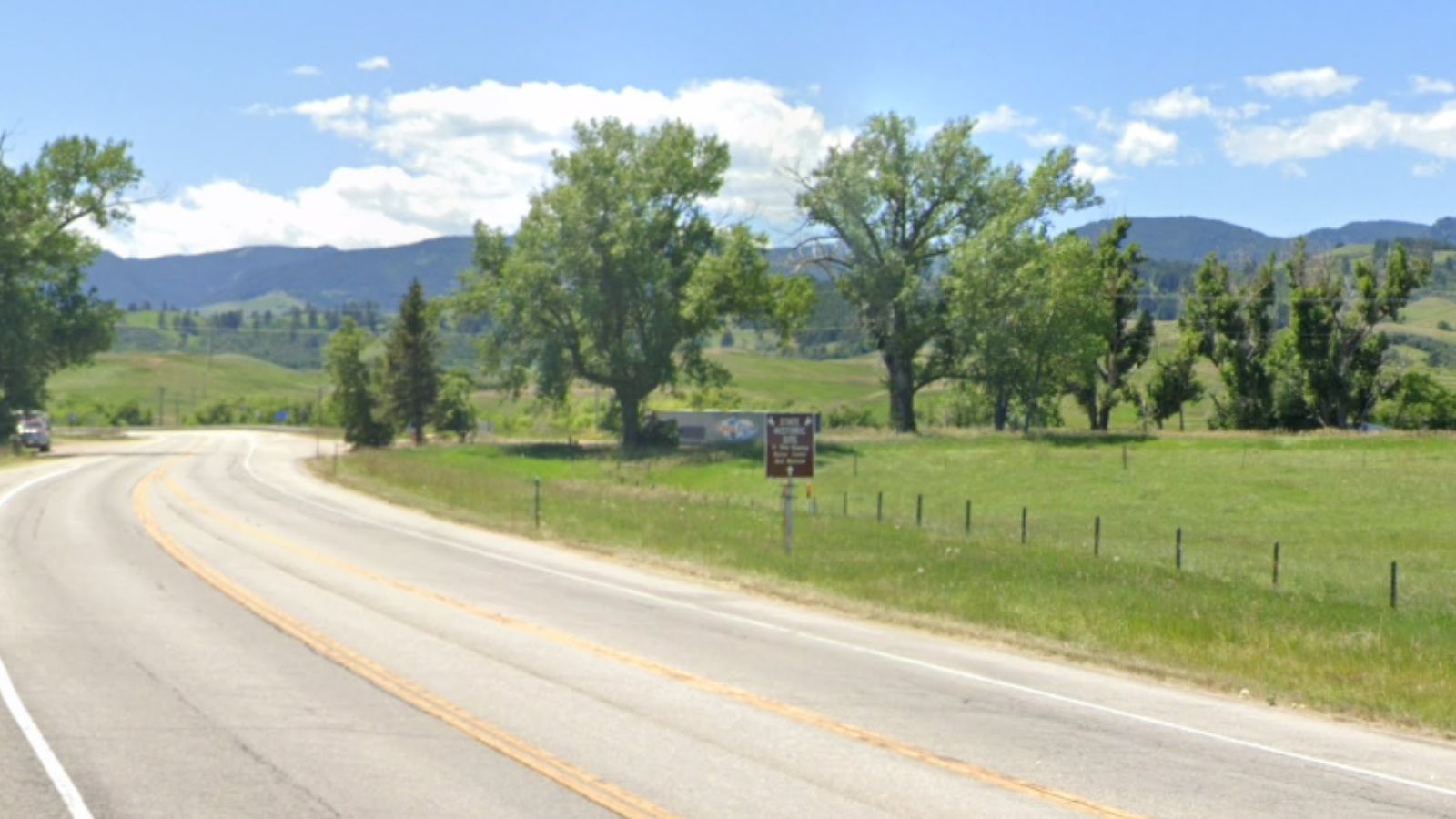
Why are people willing to pay so much to live here? What’s special about it?
Banner offers residents access to excellent hunting and fishing opportunities while maintaining rural character and proximity to energy sector employment in the Powder River Basin. The community provides wide-open spaces, agricultural heritage, and access to outdoor recreation in northeastern Wyoming’s grasslands and nearby mountain areas. Families value the area’s rural lifestyle, safety, and economic opportunities in both agriculture and energy sectors.
The town benefits from its location in prime hunting country and its proximity to major energy operations that provide employment opportunities. Property values reflect demand from outdoor enthusiasts and energy workers who want rural living with access to recreation and employment. The area’s natural beauty, hunting potential, and economic stability create consistent interest among buyers seeking rural lifestyle opportunities.
How Banner Rose to Prominence
Banner was established as a small ranching community in the early 1900s, serving the scattered homesteads and livestock operations in northeastern Wyoming’s grasslands. The community developed around cattle ranching and dry land farming, taking advantage of the vast open ranges and seasonal grazing opportunities. Its location provided access to both grazing lands and seasonal water sources essential for livestock operations.
The town’s character was shaped by its role in the regional livestock industry and its position as a supply center for area ranches. Banner became known for its authentic western atmosphere and its connection to traditional ranching practices. The community’s prominence grew with the development of energy resources in the region and the recognition of the area’s excellent hunting opportunities, particularly for antelope and other prairie game species.
3 Interesting Tidbits
1. Antelope Country – Banner sits in some of Wyoming’s best antelope hunting territory, with vast grasslands supporting healthy wildlife populations and excellent hunting opportunities.
2. Energy Hub – The community benefits from proximity to Powder River Basin energy development, including coal mining and oil and gas operations that provide employment opportunities.
3. Prairie Heritage – Banner maintains strong connections to traditional Great Plains ranching culture, with working cattle operations that preserve authentic western agricultural practices.
8. Cora – 60% Home Price Increase Since 2017
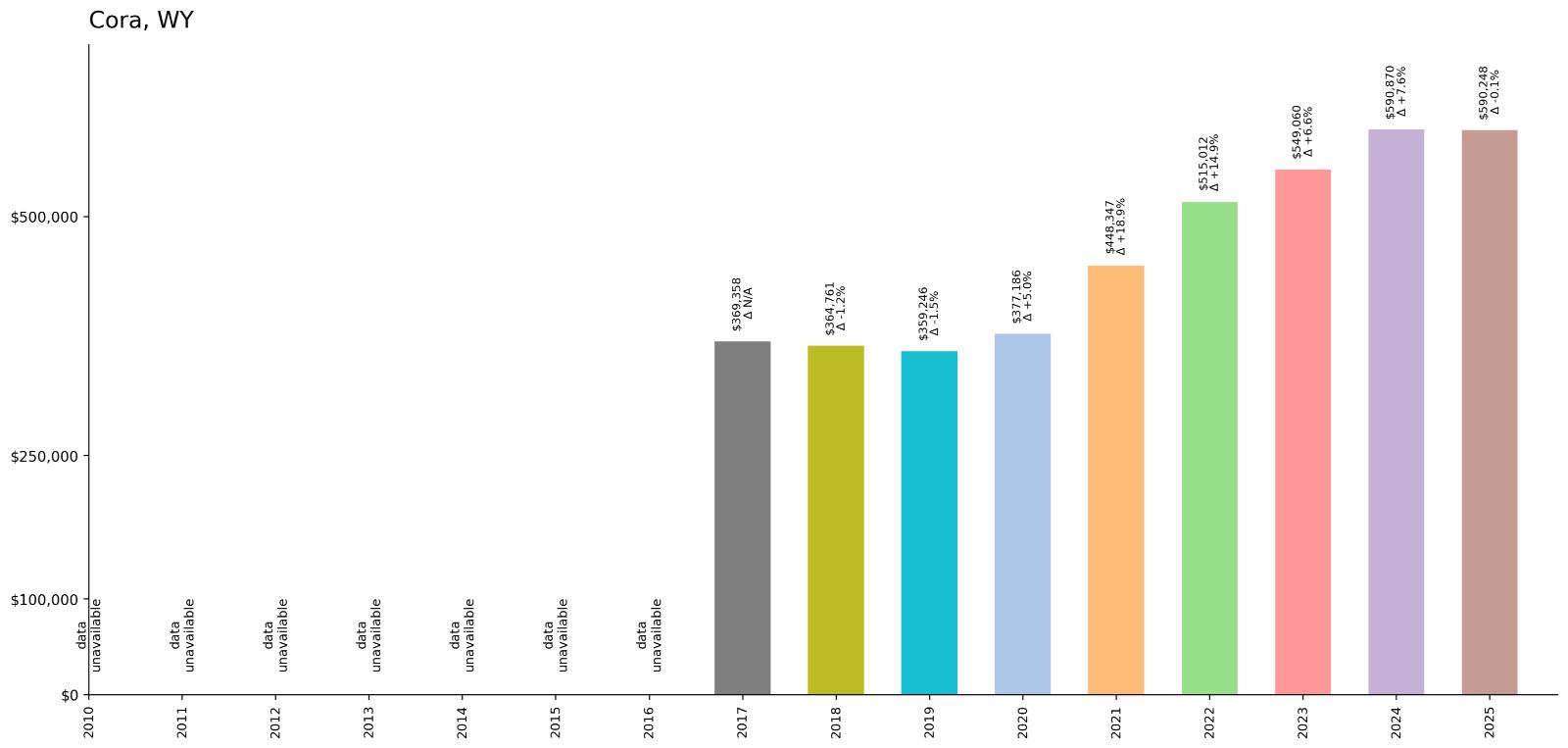
- 2010: N/A
- 2011: N/A
- 2012: N/A
- 2013: N/A
- 2014: N/A
- 2015: N/A
- 2016: N/A
- 2017: $369,358
- 2018: $364,761
- 2019: $359,246
- 2020: $377,186
- 2021: $448,347
- 2022: $515,012
- 2023: $549,060
- 2024: $590,870
- 2025: $590,248
Cora has experienced solid appreciation since 2017, growing from $369,358 to $590,248 despite some early volatility. The community showed strong acceleration after 2020, with values climbing from $377,186 to current levels approaching $590,000. This southwest Wyoming community has established itself among the state’s higher-priced mountain recreation areas.
Why Cora?
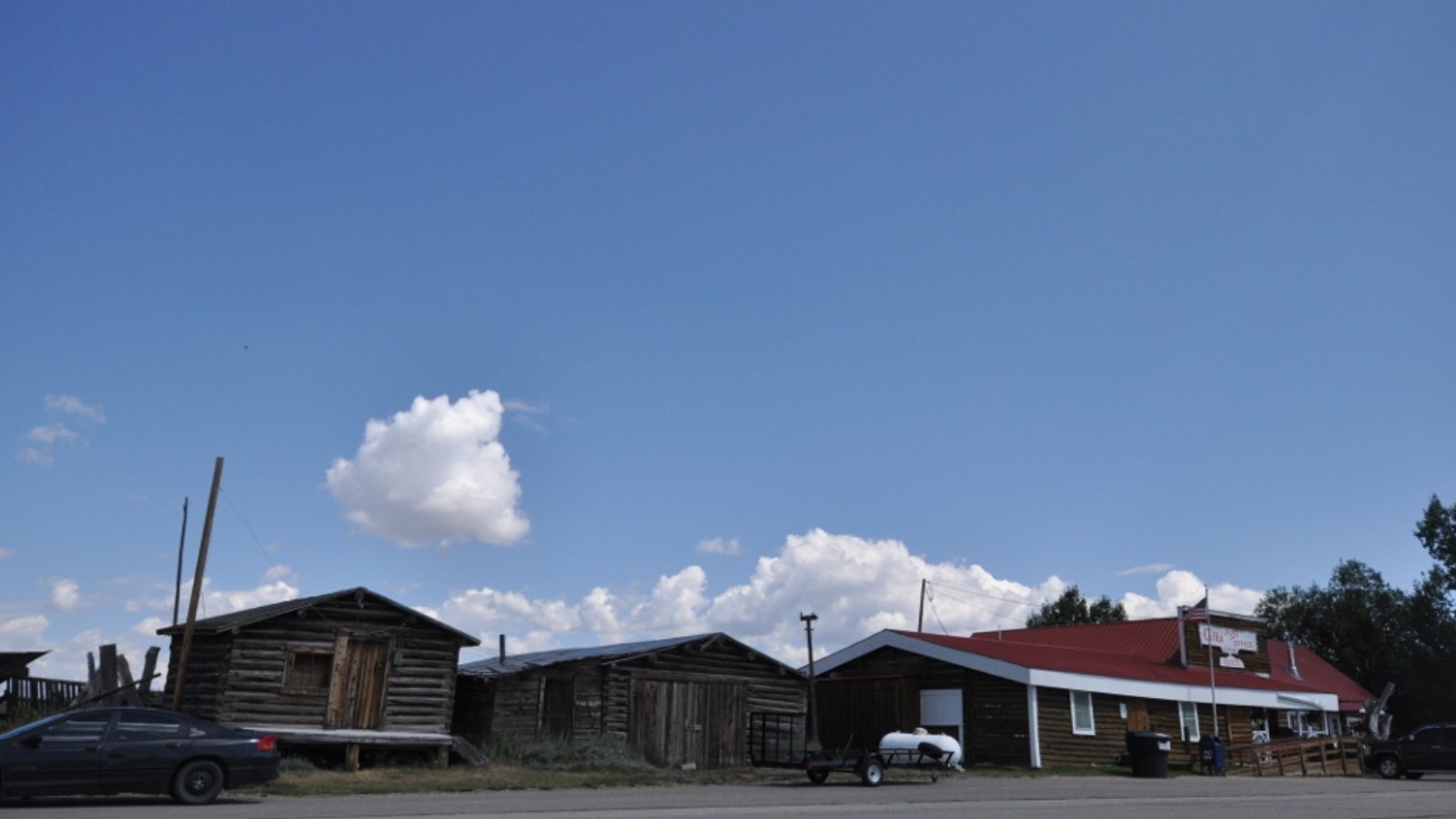
Why are people willing to pay so much to live here? What’s special about it?
Cora provides residents with immediate access to the Wind River Mountains and some of Wyoming’s most pristine wilderness areas while maintaining authentic western character. The community offers world-class fishing, hunting, hiking, and mountaineering opportunities with proximity to over 1,000 alpine lakes and extensive wilderness areas. Outdoor enthusiasts appreciate the area’s dramatic mountain scenery, recreation potential, and authentic western atmosphere.
The town benefits from its strategic location as a gateway to Wind River wilderness areas and its role as a supply center for outdoor recreation and guest ranch operations. Property values reflect strong demand from outdoor professionals, recreationists, and those seeking authentic mountain living experiences. The area’s natural beauty, recreation opportunities, and wilderness access create sustained appeal among buyers seeking premier mountain lifestyle opportunities.
How Cora Rose to Prominence
Cora was established in the early 1900s as a supply center for area ranches and logging operations in the upper Green River valley. The community developed around seasonal grazing operations and timber harvesting that took advantage of both valley lands and mountain resources. Its location at the base of the Wind River Mountains made it a natural staging area for mountain commerce and recreational activities.
The town’s prominence grew with the development of guest ranches and outfitting services that took advantage of the area’s exceptional outdoor recreation opportunities. Cora became known among outdoor enthusiasts for its access to pristine wilderness areas and world-class fishing and hunting. The community’s role as a recreation hub was enhanced by its authentic western character and the quality of outdoor opportunities in the surrounding Wind River Mountains.
3 Interesting Tidbits
1. Wind River Access – Cora serves as a primary gateway to the Wind River Range, providing access to over 600 miles of trails and some of the most pristine wilderness in the lower 48 states.
2. Alpine Lakes – The area provides access to over 1,000 alpine lakes in the Wind River Mountains, offering world-class fishing and backpacking opportunities.
3. Guest Ranch Heritage – Cora has long been home to working guest ranches that provide authentic western experiences while preserving traditional ranching culture and practices.
7. Clearmont – 87% Home Price Increase Since 2017
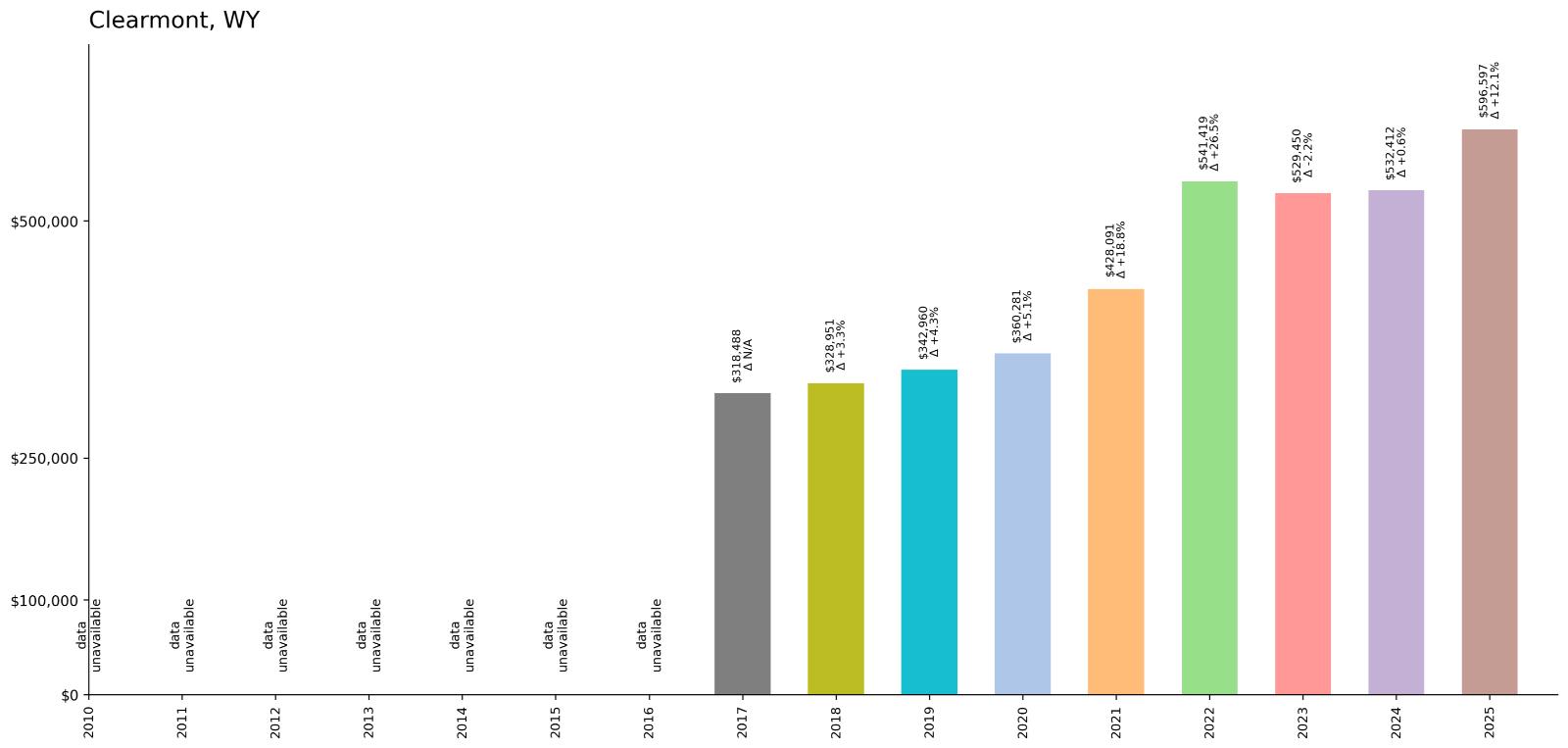
- 2010: N/A
- 2011: N/A
- 2012: N/A
- 2013: N/A
- 2014: N/A
- 2015: N/A
- 2016: N/A
- 2017: $318,488
- 2018: $328,951
- 2019: $342,960
- 2020: $360,281
- 2021: $428,091
- 2022: $541,419
- 2023: $529,450
- 2024: $532,412
- 2025: $596,597
Clearmont has shown remarkable appreciation since 2017, growing from $318,488 to $596,597. The community experienced steady growth through 2020 before accelerating dramatically, with the most significant jump occurring between 2021 and 2022. Current median prices approaching $597,000 reflect sustained demand in this northern Wyoming community near the Bighorn Mountains.
Why Clearmont?
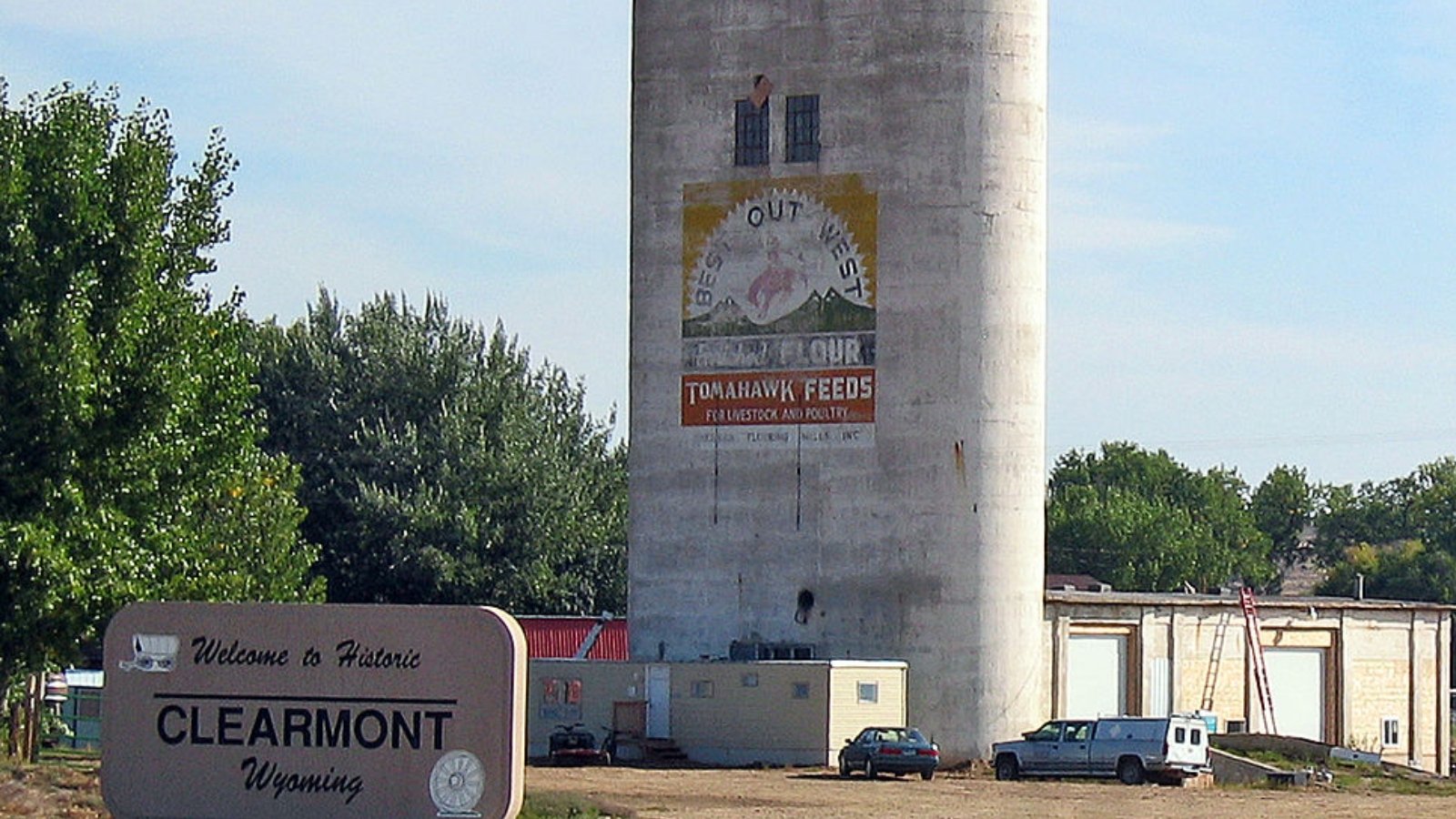
Why are people willing to pay so much to live here? What’s special about it?
Clearmont offers residents access to the Bighorn Mountains and extensive outdoor recreation opportunities while maintaining small-town character and proximity to regional employment centers. The community provides mountain living with excellent hunting, fishing, hiking, and winter sports access while preserving authentic western heritage. Families value the area’s natural beauty, outdoor opportunities, and strong community bonds in this scenic mountain setting.
The town benefits from its location at the base of the Bighorn Mountains and its position as a gateway to mountain recreation areas. Property values reflect strong demand from outdoor enthusiasts and mountain lifestyle seekers who want access to premier recreation with small-town character. The area’s natural beauty, recreation potential, and authentic western atmosphere create sustained interest among buyers seeking mountain living opportunities.
How Clearmont Rose to Prominence
Clearmont was established in the early 1900s as a supply center for area ranches and logging operations in the Bighorn Mountains. The community developed around livestock operations and timber harvesting that took advantage of both valley grazing lands and mountain forest resources. Its location made it a natural staging area for mountain commerce and seasonal grazing operations.
The town’s character was shaped by its role in the regional livestock and timber industries and its position as a gateway to the Bighorn Mountains. Clearmont became known for its authentic western atmosphere and its access to mountain recreation opportunities. The community’s prominence grew with the recognition of the area’s outdoor recreation potential and its appeal to those seeking mountain living with authentic western character.
3 Interesting Tidbits
1. Bighorn Gateway – Clearmont provides direct access to the Bighorn National Forest and serves as a base for exploring the eastern slopes of the Bighorn Mountains.
2. Historic Ranch Country – The area maintains working cattle ranches that preserve traditional western ranching practices and contribute to the community’s authentic character.
3. Mountain Recreation – Clearmont offers year-round outdoor recreation opportunities, with excellent hunting and fishing in summer and cross-country skiing and snowmobiling in winter.
6. Parkman – 75% Home Price Increase Since 2017
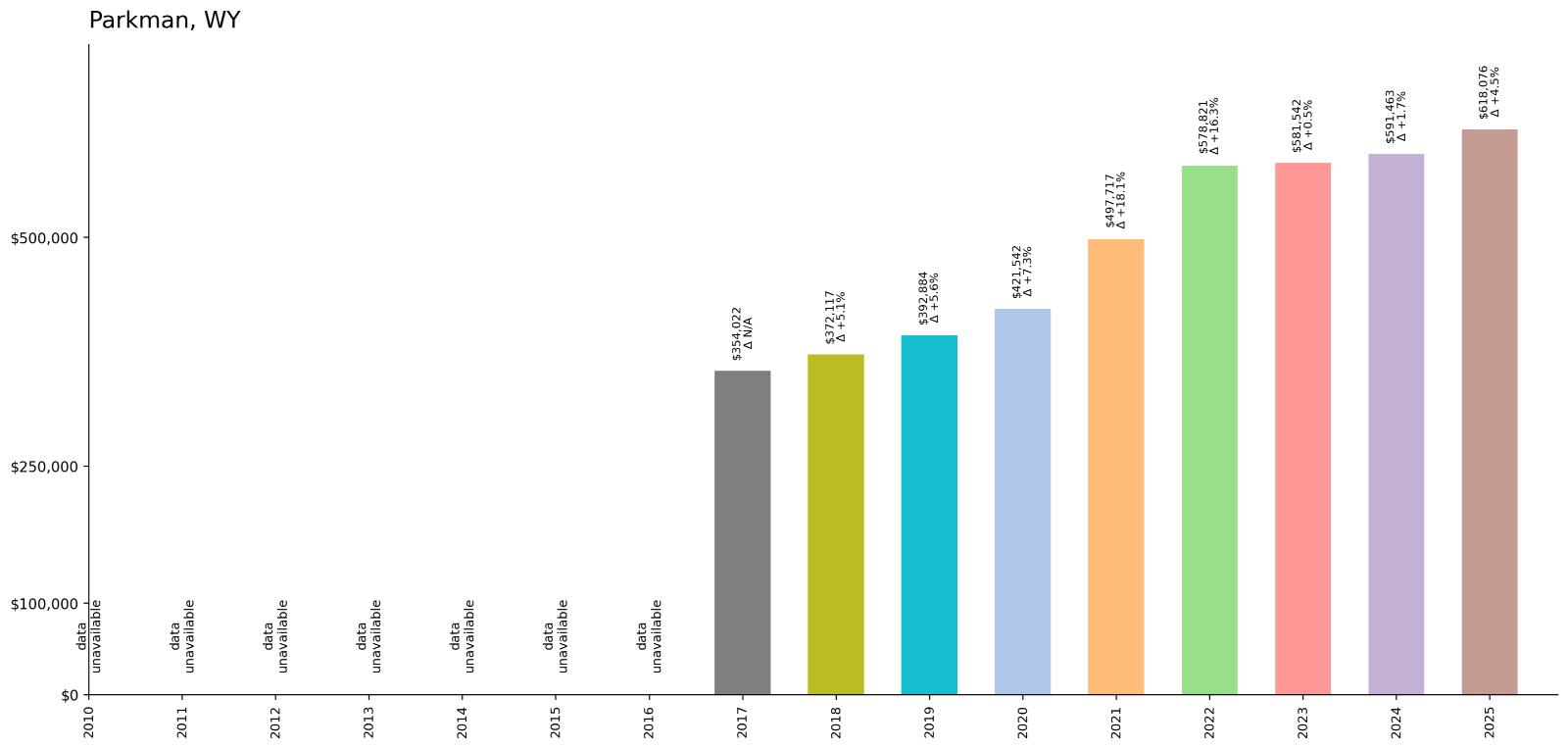
- 2010: N/A
- 2011: N/A
- 2012: N/A
- 2013: N/A
- 2014: N/A
- 2015: N/A
- 2016: N/A
- 2017: $354,022
- 2018: $372,117
- 2019: $392,884
- 2020: $421,542
- 2021: $497,717
- 2022: $578,821
- 2023: $581,542
- 2024: $591,463
- 2025: $618,076
Parkman has shown consistent appreciation since 2017, growing from $354,022 to $618,076. The community experienced steady growth through 2020 before accelerating dramatically, with particularly strong gains between 2021 and 2022. Current median prices above $618,000 place Parkman among Wyoming’s most expensive smaller communities.
Why Parkman?
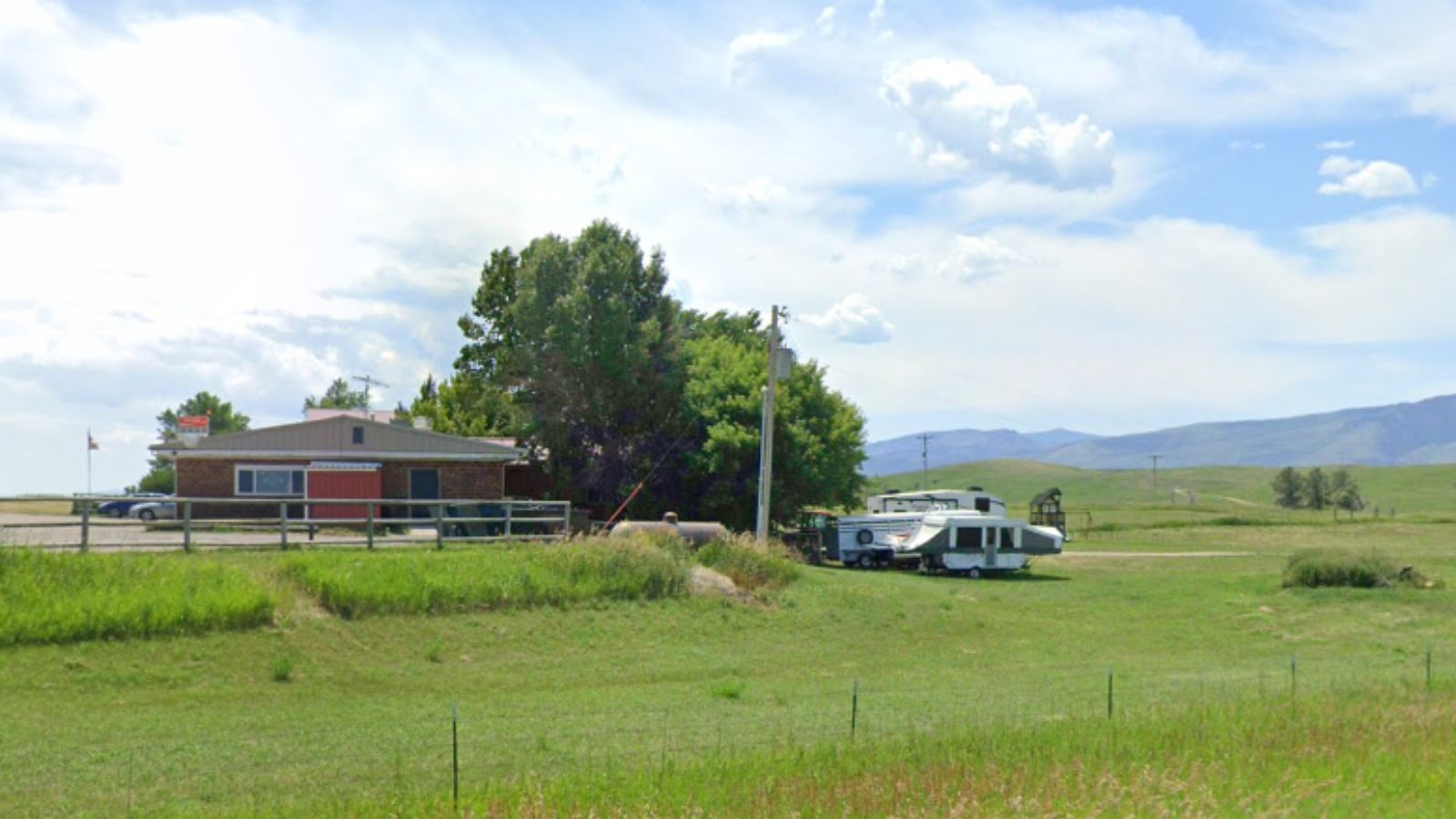
Why are people willing to pay so much to live here? What’s special about it?
Parkman offers residents access to the Bighorn Mountains and excellent outdoor recreation opportunities while maintaining rural character and proximity to regional employment centers. The community provides mountain living with world-class hunting, fishing, hiking, and scenic beauty while preserving small-town atmosphere and western heritage. Families value the area’s natural beauty, outdoor access, and authentic western lifestyle in this scenic mountain community.
The town benefits from its location near the Bighorn Mountains and its position as a gateway to mountain recreation areas and wilderness access. Property values reflect strong demand from outdoor enthusiasts and mountain lifestyle seekers who want premier recreation opportunities with rural character. The area’s natural beauty, recreation potential, and authentic mountain community atmosphere create sustained appeal among buyers seeking high-quality mountain living.
How Parkman Rose to Prominence
Parkman was established in the early 1900s as a supply center for area ranches and seasonal grazing operations in the foothills of the Bighorn Mountains. The community developed around livestock operations and dry land farming that took advantage of both valley lands and mountain meadows for seasonal grazing. Its location made it a natural staging area for mountain ranching operations and seasonal activities.
The town’s character was shaped by its role in the regional livestock industry and its position as a gateway to mountain grazing areas. Parkman became known for its authentic western atmosphere and its connection to traditional ranching practices in the Bighorn region. The community’s prominence grew with the recognition of the area’s outdoor recreation potential and its appeal to those seeking mountain living with authentic western heritage.
3 Interesting Tidbits
1. Mountain Ranching – Parkman maintains traditional mountain ranching operations that utilize both valley lands and high-country meadows for seasonal grazing activities.
2. Bighorn Access – The community provides excellent access to the Bighorn Mountains for hunting, fishing, hiking, and other outdoor recreation activities in pristine mountain environments.
3. Historic Cattle Trails – The area includes historic cattle trails that connected valley ranches with mountain grazing areas, preserving important western heritage and ranching history.
5. Alpine – 5% Home Price Increase Since 2023
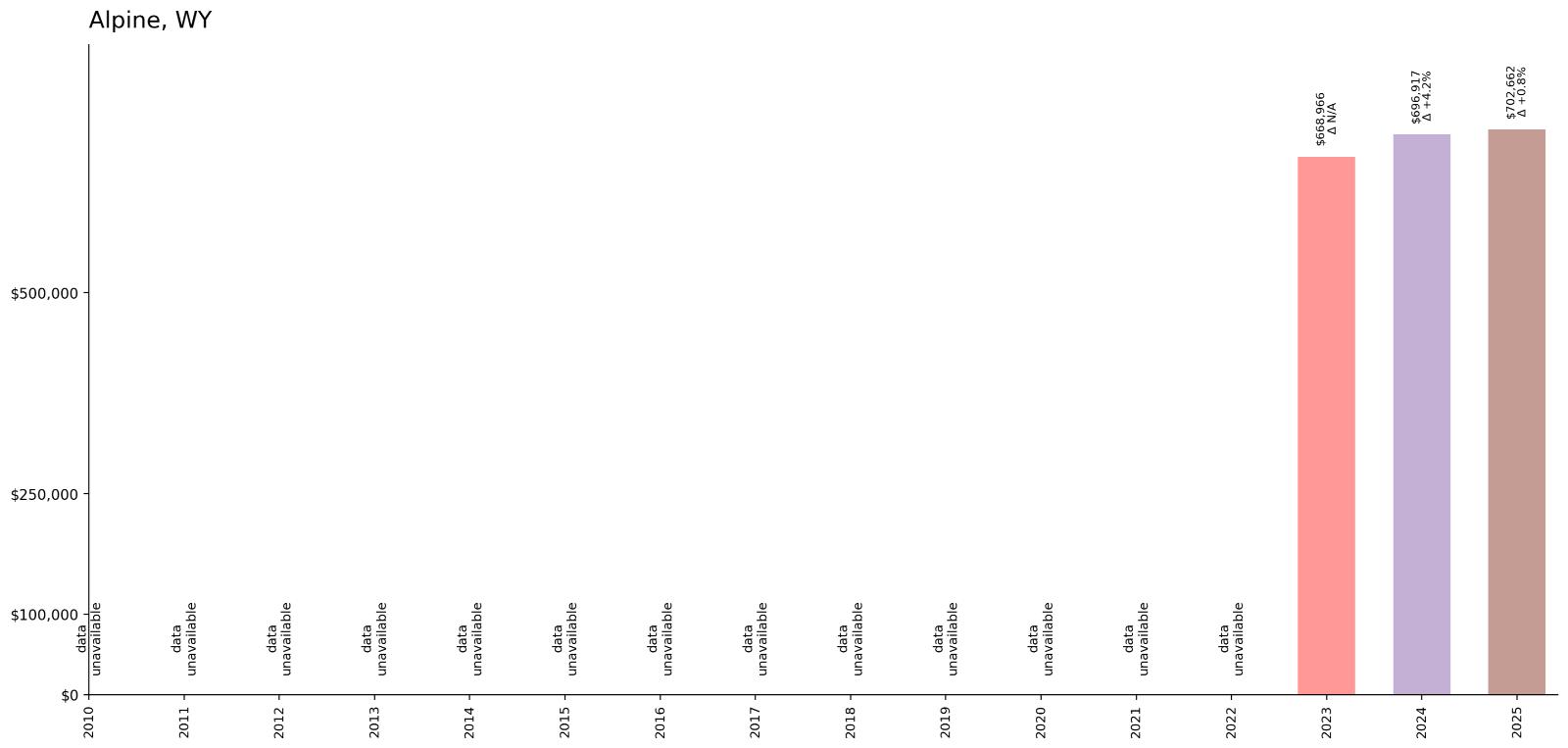
- 2010: N/A
- 2011: N/A
- 2012: N/A
- 2013: N/A
- 2014: N/A
- 2015: N/A
- 2016: N/A
- 2017: N/A
- 2018: N/A
- 2019: N/A
- 2020: N/A
- 2021: N/A
- 2022: N/A
- 2023: $668,966
- 2024: $696,917
- 2025: $702,662
Alpine shows limited data availability but demonstrates steady recent growth from $668,966 in 2023 to $702,662 in 2025. Though the percentage increase appears modest at 5% since 2023, the current median home price above $702,000 places Alpine among Wyoming’s most expensive communities in the scenic Star Valley region.
Why Alpine?

Why are people willing to pay so much to live here? What’s special about it?
Alpine sits at the southern end of scenic Star Valley, offering residents mountain living with access to world-class skiing, fishing, and outdoor recreation while maintaining proximity to Jackson Hole employment markets. The community provides alpine atmosphere with four-season recreation opportunities and stunning mountain scenery in all directions. Families value the area’s natural beauty, recreation access, and mountain community character with reasonable access to larger employment centers.
The town benefits from its strategic location between Star Valley and Jackson Hole, creating access to diverse recreation opportunities and employment markets. Property values reflect strong demand from outdoor enthusiasts and professionals who want mountain living with excellent recreation access and proximity to major resort areas. The area’s natural beauty, recreation potential, and valley atmosphere create sustained interest among mountain lifestyle seekers.
How Alpine Rose to Prominence
Alpine was established in the late 1800s by Mormon pioneers who recognized the agricultural potential of Star Valley’s southern reaches and the natural beauty of the surrounding mountains. The community developed as a farming and ranching center that took advantage of the valley’s fertile lands and mountain water sources. Its location at the confluence of major valleys made it a natural crossroads for regional commerce and travel.
The town’s prominence grew with the development of tourism and recreation that took advantage of the area’s proximity to Jackson Hole and the spectacular mountain scenery of Star Valley. Alpine became known for its access to world-class fishing on the Snake River and its position as a gateway to multiple recreation areas. The community’s role as a recreation hub was enhanced by its scenic mountain setting and its connection to both Star Valley and Jackson Hole markets.
3 Interesting Tidbits
1. Snake River Junction – Alpine sits at the confluence of the Snake River and Greys River, providing access to some of Wyoming’s most productive fishing waters and scenic floating opportunities.
2. Star Valley Gateway – The community serves as the southern gateway to Star Valley, one of Wyoming’s most scenic agricultural valleys surrounded by mountain ranges on all sides.
3. Jackson Proximity – Alpine provides more affordable mountain living while maintaining reasonable access to Jackson Hole’s employment opportunities and world-class amenities.
4. Moran – 125% Home Price Increase Since 2016
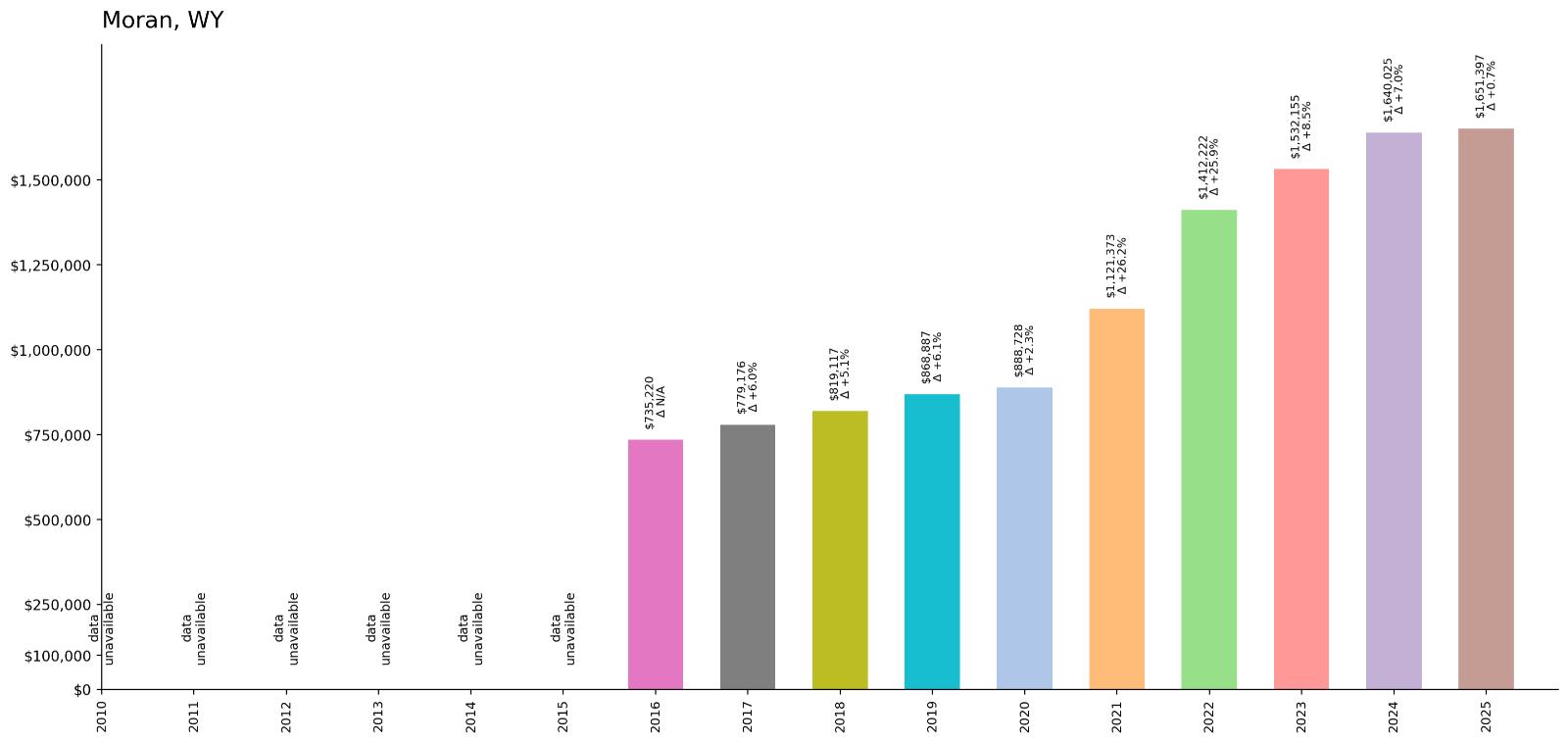
- 2010: N/A
- 2011: N/A
- 2012: N/A
- 2013: N/A
- 2014: N/A
- 2015: N/A
- 2016: $735,220
- 2017: $779,176
- 2018: $819,117
- 2019: $868,887
- 2020: $888,728
- 2021: $1,121,373
- 2022: $1,412,222
- 2023: $1,532,155
- 2024: $1,640,025
- 2025: $1,651,397
Moran has more than doubled in value since 2016, showing dramatic acceleration throughout the period. Values climbed from $735,220 in 2016 to over $1.65 million in 2025, with particularly strong gains between 2021 and 2023. Current median prices above $1.65 million reflect the premium market for luxury mountain properties near Grand Teton National Park.
Why Moran?

Why are people willing to pay so much to live here? What’s special about it?
Moran provides residents with immediate access to Grand Teton National Park and Yellowstone while offering luxury mountain living in one of America’s most spectacular settings. The community features exclusive properties with unparalleled mountain views, world-class fishing and hunting access, and proximity to Jackson Hole’s amenities. High-net-worth buyers appreciate the area’s privacy, natural beauty, and access to premier outdoor recreation in a truly pristine mountain environment.
The town benefits from its strategic location at the entrance to Grand Teton National Park and its position as a gateway to both Yellowstone and Jackson Hole. Property values reflect demand from luxury buyers seeking exclusive mountain properties with unparalleled access to national parks and outdoor recreation. The area’s natural beauty, recreation opportunities, and exclusivity create sustained demand among buyers seeking the finest mountain living experiences available.
How Moran Rose to Prominence
Moran was established in the early 1900s as a supply center and transportation hub at the junction of roads leading to Yellowstone and Jackson Lake. The community developed around tourism services and guest ranch operations that took advantage of the area’s spectacular mountain scenery and proximity to Yellowstone National Park. Its location made it a natural stopping point for early park visitors and mountain travelers.
The town’s prominence grew with the establishment of Grand Teton National Park in 1929 and the development of luxury guest ranches and exclusive properties that catered to wealthy visitors seeking pristine mountain experiences. Moran became known for its access to world-class fishing and hunting and its position as a gateway to some of America’s most spectacular national park scenery. The community’s role as a luxury destination was enhanced by its exclusive character and the quality of properties available in this pristine mountain setting.
3 Interesting Tidbits
1. Park Gateway – Moran sits at the entrance to Grand Teton National Park, providing residents with immediate access to some of America’s most spectacular mountain scenery and recreation opportunities.
2. Luxury Ranches – The area is home to some of Wyoming’s most exclusive guest ranches and private properties, attracting high-net-worth individuals seeking pristine mountain living.
3. Jackson Lake Access – Moran provides access to Jackson Lake and the Snake River, offering world-class fishing, boating, and water recreation in a spectacular mountain setting.
3. Alta – 120% Home Price Increase Since 2016

- 2010: N/A
- 2011: N/A
- 2012: N/A
- 2013: N/A
- 2014: N/A
- 2015: N/A
- 2016: $839,022
- 2017: $875,659
- 2018: $915,686
- 2019: $921,151
- 2020: $989,640
- 2021: $1,248,841
- 2022: $1,563,810
- 2023: $1,725,961
- 2024: $1,939,400
- 2025: $1,847,811
Alta has more than doubled in value since 2016, showing dramatic growth from $839,022 to current levels near $1.85 million. The community experienced steady appreciation through 2020 before accelerating rapidly, with particularly strong gains through 2024. Despite a slight decline in 2025, median prices near $1.85 million place Alta among Wyoming’s most expensive luxury mountain communities.
Why Alta?

Why are people willing to pay so much to live here? What’s special about it?
Alta offers residents world-class skiing at Grand Targhee Resort while providing exclusive mountain living in Teton County with spectacular views and pristine alpine environment. The community features luxury properties with immediate access to powder skiing, summer recreation, and some of the most dramatic mountain scenery in North America. High-end buyers appreciate the area’s exclusivity, natural beauty, and access to premier skiing and outdoor recreation in a truly spectacular mountain setting.
The town benefits from its location near Grand Targhee Resort and its position on the western slopes of the Teton Range, providing unparalleled access to powder skiing and mountain recreation. Property values reflect demand from luxury buyers seeking exclusive ski-in, ski-out properties with world-class recreation access and dramatic mountain views. The area’s natural beauty, recreation opportunities, and exclusivity create sustained demand among affluent buyers seeking the finest mountain living experiences.
How Alta Rose to Prominence
Alta developed in the mid-20th century as skiing gained popularity in the Teton region, with early development focused on providing access to the area’s legendary powder snow and mountain terrain. The community grew around the establishment of Grand Targhee Resort and the recognition of the western Teton slopes as world-class skiing territory. Its location provided ideal conditions for both downhill skiing and summer mountain recreation.
The town’s prominence grew with the development of luxury properties and exclusive residential communities that took advantage of the area’s spectacular mountain views and recreation opportunities. Alta became known among skiing and outdoor enthusiasts for its access to unparalleled powder snow and pristine mountain environment. The community’s role as a luxury destination was enhanced by its exclusive character and the quality of skiing and recreation opportunities available in this spectacular alpine setting.
3 Interesting Tidbits
1. Powder Paradise – Alta provides access to Grand Targhee Resort, famous for receiving over 500 inches of light, dry powder snow annually, creating world-class skiing conditions.
2. Teton Views – The community offers spectacular views of the Teton Range from the western slopes, providing some of the most dramatic mountain vistas available in the region.
3. Summer Recreation – Beyond skiing, Alta provides access to exceptional summer recreation including mountain biking, hiking, and wildflower viewing in pristine alpine environments.
2. Jackson – 245% Home Price Increase Since 2010
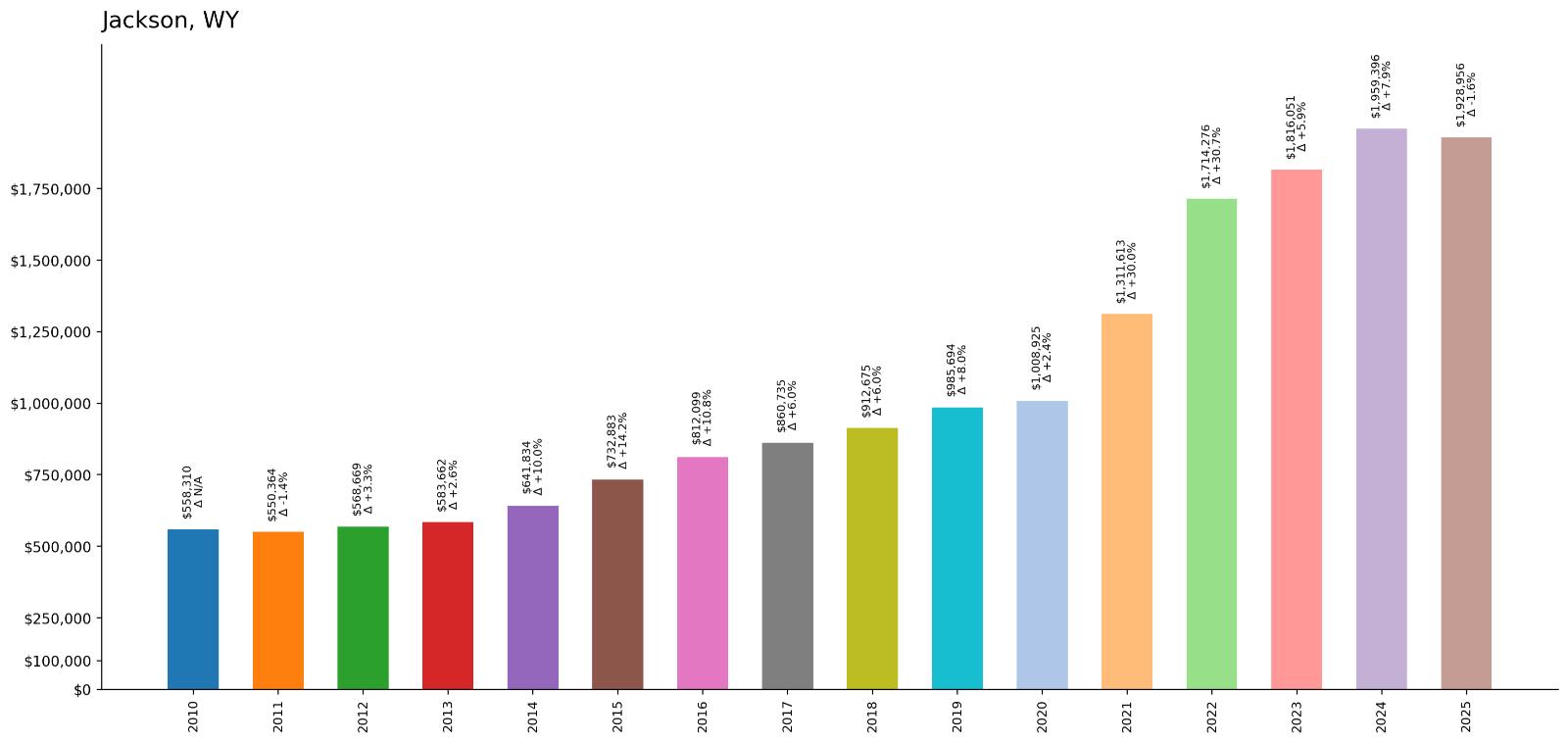
- 2010: $558,310
- 2011: $550,364
- 2012: $568,669
- 2013: $583,662
- 2014: $641,834
- 2015: $732,883
- 2016: $812,099
- 2017: $860,735
- 2018: $912,675
- 2019: $985,694
- 2020: $1,008,925
- 2021: $1,311,613
- 2022: $1,714,276
- 2023: $1,816,051
- 2024: $1,959,396
- 2025: $1,928,956
Jackson has experienced extraordinary growth since 2010, with values climbing from $558,310 to nearly $1.93 million. The community showed consistent appreciation through 2020 before accelerating dramatically during the pandemic years, with particularly strong gains between 2021 and 2024. Despite a slight decline in 2025, median prices approaching $1.93 million cement Jackson’s position as Wyoming’s premier luxury resort destination.
Why Jackson?
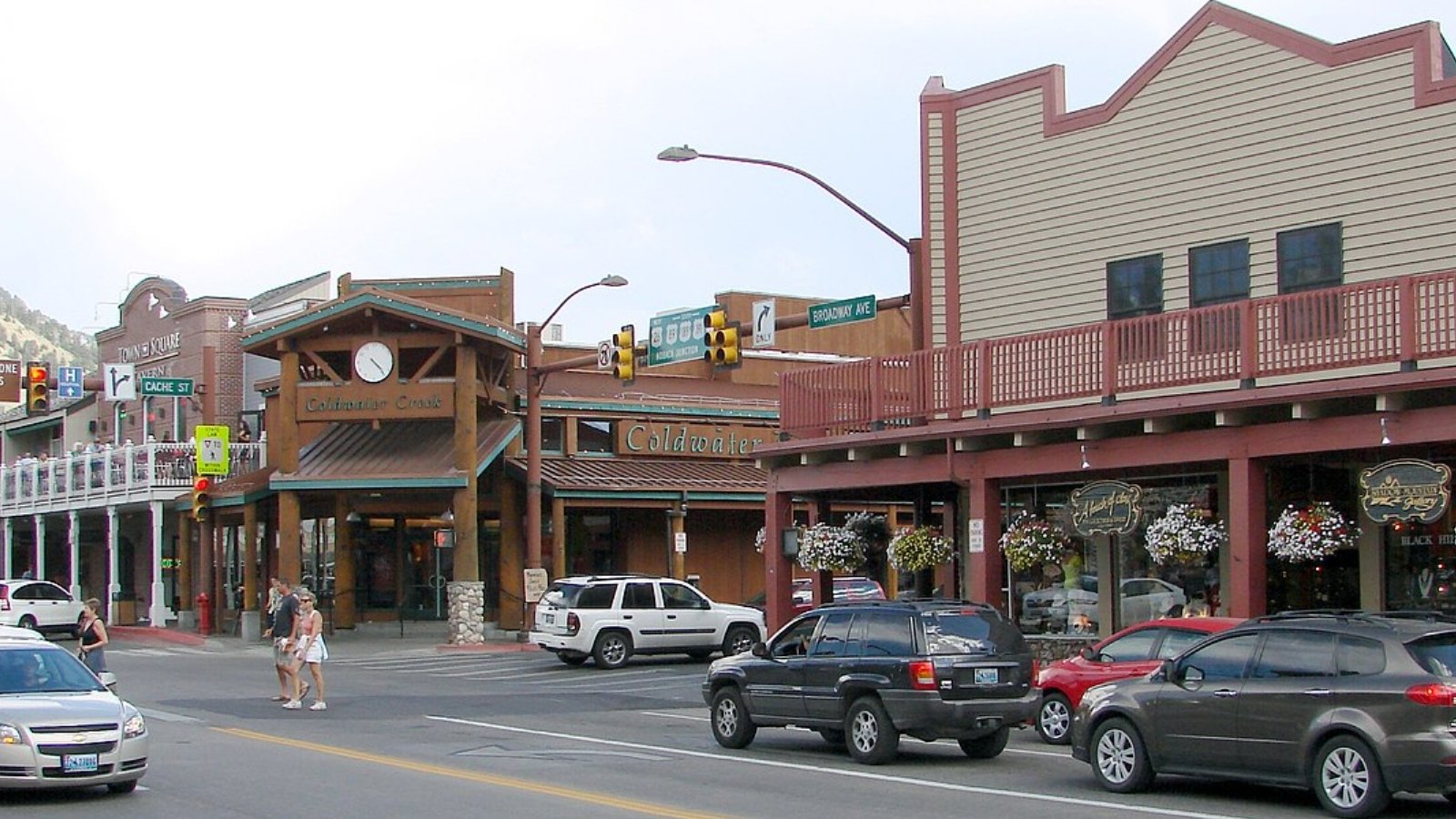
Why are people willing to pay so much to live here? What’s special about it?
Jackson offers residents world-class skiing at Jackson Hole Mountain Resort while providing luxury mountain living with immediate access to Grand Teton and Yellowstone National Parks. The community features premium amenities, fine dining, cultural attractions, and some of the most spectacular mountain scenery in North America. High-net-worth buyers appreciate the area’s combination of luxury amenities, outdoor recreation, and exclusive mountain lifestyle opportunities in a truly world-class destination.
The town benefits from its position as one of America’s premier resort destinations, with year-round tourism and recreation driving both economy and real estate demand. Property values reflect strong demand from luxury buyers seeking exclusive access to world-class skiing, national parks, and premium mountain living amenities. The area’s natural beauty, recreation opportunities, luxury amenities, and international recognition create sustained demand among affluent buyers seeking the finest mountain lifestyle experiences available.
How Jackson Rose to Prominence
Jackson was established in the 1890s as a supply center for area ranches and homesteads in the Jackson Hole valley, serving the needs of early settlers who recognized the valley’s agricultural potential despite its challenging mountain environment. The community developed around cattle ranching and dude ranch operations that took advantage of the area’s spectacular scenery to attract eastern visitors seeking authentic western experiences.
The town’s transformation into a world-class resort destination began with the establishment of Grand Teton National Park in 1929 and accelerated with the development of Jackson Hole Mountain Resort in the 1960s. Jackson became internationally known for its combination of world-class skiing, national park access, and luxury amenities that attracted celebrities, business leaders, and outdoor enthusiasts from around the world. The community’s evolution into a premier destination was driven by its unique combination of natural beauty, recreation opportunities, and luxury amenities unavailable elsewhere.
3 Interesting Tidbits
1. Ski Resort Fame – Jackson Hole Mountain Resort is home to Corbet’s Couloir, one of the most famous and challenging ski runs in North America, attracting expert skiers from around the world.
2. Elk Refuge – The National Elk Refuge provides winter habitat for thousands of elk and offers sleigh rides that have become an iconic Jackson experience for over a century.
3. Celebrity Haven – Jackson has become home to numerous celebrities and business leaders who value the area’s natural beauty, privacy, and world-class amenities in a spectacular mountain setting.
1. Wilson – 232% Home Price Increase Since 2010

- 2010: $921,701
- 2011: $858,174
- 2012: $926,590
- 2013: $982,033
- 2014: $1,097,851
- 2015: $1,244,657
- 2016: $1,295,143
- 2017: $1,381,512
- 2018: $1,443,074
- 2019: $1,602,702
- 2020: $1,646,693
- 2021: $2,128,831
- 2022: $2,718,307
- 2023: $2,794,512
- 2024: $3,064,396
- 2025: $3,061,412
Wilson stands as Wyoming’s most expensive community, with values climbing from $921,701 in 2010 to over $3.06 million in 2025. The community showed steady appreciation through 2020 before accelerating dramatically during the pandemic years, with particularly explosive growth between 2021 and 2024. Current median prices above $3.06 million reflect Wilson’s position as the ultimate luxury mountain community in the Jackson Hole area.
Why Wilson?
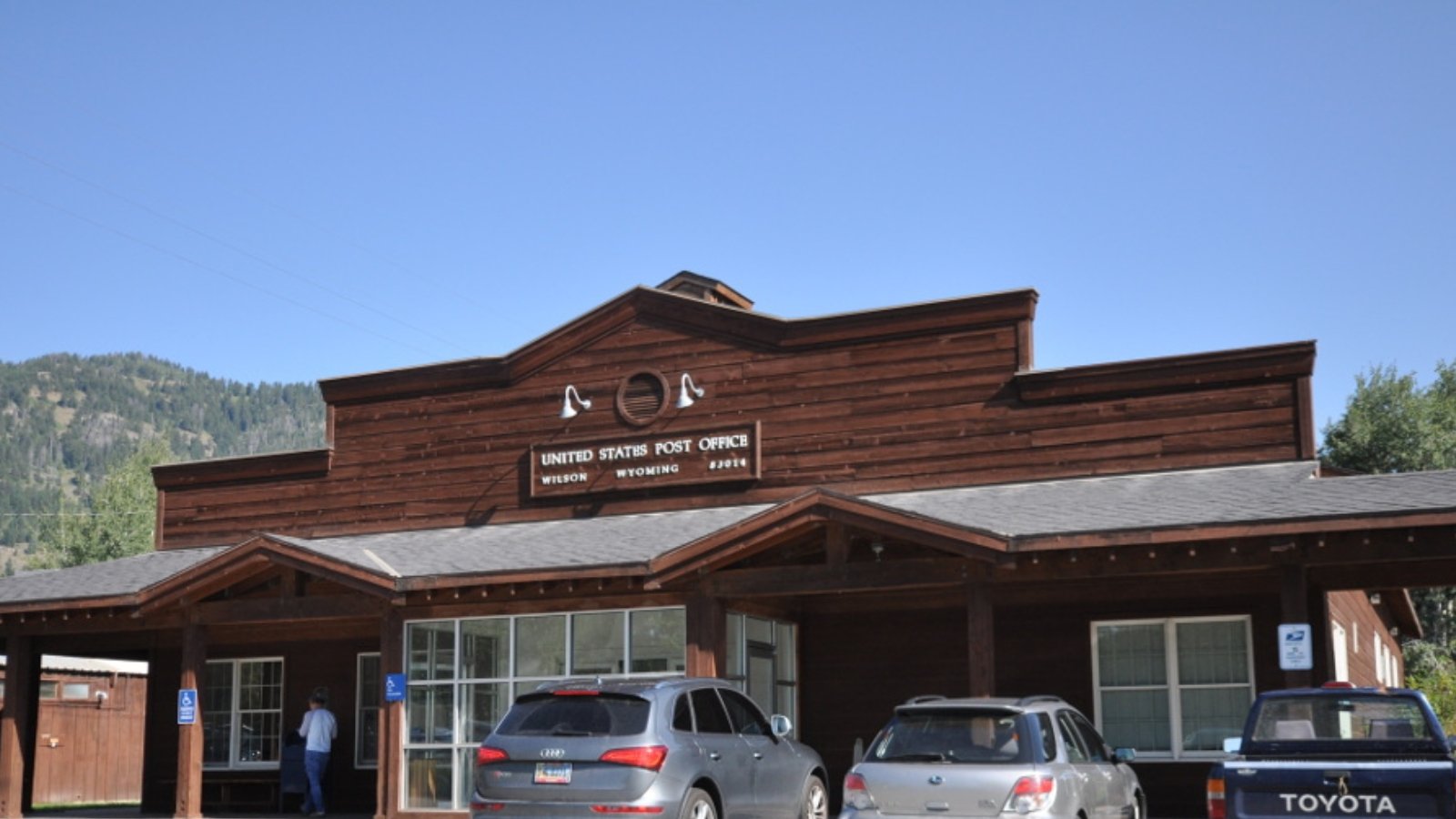
Why are people willing to pay so much to live here? What’s special about it?
Wilson represents the pinnacle of luxury mountain living, offering residents exclusive properties with dramatic Teton views while maintaining proximity to Jackson’s world-class amenities and recreation opportunities. The community features the most prestigious addresses in Jackson Hole, with luxury estates, privacy, and immediate access to world-class skiing, national parks, and outdoor recreation. Ultra-high-net-worth buyers appreciate Wilson’s exclusivity, spectacular mountain scenery, and position as the most desirable residential area in one of America’s premier resort destinations.
The town benefits from its reputation as Jackson Hole’s most exclusive residential community, with limited development and premium properties that command the highest prices in Wyoming. Property values reflect extraordinary demand from luxury buyers seeking the finest mountain living experiences with unparalleled access to recreation, natural beauty, and exclusive amenities. The area’s combination of dramatic scenery, luxury properties, exclusivity, and proximity to world-class resort amenities creates sustained demand among the most affluent buyers seeking premier mountain lifestyle opportunities.
How Wilson Rose to Prominence
Wilson began as a small farming community in the early 1900s, established by homesteaders who recognized the agricultural potential of the Jackson Hole valley’s fertile lands. The area developed around small farms and ranches that took advantage of the valley’s natural irrigation and growing season, despite the challenging mountain environment. Its location provided both agricultural opportunity and spectacular mountain scenery that would later drive its transformation.
The community’s evolution into Wyoming’s most exclusive residential area began with the recognition of Jackson Hole as a world-class destination and the development of luxury properties that took advantage of the area’s spectacular Teton views and proximity to premier recreation. Wilson became the preferred location for the most prestigious properties in Jackson Hole, attracting celebrities, business leaders, and ultra-high-net-worth individuals seeking the finest mountain living experiences. The community’s prominence as the ultimate luxury destination was driven by its combination of exclusivity, natural beauty, and access to world-class amenities unavailable elsewhere in Wyoming.
3 Interesting Tidbits
1. Teton Views – Wilson properties offer some of the most spectacular and unobstructed views of the Teton Range available anywhere, with luxury estates positioned to maximize these dramatic mountain vistas.
2. Celebrity Enclave – Wilson has become home to numerous A-list celebrities, tech billionaires, and business moguls who value the area’s privacy, natural beauty, and world-class amenities.
3. Agricultural Heritage – Despite its current luxury status, Wilson maintains working ranches and agricultural operations that preserve the area’s western heritage while providing authentic mountain living experiences.






